December
Impact 2011
12/16/2011 Source: Office of Communication Services, CTAHR 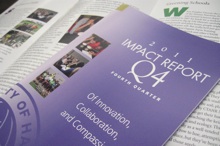 The 4th
Quarter Impact Report is now available online, offering interested readers
highlights of USDA Under Secretary Woteki’s visit, the termite-centric Educate
to Eradicate program in schools, and the green vision of the student group
SOFT. Take a well-deserved break and catch up on what colleagues are doing in
the college! The 4th
Quarter Impact Report is now available online, offering interested readers
highlights of USDA Under Secretary Woteki’s visit, the termite-centric Educate
to Eradicate program in schools, and the green vision of the student group
SOFT. Take a well-deserved break and catch up on what colleagues are doing in
the college!
|
Crunch and Munch
12/16/2011 Source: Office of Communication Services, CTAHR 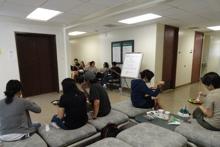 On the
last day of classes of the 2011 Fall semester, CTAHR students were able to
celebrate the end of their courses and prepare themselves for finals week with
some comfort food at the first-ever CTAHR Finals Crunch Munch. Upon entering
the Agricultural Science building, students were greeted by the wafting scents
of freshly made chili, cornbread, and chocolate chip cookies. They were also able
to pick up finals survival kits, chock-full of essentials including “stress
relief capsules,” tea bags, and other edible treats. Students left content
after the hearty meal, ready to hit the books. Special thanks to Chef Mark and
his students for preparing the delicious and filling meal. Thanks are due as
well to Douglas Vincent, the HNFAS staff, and the ASAO for supporting this
event. On the
last day of classes of the 2011 Fall semester, CTAHR students were able to
celebrate the end of their courses and prepare themselves for finals week with
some comfort food at the first-ever CTAHR Finals Crunch Munch. Upon entering
the Agricultural Science building, students were greeted by the wafting scents
of freshly made chili, cornbread, and chocolate chip cookies. They were also able
to pick up finals survival kits, chock-full of essentials including “stress
relief capsules,” tea bags, and other edible treats. Students left content
after the hearty meal, ready to hit the books. Special thanks to Chef Mark and
his students for preparing the delicious and filling meal. Thanks are due as
well to Douglas Vincent, the HNFAS staff, and the ASAO for supporting this
event.
|
Red Splendor
12/16/2011 Source: Office of Communication Services, CTAHR 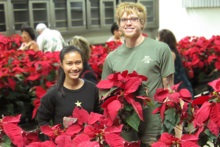 TPSS’s Horticultural Society held its annual poinsettia sale last week, a highly anticipated seasonal event for those who want to surround themselves with leafy holiday cheer and vibrant color. Those who need help keeping their poinsettias as healthy as when they triumphantly bore them home should also check out the publication Care of Potted Poinsettias by Jayme Grzebik (TPSS) and Edwin Mersino (PEPS) for some helpful advice: for instance, did you know that at times during their life cycle they should be kept in a light-proof box or closet at least 12 hours a day? TPSS’s Horticultural Society held its annual poinsettia sale last week, a highly anticipated seasonal event for those who want to surround themselves with leafy holiday cheer and vibrant color. Those who need help keeping their poinsettias as healthy as when they triumphantly bore them home should also check out the publication Care of Potted Poinsettias by Jayme Grzebik (TPSS) and Edwin Mersino (PEPS) for some helpful advice: for instance, did you know that at times during their life cycle they should be kept in a light-proof box or closet at least 12 hours a day?
|
Nalo Kalikimaka
12/16/2011 Source: Office of Communication Services, CTAHR 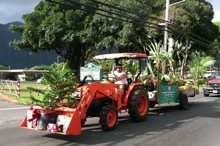 Ken Leonhardt and Ted Radovich (both TPSS) organized a colorful and festive entry on behalf of CTAHR in the Waimanalo Christmas Parade on Dec. 10. First came the venerable Model T Ford, carrying a decorated Norfolk pine as well as helpful volunteers tossing candy to the crowd. Next were the tractor and trailer, laden with potted papaya, coffee, banana, taro, sugarcane, and other crops representative of CTAHR, borrowed from several generous Waimanalo nurseries. It, too, had a decorated Norfolk pine in the tractor bucket. Last came Roger Corrales (farm manager, Waimanalo Research Station) in his red truck, carrying Skip Bittenbender (TPSS), who played rock ’n’ roll Christmas songs on his guitar to add to the lively and merry atmosphere. Community outreach, good publicity, good fun, and Christmas spirit—what could be better? Ken Leonhardt and Ted Radovich (both TPSS) organized a colorful and festive entry on behalf of CTAHR in the Waimanalo Christmas Parade on Dec. 10. First came the venerable Model T Ford, carrying a decorated Norfolk pine as well as helpful volunteers tossing candy to the crowd. Next were the tractor and trailer, laden with potted papaya, coffee, banana, taro, sugarcane, and other crops representative of CTAHR, borrowed from several generous Waimanalo nurseries. It, too, had a decorated Norfolk pine in the tractor bucket. Last came Roger Corrales (farm manager, Waimanalo Research Station) in his red truck, carrying Skip Bittenbender (TPSS), who played rock ’n’ roll Christmas songs on his guitar to add to the lively and merry atmosphere. Community outreach, good publicity, good fun, and Christmas spirit—what could be better?
|
Harvesting Tomatoes and Thanks
12/16/2011 Source: Office of Communication Services, CTAHR 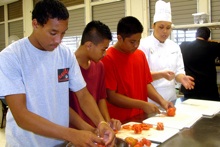 Jari Sugano (PEPS) is head
of the team that for the past year has been conducting field trials of tomato
to screen for resistance to debilitating pests TYLCV and TSW. The Poamoho
Research station crew and volunteers, including a number of retired CTAHR faculty and staff, have been instrumental
in helping to harvest tomatoes week after week. For the most part, after being
evaluated the tomatoes were being used as pig feed, but then the team decided
to try something different. The week before the Thanksgiving holiday, they sent
off 166 red and glistening pounds to the Hawaii Food Bank, which turned out so
successfully that more donations are planned for the next set of trials.
Another load of tomatoes was donated to Farrington High School by Rose Saito and the
4-H program. Here they were used by the Farrington Culinary Academy’s chef instructor Tracy Hatanaka
and her 75 students, who wrote a grateful thank-you letter for the opportunity
to practice hands-on skills of blanching and cutting the fruit. Jari Sugano (PEPS) is head
of the team that for the past year has been conducting field trials of tomato
to screen for resistance to debilitating pests TYLCV and TSW. The Poamoho
Research station crew and volunteers, including a number of retired CTAHR faculty and staff, have been instrumental
in helping to harvest tomatoes week after week. For the most part, after being
evaluated the tomatoes were being used as pig feed, but then the team decided
to try something different. The week before the Thanksgiving holiday, they sent
off 166 red and glistening pounds to the Hawaii Food Bank, which turned out so
successfully that more donations are planned for the next set of trials.
Another load of tomatoes was donated to Farrington High School by Rose Saito and the
4-H program. Here they were used by the Farrington Culinary Academy’s chef instructor Tracy Hatanaka
and her 75 students, who wrote a grateful thank-you letter for the opportunity
to practice hands-on skills of blanching and cutting the fruit.
|
Meet and Treat
12/16/2011 Source: Office of Communication Services, CTAHR 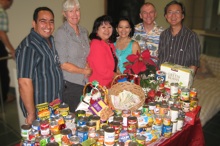 CTAHR’s annual holiday
party on Wednesday was enlivened by good food, good cheer, and appreciative
applause for retiring staff and faculty, who boasted a combined 237 years of
service to the college. The dessert table glistened not only with enough sweet
treats to satisfy the sweetest tooth but also with the astonishing table art of
IT specialist Elsie Kawahara and administrative assistant Lynnet Higuchi. Nor was the gathering simply about
indulgence and merriment: PEPS, which was in charge of donations, also
collected 183 lbs of canned food and $757 in cash and checks for the Institute
for Human Services. Last year at the luncheon the college donated 9 boxes of canned goods and $460. CTAHR’s annual holiday
party on Wednesday was enlivened by good food, good cheer, and appreciative
applause for retiring staff and faculty, who boasted a combined 237 years of
service to the college. The dessert table glistened not only with enough sweet
treats to satisfy the sweetest tooth but also with the astonishing table art of
IT specialist Elsie Kawahara and administrative assistant Lynnet Higuchi. Nor was the gathering simply about
indulgence and merriment: PEPS, which was in charge of donations, also
collected 183 lbs of canned food and $757 in cash and checks for the Institute
for Human Services. Last year at the luncheon the college donated 9 boxes of canned goods and $460.
|
Healthy Children, Helpful Students
12/16/2011 Source: Office of Communication Services, CTAHR  The
Children's Healthy Living Program (CHL), headed by Rachel Novotny (HNFAS,
pictured), is offering 2 full scholarships to qualified undergraduate/graduate
students from Hawai‘i who are passionate about preventing childhood obesity.
The goal of the CHL Training Program is to train students in food, nutrition,
public health, and other related programs, offering them the opportunity to
complement their degrees with additional training in research, outreach, and
other approaches related to preventing childhood obesity in the Pacific region.
Applications are due Dec. 30, 2011. Please visit the program’s Web site for further
information and to view the application. The
Children's Healthy Living Program (CHL), headed by Rachel Novotny (HNFAS,
pictured), is offering 2 full scholarships to qualified undergraduate/graduate
students from Hawai‘i who are passionate about preventing childhood obesity.
The goal of the CHL Training Program is to train students in food, nutrition,
public health, and other related programs, offering them the opportunity to
complement their degrees with additional training in research, outreach, and
other approaches related to preventing childhood obesity in the Pacific region.
Applications are due Dec. 30, 2011. Please visit the program’s Web site for further
information and to view the application.
|
Logistics and Economics
12/9/2011 Source: Office of Communication Services, CTAHR 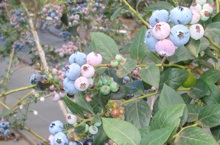 Enjoy the gift of good reading—if you haven’t checked out these recent College publications, go on and indulge! “A Comparison of Agricultural Input Prices: Hawai‘i vs. Its Major Competitors” is a sometimes sobering breakdown of costs associated with agriculture in the Islands and areas that compete for market share for ag products—along with positive suggestions. Business issues on an individual scale are the subject of “Practical Business Transition Strategies,” offering helpful hints for small business owners keep their businesses successful through common crisis points in business life. “Acidification of Volcanic Ash Soils from Maui and Hawai‘i Island for Blueberry and Tea Production” discusses exciting new crops for the state, including blueberries and tea, and the special needs that these newcomers require—in particular, a more acid soil than is usual in many parts of the Islands. How to acidify your soil? Find out here! “Hawai‘i-Grown Tea: A Market Feasibility Study Executive Summary” goes in depth on this up-and-coming crop, discussing strategies for growing, processing, and marketing what may be a lucrative addition to the ag landscape. Finally, Water Issues in Hawai‘i: Public Attitudes in 2004 and 2010 examines two surveys conducted on people’s changing perceptions of the quality of water here. Lots of food for thought! Enjoy the gift of good reading—if you haven’t checked out these recent College publications, go on and indulge! “A Comparison of Agricultural Input Prices: Hawai‘i vs. Its Major Competitors” is a sometimes sobering breakdown of costs associated with agriculture in the Islands and areas that compete for market share for ag products—along with positive suggestions. Business issues on an individual scale are the subject of “Practical Business Transition Strategies,” offering helpful hints for small business owners keep their businesses successful through common crisis points in business life. “Acidification of Volcanic Ash Soils from Maui and Hawai‘i Island for Blueberry and Tea Production” discusses exciting new crops for the state, including blueberries and tea, and the special needs that these newcomers require—in particular, a more acid soil than is usual in many parts of the Islands. How to acidify your soil? Find out here! “Hawai‘i-Grown Tea: A Market Feasibility Study Executive Summary” goes in depth on this up-and-coming crop, discussing strategies for growing, processing, and marketing what may be a lucrative addition to the ag landscape. Finally, Water Issues in Hawai‘i: Public Attitudes in 2004 and 2010 examines two surveys conducted on people’s changing perceptions of the quality of water here. Lots of food for thought!
|
Ambassadors of Aloha
12/9/2011 Source: Office of Communication Services, CTAHR 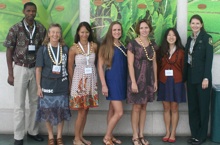 Gaoussou Diarra and Erin Guth (both NREM Ph.D. students) and Darcy Iwashita (NREM master’s student) were selected by the Society of American Foresters (SAF) as Diversity Ambassadors to the 2011 SAF National Convention held in Honolulu on Nov. 2 through 5. Along with 8 other student ambassadors from Hawai‘i and the US Mainland, they participated in workshops and networking opportunities for developing careers related to forest management. The SAF Diversity Ambassadors program was developed to promote diversity in the next generation of SAF leadership and the forestry profession. These three Hawai‘i ambassadors presented lei to plenary speakers, national awardees, and the governor, and they each gave presentations on their ongoing research designed to advance capacity to better manage forest resources in Hawai‘i and throughout the Pacific. Gaoussou Diarra and Erin Guth (both NREM Ph.D. students) and Darcy Iwashita (NREM master’s student) were selected by the Society of American Foresters (SAF) as Diversity Ambassadors to the 2011 SAF National Convention held in Honolulu on Nov. 2 through 5. Along with 8 other student ambassadors from Hawai‘i and the US Mainland, they participated in workshops and networking opportunities for developing careers related to forest management. The SAF Diversity Ambassadors program was developed to promote diversity in the next generation of SAF leadership and the forestry profession. These three Hawai‘i ambassadors presented lei to plenary speakers, national awardees, and the governor, and they each gave presentations on their ongoing research designed to advance capacity to better manage forest resources in Hawai‘i and throughout the Pacific.
|
Fight the Food Bacteria Grinch
12/9/2011 Source: Office of Communication Services, CTAHR  “’Twas the month before Christmas, / And everywhere I see / People are eating / And feasting with glee...” Thus begins the holiday poem composed by Nutrition Education for Wellness (NEW) to keep people on track with their holiday feasting. NEW would also like to remind everyone that in the midst of holiday celebrations and the array of delicious ethnic dishes that go with the season not to forget the key ingredient for gatherings year round—food safety! To that end, they’ve put together a list of food safety tips. Some highlights:
- When serving holiday buffets and party platters remember to keep hot foods hot and cold foods cold.
- Rather than serve food from one large platter, arrange food on several small platters. Refrigerate platters of food until it is time to serve, and rotate food platters within 2 hours.
Safe and happy eating!
|
Foraging a New Partnership
12/9/2011 Source: Office of Communication Services, CTAHR 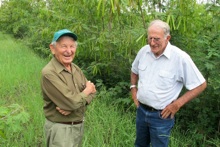 ‘Wondergraze’ is the name of a newly released leucaena forage variety in Queensland, Australia, that has its “roots” in CTAHR. ‘Wondergraze’ is marketed by Director Peter Larsen of LEUCSEEDS Inc., shown here (right) in a seed orchard with Jim Brewbaker (DrB). DrB’s students helped make the hybrid on which the new variety is based. CTAHR-based leucaenas now dominate production in Queensland’s 350,000 acres of pasture at latitudes similar to those of Hawai‘i. Visiting scientists Max Shelton and Scott Dalzell from U. Queensland helped in the breeding of these varieties in TPSS. Over a hundred graziers attended the “launch” of ‘Wondergraze,’ many of them holding properties of over 5,000 acres on which protein from leucaena—the “alfalfa of the tropics”—accounts for major increases in liveweight gains and profitability of beef production. DrB is guardedly optimistic that Hawai‘i’s beef will ultimately also be fattened out with the benefit of Hawai‘i-bred leucaenas. ‘Wondergraze’ is the name of a newly released leucaena forage variety in Queensland, Australia, that has its “roots” in CTAHR. ‘Wondergraze’ is marketed by Director Peter Larsen of LEUCSEEDS Inc., shown here (right) in a seed orchard with Jim Brewbaker (DrB). DrB’s students helped make the hybrid on which the new variety is based. CTAHR-based leucaenas now dominate production in Queensland’s 350,000 acres of pasture at latitudes similar to those of Hawai‘i. Visiting scientists Max Shelton and Scott Dalzell from U. Queensland helped in the breeding of these varieties in TPSS. Over a hundred graziers attended the “launch” of ‘Wondergraze,’ many of them holding properties of over 5,000 acres on which protein from leucaena—the “alfalfa of the tropics”—accounts for major increases in liveweight gains and profitability of beef production. DrB is guardedly optimistic that Hawai‘i’s beef will ultimately also be fattened out with the benefit of Hawai‘i-bred leucaenas.
|
Eat the Web
12/2/2011 Source: Office of Communication Services, CTAHR  Kristine Wallerius-Cuthrell (COF) was recently on KHON discussing the new and improved Hawai‘i Foods Web site, which is bursting with fresh and updated content. Since it first went online in October of 2008, more than 400 new foods have been added, including many local foods it’s not easy to find nutritional information about. The “My Diet” dietary analysis section has also been updated to include the 2010 Dietary Guidelines, and links have been added to USDA’s new MyPlate dietary guideline tool. More than 20 new recipes are there, some from KCC’s A Dash of Aloha Cookbook and others from the Cultural Cuisine pamphlets developed by CTAHR’s NEW program, courtesy of Naomi Kanehiro and staff. To find out how many calories are in a package of hot shredded ika, and lots of other useful information, check it out! Kristine Wallerius-Cuthrell (COF) was recently on KHON discussing the new and improved Hawai‘i Foods Web site, which is bursting with fresh and updated content. Since it first went online in October of 2008, more than 400 new foods have been added, including many local foods it’s not easy to find nutritional information about. The “My Diet” dietary analysis section has also been updated to include the 2010 Dietary Guidelines, and links have been added to USDA’s new MyPlate dietary guideline tool. More than 20 new recipes are there, some from KCC’s A Dash of Aloha Cookbook and others from the Cultural Cuisine pamphlets developed by CTAHR’s NEW program, courtesy of Naomi Kanehiro and staff. To find out how many calories are in a package of hot shredded ika, and lots of other useful information, check it out!
|
Grow Your Own
12/2/2011 Source: Office of Communication Services, CTAHR 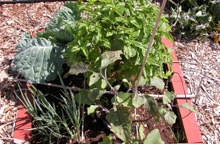 Clients of the Expanded Food and Nutrition Education Program (EFNEP) now have the opportunity to get growing. The “Grow Your Own” series of 6 lessons was developed and tested with technical help from the Master Gardener program and garden space from the Pearl City Urban Garden Center, and it’s now offered to EFNEP clients who have competed the initial “Food and Money Basics” lesson series. Clients have been learning what it takes to get started with backyard/container gardening, planting seeds and seedlings, and how to grow healthy plants. This 3-foot-square garden yielded 46 lbs of fresh vegetables, worth approximately $250, in 10 months. The lessons are available to download through the NEW Web site. Clients of the Expanded Food and Nutrition Education Program (EFNEP) now have the opportunity to get growing. The “Grow Your Own” series of 6 lessons was developed and tested with technical help from the Master Gardener program and garden space from the Pearl City Urban Garden Center, and it’s now offered to EFNEP clients who have competed the initial “Food and Money Basics” lesson series. Clients have been learning what it takes to get started with backyard/container gardening, planting seeds and seedlings, and how to grow healthy plants. This 3-foot-square garden yielded 46 lbs of fresh vegetables, worth approximately $250, in 10 months. The lessons are available to download through the NEW Web site.
|
Good Management of Resources
12/2/2011 Source: Office of Communication Services, CTAHR 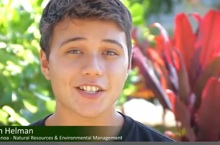 NREM undergraduate Cash Helman from the Big Island was awarded a Fernandez Earle Scholarship and is featured in UH Foundation’s new “Message for You” video saying a grateful mahalo to the donors. He plans to help educate students on ways to become more resourceful and to create a more sustainable environment for future generations. NREM undergraduate Cash Helman from the Big Island was awarded a Fernandez Earle Scholarship and is featured in UH Foundation’s new “Message for You” video saying a grateful mahalo to the donors. He plans to help educate students on ways to become more resourceful and to create a more sustainable environment for future generations.
|
Tutu and Keiki
12/2/2011 Source: Office of Communication Services, CTAHR  The Ohana Caregivers Project won the Family Caregiver Award in the Grandparents Raising Grandchildren Support Category, sponsored by the Hawaii Caregiver Coalition and KHON2. Lori Yancura (FCS) is the head of the research team that works to support the more than 14,000 grandparents who have sole responsibility for raising their grandchildren in the state of Hawai‘i. The Ohana Caregivers Project won the Family Caregiver Award in the Grandparents Raising Grandchildren Support Category, sponsored by the Hawaii Caregiver Coalition and KHON2. Lori Yancura (FCS) is the head of the research team that works to support the more than 14,000 grandparents who have sole responsibility for raising their grandchildren in the state of Hawai‘i.
|
November
To China With Love
11/23/2011 Source: Office of Communication Services, CTAHR  A
Memorandum of Understanding (MOU) on international exchange was recently signed
between CTAHR and Qiongzhou University in China. The 2 institutions agree to
cooperate on international programs based on the principle of reciprocity for a
period of 5 years. The MOU encourages the exchange of faculty, scholars,
students, academic information, and materials, and the organization of joint
research programs and conferences, in the belief that the research
and educational processes at both universities will be enhanced and that mutual
understanding will be
increased. Pictured are Dean Sylvia Yuen and Wei Yong,
Chairman of the University Council of Qiongzhou University. A
Memorandum of Understanding (MOU) on international exchange was recently signed
between CTAHR and Qiongzhou University in China. The 2 institutions agree to
cooperate on international programs based on the principle of reciprocity for a
period of 5 years. The MOU encourages the exchange of faculty, scholars,
students, academic information, and materials, and the organization of joint
research programs and conferences, in the belief that the research
and educational processes at both universities will be enhanced and that mutual
understanding will be
increased. Pictured are Dean Sylvia Yuen and Wei Yong,
Chairman of the University Council of Qiongzhou University.
|
Playing With Water
11/23/2011 Source: Office of Communication Services, CTAHR 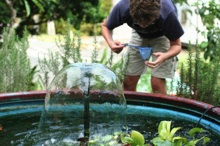 The
Family Education Training Center of Hawaii (FETCH) is sponsoring a workshop on “Hydroponic and Aquaponic
Systems in an Urban Setting,” which will be held at the Magoon Research Facility at 2717
Woodlawn Drive on Dec. 3. Participants will learn how to set up and manage
hydroponic and aquaponic systems within the constraints of a small urban lot or
inside an apartment and will also learn how to construct a
functioning rainwater catchment system. The class is free and open to the public. For more information, you can reach Mary Martini (FCS) at 956-2249. The
Family Education Training Center of Hawaii (FETCH) is sponsoring a workshop on “Hydroponic and Aquaponic
Systems in an Urban Setting,” which will be held at the Magoon Research Facility at 2717
Woodlawn Drive on Dec. 3. Participants will learn how to set up and manage
hydroponic and aquaponic systems within the constraints of a small urban lot or
inside an apartment and will also learn how to construct a
functioning rainwater catchment system. The class is free and open to the public. For more information, you can reach Mary Martini (FCS) at 956-2249.
|
Paddling to Preserve
11/23/2011 Source: Office of Communication Services, CTAHR 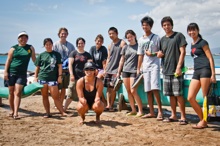 The HNFAS-sponsored
Rotaract Club participated in a project to restore O‘ahu’s last Hawaiian
fishing village at Mokauea Island (located just off Sand Island) on Oct. 26. In
order to get to the island, members paddled out in a canoe, some of them
paddling for their first time! On the island they were first given a lesson on
the history and cultural significance of Mokauea Island. Some members worked to
remove invasive kiawe, so residents can start growing native Hawaiian plants.
Other members worked in the fishpond and removed invasive limu that were
overgrowing and reducing marine life survival. The HNFAS-sponsored
Rotaract Club participated in a project to restore O‘ahu’s last Hawaiian
fishing village at Mokauea Island (located just off Sand Island) on Oct. 26. In
order to get to the island, members paddled out in a canoe, some of them
paddling for their first time! On the island they were first given a lesson on
the history and cultural significance of Mokauea Island. Some members worked to
remove invasive kiawe, so residents can start growing native Hawaiian plants.
Other members worked in the fishpond and removed invasive limu that were
overgrowing and reducing marine life survival.
|
Bioenergy Fuel Cells? That's Kid Stuff!
11/23/2011 Source: Office of Communication Services, CTAHR 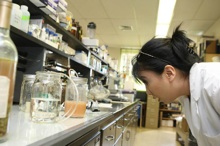 On Nov. 5,
Samir Khanal (MBBE) and his graduate student Devin Takara gave laboratory
training to 4 middle school teachers on key concepts necessary to offer
hands-on lab experiences in bioenergy to their students. Jennifer Kuwahara, Margaret Magonigle,
David Wong, and Erin Yagi (pictured) learned how to teach
students to apply and develop skills related to physics,
chemistry, math, and biology, such as how to use energy released from soil
microbes to power an LED light. Then the teachers created devices to teach
their students about microbial fuel cells, biogas, and biofuel. Samir
and Devin demonstrated how to run quick and simple experiments in a typical
Hawai‘i classroom with limited resources, like making biofuel from canned fruit juice
and biogas from cafeteria food waste, for a material cost of less than $10
apiece. Using the Bioenergy Lab Manual for Middle
School Teachers developed by Samir and Devin and tested by UHM biological
engineering undergraduate Nora Robertson, the four participating
teachers are preparing to implement the devices and concepts in their own
classrooms. The teachers are part of the FIRST Pre-Academy RET program
sponsored by UH, which works at Fostering Inspiration and Relevance through Science and Technology by providing Research Experiences for Teachers. Two more training sessions
are scheduled for January on Maui and O‘ahu, and the manual is intended to be
provided free of cost to all middle school science teachers within the state. On Nov. 5,
Samir Khanal (MBBE) and his graduate student Devin Takara gave laboratory
training to 4 middle school teachers on key concepts necessary to offer
hands-on lab experiences in bioenergy to their students. Jennifer Kuwahara, Margaret Magonigle,
David Wong, and Erin Yagi (pictured) learned how to teach
students to apply and develop skills related to physics,
chemistry, math, and biology, such as how to use energy released from soil
microbes to power an LED light. Then the teachers created devices to teach
their students about microbial fuel cells, biogas, and biofuel. Samir
and Devin demonstrated how to run quick and simple experiments in a typical
Hawai‘i classroom with limited resources, like making biofuel from canned fruit juice
and biogas from cafeteria food waste, for a material cost of less than $10
apiece. Using the Bioenergy Lab Manual for Middle
School Teachers developed by Samir and Devin and tested by UHM biological
engineering undergraduate Nora Robertson, the four participating
teachers are preparing to implement the devices and concepts in their own
classrooms. The teachers are part of the FIRST Pre-Academy RET program
sponsored by UH, which works at Fostering Inspiration and Relevance through Science and Technology by providing Research Experiences for Teachers. Two more training sessions
are scheduled for January on Maui and O‘ahu, and the manual is intended to be
provided free of cost to all middle school science teachers within the state.
|
The Death of Fire
11/23/2011 Source: Office of Communication Services, CTAHR  Anna Tomita (APDM student) triumphed at the recent 2011
International Textiles and Apparel Association meeting in Philadelphia. Anna
won the ATEXINC Award and $300 cash scholarship for Excellence in Marketable
Textiles Design at the undergraduate level. Her textile design entry was
entitled “Morte di Fuoco”; it combines wearabilty with an abstract concept of a
dying fire—fire that engulfs an object, turning to dust and ashes, as she
poetically put it. Her fabric was hand-dyed to produce the desired dark orange
and red colors, and the dress was designed to create the impression of dying
flames. Anna is pictured with her two faculty mentors, Cynthia Tsark
(left) and Shu Hwa Lin. Anna Tomita (APDM student) triumphed at the recent 2011
International Textiles and Apparel Association meeting in Philadelphia. Anna
won the ATEXINC Award and $300 cash scholarship for Excellence in Marketable
Textiles Design at the undergraduate level. Her textile design entry was
entitled “Morte di Fuoco”; it combines wearabilty with an abstract concept of a
dying fire—fire that engulfs an object, turning to dust and ashes, as she
poetically put it. Her fabric was hand-dyed to produce the desired dark orange
and red colors, and the dress was designed to create the impression of dying
flames. Anna is pictured with her two faculty mentors, Cynthia Tsark
(left) and Shu Hwa Lin.
|
Something Fishy
11/17/2011 Source: Office of Communication Services, CTAHR 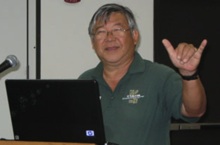 Clyde
Tamaru (MBBE) gave the opening remarks at a workshop jointly
presented by CTAHR and the Hawaii Aquaculture and Aquaponics Association on
Nov. 12 at Windward Community College. He spoke of the history of the
land-grant system and the Hatch Act, and of the importance of continuing to
follow in the traditions they have fostered. He also reported on a damaging
organism infecting tilapia on O‘ahu. Other CTAHRites included Bradley Fox,
who spoke on the use of vermicomposting in aquaponic vegetable production, and
Harry Ako (MBBE), who discussed the development of an artificial diet in the
aquaculture of the giant ‘opihi. RuthEllen Klinger-Bowen (MBBE) detailed the
results of a trial of raising Chinese catfish and red pacu together and
separately, while Yong Soo Kim (HNFAS) shared his research into the use of
biotechnology to improve muscle growth in tilapia and other fish. Clyde
Tamaru (MBBE) gave the opening remarks at a workshop jointly
presented by CTAHR and the Hawaii Aquaculture and Aquaponics Association on
Nov. 12 at Windward Community College. He spoke of the history of the
land-grant system and the Hatch Act, and of the importance of continuing to
follow in the traditions they have fostered. He also reported on a damaging
organism infecting tilapia on O‘ahu. Other CTAHRites included Bradley Fox,
who spoke on the use of vermicomposting in aquaponic vegetable production, and
Harry Ako (MBBE), who discussed the development of an artificial diet in the
aquaculture of the giant ‘opihi. RuthEllen Klinger-Bowen (MBBE) detailed the
results of a trial of raising Chinese catfish and red pacu together and
separately, while Yong Soo Kim (HNFAS) shared his research into the use of
biotechnology to improve muscle growth in tilapia and other fish.
|
Catch a Falling Raindrop
11/17/2011 Source: Office of Communication Services, CTAHR 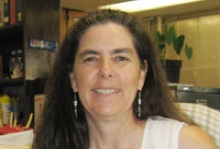 Trisha
Macomber (NREM-Hilo) was interviewed on NPR’s Living on Earth about the benefits of water
catchment. A sound recording, transcript of the
show, and slideshow of images are all available online. While “harvesting” water (the new politically correct
term) had been almost non-existent in parts of the Mainland, Trisha explains
that it never disappeared in a number of areas of Hawai‘i. Recently, though,
due to concerns over water shortages and sustainability, it has undergone a
renaissance both here and in the continental United States. (Except, of course,
in those states, like Colorado, where it’s still illegal to collect rainwater at all.) Trisha
Macomber (NREM-Hilo) was interviewed on NPR’s Living on Earth about the benefits of water
catchment. A sound recording, transcript of the
show, and slideshow of images are all available online. While “harvesting” water (the new politically correct
term) had been almost non-existent in parts of the Mainland, Trisha explains
that it never disappeared in a number of areas of Hawai‘i. Recently, though,
due to concerns over water shortages and sustainability, it has undergone a
renaissance both here and in the continental United States. (Except, of course,
in those states, like Colorado, where it’s still illegal to collect rainwater at all.)
|
Armageddon in the Garden
11/17/2011 Source: Office of Communication Services, CTAHR  Several
new Extension publications on plant diseases are out, offering both worrisome
statistics and causes for hope. “Citrus Tristeza Virus in Hawai‘i,” co-authored by Scot Nelson, Michael Melzer, and John Hu, details this
economically important virus and the stem-pitting symptoms that have damaged so
much of Hawai‘i’s citrus production, but it points out that tristeza itself is
rarely seen in the Islands anymore. Scot Nelson and Wayne Borth’s “Bamboo Mosaic” describes the
virus behind the thinning bamboo stands in the Art Building on the UHM campus
and reveals the main culprit responsible for spreading the disease—humans. Scot
also offers an overview of bacterial leaf blight of
panax, which, while causing symptoms such as dark lesions and curling
leaves, is luckily not a major economic threat to this hardy screening shrub.
The same can’t be said of Tomato yellow leaf curl
virus, which has had severe effects on the Islands’ tomato industry. In their
new publication about this threat, Jari Sugano, Michael Melzer, Archana Pant,
Ted Radovich, Steve Fukuda, Susan Migita, and Jensen Uyeda detail the results
of a trial to find tomato varieties resistant to this virus. There are a
number, which growers are advised to use, though unfortunately the beautifully
golden and tasty-sounding "Sunsugar" (pictured) isn’t among them. Several
new Extension publications on plant diseases are out, offering both worrisome
statistics and causes for hope. “Citrus Tristeza Virus in Hawai‘i,” co-authored by Scot Nelson, Michael Melzer, and John Hu, details this
economically important virus and the stem-pitting symptoms that have damaged so
much of Hawai‘i’s citrus production, but it points out that tristeza itself is
rarely seen in the Islands anymore. Scot Nelson and Wayne Borth’s “Bamboo Mosaic” describes the
virus behind the thinning bamboo stands in the Art Building on the UHM campus
and reveals the main culprit responsible for spreading the disease—humans. Scot
also offers an overview of bacterial leaf blight of
panax, which, while causing symptoms such as dark lesions and curling
leaves, is luckily not a major economic threat to this hardy screening shrub.
The same can’t be said of Tomato yellow leaf curl
virus, which has had severe effects on the Islands’ tomato industry. In their
new publication about this threat, Jari Sugano, Michael Melzer, Archana Pant,
Ted Radovich, Steve Fukuda, Susan Migita, and Jensen Uyeda detail the results
of a trial to find tomato varieties resistant to this virus. There are a
number, which growers are advised to use, though unfortunately the beautifully
golden and tasty-sounding "Sunsugar" (pictured) isn’t among them.
|
Making an Impact
11/17/2011 Source: Office of Communication Services, CTAHR 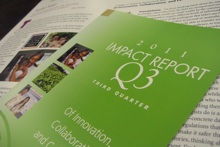 The 3rd
Quarter Impact Report is now
available online! A limited number of hard copies are also available by contacting the Office of Communication Services. In this edition, you’ll find a celebration of the
Center on the Family and its 20 years of work in support of the families and communities
of Hawai‘i, read about a new and promising agricultural industry in the
Islands—tea—and learn some interesting facts about food microbiologists and
what’s making the foods we love so tasty—or so deadly. The 3rd
Quarter Impact Report is now
available online! A limited number of hard copies are also available by contacting the Office of Communication Services. In this edition, you’ll find a celebration of the
Center on the Family and its 20 years of work in support of the families and communities
of Hawai‘i, read about a new and promising agricultural industry in the
Islands—tea—and learn some interesting facts about food microbiologists and
what’s making the foods we love so tasty—or so deadly.
|
Homeless Services
11/17/2011 Source: Office of Communication Services, CTAHR 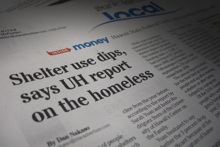 The COF,
in partnership with the Homeless Programs Office of the Hawai‘i State
Department of Human Services, has released the Homeless Service Utilization
Report: Hawai'i 2011.
Authored by Sarah Yuan and Ivette Rodriguez Stern, the report provides state-
and county-level data about the demographic characteristics of individuals and
households who accessed homeless support services during the 2011 fiscal year.
A total of 14,200 individuals were served statewide, a decrease of 3% from a
year ago. About a quarter of them were under 18. More hopeful is the fact that
41% of the total number of clients served statewide exited the program. Sarah
was also interviewed on KITV News,
emphasizing a possibly positive point that the report has brought to light: The
fact that about half of the individuals accessing homeless services say that
this is their first time being without a home shows that “the homeless
population is not all chronic.” The COF,
in partnership with the Homeless Programs Office of the Hawai‘i State
Department of Human Services, has released the Homeless Service Utilization
Report: Hawai'i 2011.
Authored by Sarah Yuan and Ivette Rodriguez Stern, the report provides state-
and county-level data about the demographic characteristics of individuals and
households who accessed homeless support services during the 2011 fiscal year.
A total of 14,200 individuals were served statewide, a decrease of 3% from a
year ago. About a quarter of them were under 18. More hopeful is the fact that
41% of the total number of clients served statewide exited the program. Sarah
was also interviewed on KITV News,
emphasizing a possibly positive point that the report has brought to light: The
fact that about half of the individuals accessing homeless services say that
this is their first time being without a home shows that “the homeless
population is not all chronic.”
|
In the Bag
11/17/2011 Source: Office of Communication Services, CTAHR  O‘ahu County 4-H members, parents,
and club leaders met on Veteran’s Day to share the ideas and activities that
the various 4-H clubs on the island are thinking up for this new 4-H year. The
crowd of 70-plus enjoyed a potluck lunch and toured the Urban Garden Center
with docents from the Master Gardener program. Since both learning and service
are important to 4-H members, the youth also assembled more than 50 bags of
food and personal care items for distribution to the family programs at the
Institute for Human Services. Many thanks to O‘ahu County 4-H club leaders Ronald
Darlington, Kimberly Lockwood, and Wanda Kohashi for putting together a fun,
educational, and community-building event. O‘ahu County 4-H members, parents,
and club leaders met on Veteran’s Day to share the ideas and activities that
the various 4-H clubs on the island are thinking up for this new 4-H year. The
crowd of 70-plus enjoyed a potluck lunch and toured the Urban Garden Center
with docents from the Master Gardener program. Since both learning and service
are important to 4-H members, the youth also assembled more than 50 bags of
food and personal care items for distribution to the family programs at the
Institute for Human Services. Many thanks to O‘ahu County 4-H club leaders Ronald
Darlington, Kimberly Lockwood, and Wanda Kohashi for putting together a fun,
educational, and community-building event.
|
Excellence Continued
11/10/2011 Source: Office of Communication Services, CTAHR  Extension educator Lynn Nakamura-Tengan (HNFAS, Maui County) was recently presented the Continued Excellence Award at the annual session of the National Extension Association of Family and Consumer Sciences in Albuquerque, NM, in recognition of her active and continuous involvement in professional improvement programs, promotion of professional development, and leadership. Her Extension outreach work includes innovative and timely programs in consumer and on-farm food safety, hand hygiene, nutrition education, and emergency preparedness. Also attending the annual session were Pamela Chow (FCS, Oahu County), Heather Greenwood (FCS, Maui County), and Julia Zee (HNFAS, Hawai‘i County). Extension educator Lynn Nakamura-Tengan (HNFAS, Maui County) was recently presented the Continued Excellence Award at the annual session of the National Extension Association of Family and Consumer Sciences in Albuquerque, NM, in recognition of her active and continuous involvement in professional improvement programs, promotion of professional development, and leadership. Her Extension outreach work includes innovative and timely programs in consumer and on-farm food safety, hand hygiene, nutrition education, and emergency preparedness. Also attending the annual session were Pamela Chow (FCS, Oahu County), Heather Greenwood (FCS, Maui County), and Julia Zee (HNFAS, Hawai‘i County).
|
Bee Appreciative
11/10/2011 Source: Office of Communication Services, CTAHR  The UH Bee Project Team, in particular Ethel Villalobos and Scott Nikaido, were recently commended for their help on Moloka‘i with the Molokai Native Hawaiian Beginning Farmer Program. This project is working to help Native Hawaiians on the Ho‘olehua Home Lands to begin farming and marketing their crops, with 18 new producers participating. A major concern has been pollination, which as Ken Grace points out is the most critical issue in terms of the hive destruction caused by Varroa mites and small hive beetles. Ethel and Scott worked to assist the staff with educational resources, including PowerPoint presentations, handouts, and educational videos. The Beginning Farmer Program has also started a beekeeping class, and they’ve consulted on curriculum. “Without the knowledge and experience Ethel and Scott have shared,” writes Moloka‘i Extension agent Jennifer Hawkins, “we could not be where we are in preserving and protecting the bees and other pollinators here on Molokai...they have been an invaluable resource to our island, which is a GREAT reflection on UH and CTAHR. Their dedication to the bees and crop pollination is amazing...I hope that your staff and your department realize what a great team resource they have!” Mahalo to Ethel and Scott for their great work and to Jennifer for her enthusiastic acknowledgement of it. The UH Bee Project Team, in particular Ethel Villalobos and Scott Nikaido, were recently commended for their help on Moloka‘i with the Molokai Native Hawaiian Beginning Farmer Program. This project is working to help Native Hawaiians on the Ho‘olehua Home Lands to begin farming and marketing their crops, with 18 new producers participating. A major concern has been pollination, which as Ken Grace points out is the most critical issue in terms of the hive destruction caused by Varroa mites and small hive beetles. Ethel and Scott worked to assist the staff with educational resources, including PowerPoint presentations, handouts, and educational videos. The Beginning Farmer Program has also started a beekeeping class, and they’ve consulted on curriculum. “Without the knowledge and experience Ethel and Scott have shared,” writes Moloka‘i Extension agent Jennifer Hawkins, “we could not be where we are in preserving and protecting the bees and other pollinators here on Molokai...they have been an invaluable resource to our island, which is a GREAT reflection on UH and CTAHR. Their dedication to the bees and crop pollination is amazing...I hope that your staff and your department realize what a great team resource they have!” Mahalo to Ethel and Scott for their great work and to Jennifer for her enthusiastic acknowledgement of it.
|
The Bugs and the Bees
11/10/2011 Source: Office of Communication Services, CTAHR 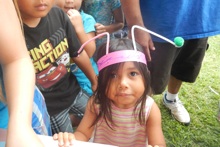 Last Saturday the members of Ka Mea Kolo, the UH PEPS Department Entomology Club, ran a display at the LCC Family Fun Fair. People who visited the display had the chance to hold monarch butterfly caterpillars, and some even got to see a monarch larva turn into a pupa. They also had the chance to look at live honeybees, termites, beetles, and a walking stick, as well as preserved specimens of insects from Hawai‘i and around the world. The live honeybees were a big hit—especially with the lucky ones who got to eat honey fresh from the comb. About 200 children also made and modeled their own antennal creations. PEPS people volunteering at the display included Clesson Higashi, Luc Leblanc, Rosalie Leiner, Michael San Jose, Andersson, Scott Nikaido, and Tyler Ito. PEPS grad students Will Haines and April Greenwell helped too! Last Saturday the members of Ka Mea Kolo, the UH PEPS Department Entomology Club, ran a display at the LCC Family Fun Fair. People who visited the display had the chance to hold monarch butterfly caterpillars, and some even got to see a monarch larva turn into a pupa. They also had the chance to look at live honeybees, termites, beetles, and a walking stick, as well as preserved specimens of insects from Hawai‘i and around the world. The live honeybees were a big hit—especially with the lucky ones who got to eat honey fresh from the comb. About 200 children also made and modeled their own antennal creations. PEPS people volunteering at the display included Clesson Higashi, Luc Leblanc, Rosalie Leiner, Michael San Jose, Andersson, Scott Nikaido, and Tyler Ito. PEPS grad students Will Haines and April Greenwell helped too!
|
Lovin’ Those Baby Pigs
11/10/2011 Source: Office of Communication Services, CTAHR 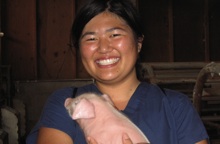 On Oct. 29, HNFAS students and Pre-Vet Club members attended a baby pig care workshop given by HNFAS Swine Specialist Halina Zaleski. Halina demonstrated biosecurity procedures, the proper way to hold the baby pigs, prevention of anemia through iron injection, identification of the pigs through ear notching, tail docking, needle teeth blunting, and other procedures common to swine farms. After the demonstration, each of the 13 students was able to practice the procedures on their own baby pig—pictured are Ednee Yoshioka, ANSC senior, and her little friend. The students evaluated the workshop content and presentation as excellent—and they particularly appreciated the hands-on experience. Thanks to the Shimokawa swine farm for hosting the students and to Johnathon Watry, Pre-Vet Club president, for organizing the event. On Oct. 29, HNFAS students and Pre-Vet Club members attended a baby pig care workshop given by HNFAS Swine Specialist Halina Zaleski. Halina demonstrated biosecurity procedures, the proper way to hold the baby pigs, prevention of anemia through iron injection, identification of the pigs through ear notching, tail docking, needle teeth blunting, and other procedures common to swine farms. After the demonstration, each of the 13 students was able to practice the procedures on their own baby pig—pictured are Ednee Yoshioka, ANSC senior, and her little friend. The students evaluated the workshop content and presentation as excellent—and they particularly appreciated the hands-on experience. Thanks to the Shimokawa swine farm for hosting the students and to Johnathon Watry, Pre-Vet Club president, for organizing the event.
|
Soup of the Day
11/10/2011 Source: Office of Communication Services, CTAHR  CTAHR faculty and students entertained and educated Noelani 1st-graders on their final harvest day at Magoon Research Station on Nov. 9. About 3 classes of 25 children each listened and participated as Maria Stewart (HNFAS)—aka Professor Peabody—taught how vitamins and minerals nourish the body and which plants contain them, all while dressed in her iconic peapod costume. Jim Hollyer (PEPS) explained the importance of food safety procedures, especially washing hands before starting to harvest. Since poop featured prominently in the talk, it was of course a big hit with the 6-year-olds! Finally SOFT members, including Gabe Sachter-Smith (pictured, with Noelani students and teacher) helped the children to harvest the vegetables they had planted at the beginning of the semester, which will be used to make a Thanksgiving soup. Speaking of Magoon, remember to come and add your thoughts to the conversation on Nov. 23 when UHM administrators and CTAHR members meet to discuss the potential use of the Magoon site for faculty housing. CTAHR faculty and students entertained and educated Noelani 1st-graders on their final harvest day at Magoon Research Station on Nov. 9. About 3 classes of 25 children each listened and participated as Maria Stewart (HNFAS)—aka Professor Peabody—taught how vitamins and minerals nourish the body and which plants contain them, all while dressed in her iconic peapod costume. Jim Hollyer (PEPS) explained the importance of food safety procedures, especially washing hands before starting to harvest. Since poop featured prominently in the talk, it was of course a big hit with the 6-year-olds! Finally SOFT members, including Gabe Sachter-Smith (pictured, with Noelani students and teacher) helped the children to harvest the vegetables they had planted at the beginning of the semester, which will be used to make a Thanksgiving soup. Speaking of Magoon, remember to come and add your thoughts to the conversation on Nov. 23 when UHM administrators and CTAHR members meet to discuss the potential use of the Magoon site for faculty housing.
|
Rainbow Broadcasters
11/2/2011 Source: Office of Communication Services, CTAHR 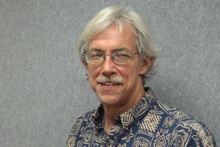 Carl Evensen, Interim
Associate Dean & Associate Director, along with Ray Uchida (O'ahu County Administrator) and Jim Hollyer (PEPS) will appear on the
show Peace of the Rainbow on Friday, Nov. 4, from 7 to 8 a.m. The show will be
broadcast live statewide on OC16 TV, on the radio at AM 1080, and globally on the Web. He’ll be discussing Hawai‘i’s Cooperative Extension Programs—what they do and
how they help; the Master Gardener program; the Plant Helpline, the Soil
Analysis service; the Seeds for Sale Web site; tips on pests and
pesticides; the O‘ahu Urban Garden; and the importance of trees in connection
with Arbor Day. Carl Evensen, Interim
Associate Dean & Associate Director, along with Ray Uchida (O'ahu County Administrator) and Jim Hollyer (PEPS) will appear on the
show Peace of the Rainbow on Friday, Nov. 4, from 7 to 8 a.m. The show will be
broadcast live statewide on OC16 TV, on the radio at AM 1080, and globally on the Web. He’ll be discussing Hawai‘i’s Cooperative Extension Programs—what they do and
how they help; the Master Gardener program; the Plant Helpline, the Soil
Analysis service; the Seeds for Sale Web site; tips on pests and
pesticides; the O‘ahu Urban Garden; and the importance of trees in connection
with Arbor Day.
|
Spreading the Organic Word
11/2/2011 Source: Office of Communication Services, CTAHR 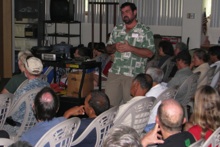 Ted
Radovich has been offering important training at several recent events: He presented at the Organic
Agriculture Training for USDA NRCS staff, where 40 NRCS conservationists and
planners from around the state attended organic agriculture trainings (facilitated
by the Oregon field office) in ‘Aiea (Oct. 18) and Hilo (Oct. 20). CTAHR was
responsible for the plant nutrition, fertility, and pest-control portions of
the program. Then at the HOFA membership conference (Oct. 21 at the Komohana
Complex in Hilo), presenters included Ted, Bradley Kai Fox (MBBE), Koon-Hui Wang (PEPS),
Hector Valenzuela (PEPS), Amjad Ahmad, and Arnold Klau Berek (TPSS grad student under Nguyen
Hue). At this conference, SOAP topic leaders presented the latest CTAHR
research relevant to organics to 85 attendees. Ted
Radovich has been offering important training at several recent events: He presented at the Organic
Agriculture Training for USDA NRCS staff, where 40 NRCS conservationists and
planners from around the state attended organic agriculture trainings (facilitated
by the Oregon field office) in ‘Aiea (Oct. 18) and Hilo (Oct. 20). CTAHR was
responsible for the plant nutrition, fertility, and pest-control portions of
the program. Then at the HOFA membership conference (Oct. 21 at the Komohana
Complex in Hilo), presenters included Ted, Bradley Kai Fox (MBBE), Koon-Hui Wang (PEPS),
Hector Valenzuela (PEPS), Amjad Ahmad, and Arnold Klau Berek (TPSS grad student under Nguyen
Hue). At this conference, SOAP topic leaders presented the latest CTAHR
research relevant to organics to 85 attendees.
|
Flight of the Ants
11/2/2011 Source: Office of Communication Services, CTAHR  Paul Krushelnycky (PEPS) offered his expertise
on the recent increase in flying ant swarms in Windward
O‘ahu. He pointed out that the weather conditions—still, humid mornings
following night rains—have put the insects in the mood for mating; they’re also
attracted to light, so the first lights that go on in the house in the morning
stir them up. Paul also warned that the winged ants will sting if disturbed,
though their true focus is simply on completing “the circle of life.” Paul Krushelnycky (PEPS) offered his expertise
on the recent increase in flying ant swarms in Windward
O‘ahu. He pointed out that the weather conditions—still, humid mornings
following night rains—have put the insects in the mood for mating; they’re also
attracted to light, so the first lights that go on in the house in the morning
stir them up. Paul also warned that the winged ants will sting if disturbed,
though their true focus is simply on completing “the circle of life.”
|
Animal Whisperers
11/2/2011 Source: Office of Communication Services, CTAHR 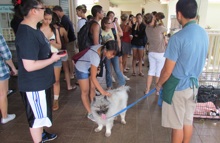 Recently, students in Brent
Buckley's (HNFAS) ANSC 200 class “Humans, Animals and Agriculture” toured the
Hawaiian Humane Society in Honolulu and discussed current issues related to
pets in Honolulu with HHS staff. The animal science program in HNFAS trains
students to become professionals with the knowledge to work with animals in many settings, and Brent’s introductory Animal Science class
exposes ANSC majors to far more than animal agriculture. It raises contemporary
ethical issues related to human relationships with animals in general, including
animal agriculture, animal research, pet overpopulation, and animal welfare.
The Hawaiian Humane Society, which employs ANSC graduates and offers
internships to ANSC majors, faces challenges every day related to humans and
our involvement with animals. Recently, students in Brent
Buckley's (HNFAS) ANSC 200 class “Humans, Animals and Agriculture” toured the
Hawaiian Humane Society in Honolulu and discussed current issues related to
pets in Honolulu with HHS staff. The animal science program in HNFAS trains
students to become professionals with the knowledge to work with animals in many settings, and Brent’s introductory Animal Science class
exposes ANSC majors to far more than animal agriculture. It raises contemporary
ethical issues related to human relationships with animals in general, including
animal agriculture, animal research, pet overpopulation, and animal welfare.
The Hawaiian Humane Society, which employs ANSC graduates and offers
internships to ANSC majors, faces challenges every day related to humans and
our involvement with animals.
|
Finding Food in the Desert
11/2/2011 Source: Office of Communication Services, CTAHR 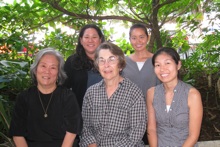 For the past decade, Dian Dooley's FSHN 452W,
Concepts in Nutrition Education course has partnered with Cooperative Extension
Service’s Nutrition Education for Wellness (NEW) Program in an Engaged
Instruction project. This semester’s students compiled an important source of information on
the growing phenomenon of food deserts, using historical and current resources
including a 2009 USDA report, research and review articles in peer-reviewed
journals, an Institute of Medicine Report and other government documents, and
public media stories. Food deserts are defined as areas in which residents do
not have ready access to nutritious and affordable foods, where the main or
only easily accessible food sources are fast food restaurants and convenience
stores, which traditionally offer lower nutritional value. At the end of the
spring semester, the students launched an informational Web site created primarily for
professionals, paraprofessionals, and community agency staff in Hawai‘i who
deal with populations living in potential food deserts. The Nutrition Education course
provides students with practical, community-based opportunities, while NEW
extension educators Kami Nishimura, Carissa Holley, Naomi Kanehiro,
Dian Dooley, and Kim Kanechika (pictured, left to right and back to front) provide
community outreach expertise and experience. This collaboration was formed to
model the “engaged public
university” envisioned by the Association of Public and Land-Grant
Universities, which becomes more involved with the community beyond the campus
walls through teaching, research, extension, and service. For the past decade, Dian Dooley's FSHN 452W,
Concepts in Nutrition Education course has partnered with Cooperative Extension
Service’s Nutrition Education for Wellness (NEW) Program in an Engaged
Instruction project. This semester’s students compiled an important source of information on
the growing phenomenon of food deserts, using historical and current resources
including a 2009 USDA report, research and review articles in peer-reviewed
journals, an Institute of Medicine Report and other government documents, and
public media stories. Food deserts are defined as areas in which residents do
not have ready access to nutritious and affordable foods, where the main or
only easily accessible food sources are fast food restaurants and convenience
stores, which traditionally offer lower nutritional value. At the end of the
spring semester, the students launched an informational Web site created primarily for
professionals, paraprofessionals, and community agency staff in Hawai‘i who
deal with populations living in potential food deserts. The Nutrition Education course
provides students with practical, community-based opportunities, while NEW
extension educators Kami Nishimura, Carissa Holley, Naomi Kanehiro,
Dian Dooley, and Kim Kanechika (pictured, left to right and back to front) provide
community outreach expertise and experience. This collaboration was formed to
model the “engaged public
university” envisioned by the Association of Public and Land-Grant
Universities, which becomes more involved with the community beyond the campus
walls through teaching, research, extension, and service.
|
Waimanalo Woes
11/2/2011 Source: Office of Communication Services, CTAHR 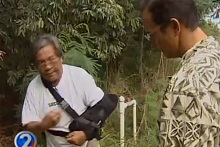 Roger Corrales, farm manager for
the Waimanalo Research Station, was recently interviewed on KHON News
regarding a theft problem at the station. Water
valves, not themselves high-priced items, were stolen, disabling the irrigation
system and leading to the waste of thousands of gallons of water and much
valuable research time. This is the second time the station has been targeted
by thieves in the past six months, and the police department has opened an ag
theft case on the matter. Roger Corrales, farm manager for
the Waimanalo Research Station, was recently interviewed on KHON News
regarding a theft problem at the station. Water
valves, not themselves high-priced items, were stolen, disabling the irrigation
system and leading to the waste of thousands of gallons of water and much
valuable research time. This is the second time the station has been targeted
by thieves in the past six months, and the police department has opened an ag
theft case on the matter.
|
Way Beyond a Jack-o-Lantern
11/2/2011 Source: Office of Communication Services, CTAHR 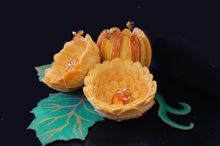 Winners for the annual PEPS Pumpkin-Carving Contest were the Bee Group, Jane Tavares, Ethel Villalobos, Tyler Ito, and Scott Nikaido, with their lovely and artistic rendering of bees settling on flowers. Runners-up were Janice Uchida and Chris Kadooka for their clever tableau of certain members of the CTAHR 'ohana sitting down to eat inside a pumpkin diorama. Frustrated artists take note: pumpkins are clearly an under-utilized artistic medium. Winners for the annual PEPS Pumpkin-Carving Contest were the Bee Group, Jane Tavares, Ethel Villalobos, Tyler Ito, and Scott Nikaido, with their lovely and artistic rendering of bees settling on flowers. Runners-up were Janice Uchida and Chris Kadooka for their clever tableau of certain members of the CTAHR 'ohana sitting down to eat inside a pumpkin diorama. Frustrated artists take note: pumpkins are clearly an under-utilized artistic medium.
|
October
Go With the Flow
10/26/2011 Source: Office of Communication Services, CTAHR 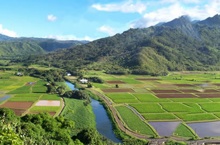 Sergio Santiago-Melendez
(NREM, PhD student) was
recently chosen as the winner in the Agriculture category of the 2011
Irrigation Foundation essay/video contest. A panel of industry and academic
judges scored each submission on the topic “How Will Irrigation Careers Be
Affected by Limited Water Supplies in the Future?” and selected one winner from
each of two categories, turf/landscape and agriculture. Sergio’s entry dealt
with ways to focus on integrated water resource management and sustainable
agricultural practices in future irrigation career training. He and his faculty
advisor, Ali Fares, will receive all-expense-paid trips to the Irrigation Show
in San Diego, at which he will be able to attend classes on such subjects as
“Center Pivot Design” and “Understanding Pumps” and meet with other academics
and industry professionals. Sergio Santiago-Melendez
(NREM, PhD student) was
recently chosen as the winner in the Agriculture category of the 2011
Irrigation Foundation essay/video contest. A panel of industry and academic
judges scored each submission on the topic “How Will Irrigation Careers Be
Affected by Limited Water Supplies in the Future?” and selected one winner from
each of two categories, turf/landscape and agriculture. Sergio’s entry dealt
with ways to focus on integrated water resource management and sustainable
agricultural practices in future irrigation career training. He and his faculty
advisor, Ali Fares, will receive all-expense-paid trips to the Irrigation Show
in San Diego, at which he will be able to attend classes on such subjects as
“Center Pivot Design” and “Understanding Pumps” and meet with other academics
and industry professionals.
|
How Safe Is Your Food?
10/26/2011 Source: Office of Communication Services, CTAHR  A partnership comprised of
the University of Tennessee, New Mexico State University, and CTAHR was awarded
a competitive grant from the federal Food and Drug Administration to provide
high-quality food and feed protection training that supports a national
integrated food safety system. As the complexity of the nation's food supply
grows, there is a concomitant need to safeguard what people consume. Food-borne
illness affects 48 million individuals, hospitalizing 128,000 and killing 3,000
annually. The Hawai‘i team, led by Barry Brennan (PEPS), received $805,979 over
five years to participate in the larger national initiative and to provide
expertise regarding ethnic food import issues and food safety issues during
times of natural and technological disasters. A partnership comprised of
the University of Tennessee, New Mexico State University, and CTAHR was awarded
a competitive grant from the federal Food and Drug Administration to provide
high-quality food and feed protection training that supports a national
integrated food safety system. As the complexity of the nation's food supply
grows, there is a concomitant need to safeguard what people consume. Food-borne
illness affects 48 million individuals, hospitalizing 128,000 and killing 3,000
annually. The Hawai‘i team, led by Barry Brennan (PEPS), received $805,979 over
five years to participate in the larger national initiative and to provide
expertise regarding ethnic food import issues and food safety issues during
times of natural and technological disasters.
|
Bee Inventive
10/26/2011 Source: Office of Communication Services, CTAHR 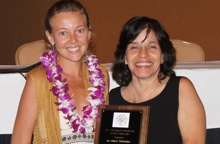 Ethel Villalobos (PEPS) was
awarded the Western Apicultural Society’s Thurber Award for Inventiveness. She
was selected for her devotion to providing immediate help, through research,
education, and outreach, to Hawai‘i beekeepers in dealing with new bee pests in
the state. The Thurber award is presented at W.A.S’s annual banquet to an
individual who has demonstrated exceptional creativity in formulating
beekeeping devices or practices. Pictured presenting the award to Ethel (right)
is Jenny Bach, vice president of W.A.S. Ethel Villalobos (PEPS) was
awarded the Western Apicultural Society’s Thurber Award for Inventiveness. She
was selected for her devotion to providing immediate help, through research,
education, and outreach, to Hawai‘i beekeepers in dealing with new bee pests in
the state. The Thurber award is presented at W.A.S’s annual banquet to an
individual who has demonstrated exceptional creativity in formulating
beekeeping devices or practices. Pictured presenting the award to Ethel (right)
is Jenny Bach, vice president of W.A.S.
|
Where Does It All Go?
10/26/2011 Source: Office of Communication Services, CTAHR 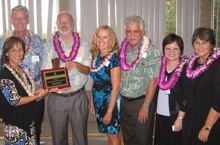 The USA Funds Life Skills
program at UHM, headed by Pamela Chow (FCS), was recently featured in one of
USA Funds’ Case Studies, and a release about the program was also posted on the UHM homepage. Pam (far left, pictured with the Life Skills team) organized the program in 2006 to help college
students create more financially healthy saving and spending behaviors, first
surveying the students to find out what they felt they needed help with and
then enlisting peer mentors to teach them. Participants learn about budgeting—including distinguishing between wants and needs and keeping a log of what they
spend—avoiding credit issues, investing, and getting ahead after graduation;
workshop and seminar venues range from the classroom to the dorm. Marked
improvement in financial literacy is shown by those who complete the program,
and student testimonials are enthusiastic, if a bit bemused at the discovery of
how necessary the lessons turned out to have been. The USA Funds Life Skills
program at UHM, headed by Pamela Chow (FCS), was recently featured in one of
USA Funds’ Case Studies, and a release about the program was also posted on the UHM homepage. Pam (far left, pictured with the Life Skills team) organized the program in 2006 to help college
students create more financially healthy saving and spending behaviors, first
surveying the students to find out what they felt they needed help with and
then enlisting peer mentors to teach them. Participants learn about budgeting—including distinguishing between wants and needs and keeping a log of what they
spend—avoiding credit issues, investing, and getting ahead after graduation;
workshop and seminar venues range from the classroom to the dorm. Marked
improvement in financial literacy is shown by those who complete the program,
and student testimonials are enthusiastic, if a bit bemused at the discovery of
how necessary the lessons turned out to have been.
|
Meaningful on Moloka‘i
10/26/2011 Source: Office of Communication Services, CTAHR 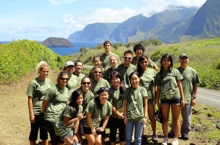 Early in the morning of
Oct. 1, nineteen CTAHR students and staff members headed to Moloka‘i for
CTAHR’s eighth annual Meaningful Experience trip. First the group made their
way to a mule barn for their tour down to Kalaupapa, a trek made unforgettable
by the breathtaking ocean views along the precarious edges of the world’s
highest sea cliffs and the necessity of having to trust their lives to the
sure-footed mules. During a guided tour through the colony of Kalaupapa, the students
learned of the history of its inhabitants with Hansen’s disease/leprosy, as
well as the current state of the town. Later that evening, students engaged in
team-building exercises led by Rouel Velasco of Student Life and Development,
which strengthened their communication and group skills. After a few hours of
activities the group traveled to Kanemitsu’s Bakery for a late-night Moloka‘i
hot bread run. The next morning, students continued their Meaningful Experience
at Rick Tamanaha’s organic farm. Stories from accountant-turned-farmer Rick
entertained and educated the group as they helped prepare seedlings for the
next papaya planting and pruned the papaya trees. After a few hours in the sun,
all came back for a huge lunch with the Tamanaha ‘ohana and family friends who
were helping that day. Then the students were rewarded with the fruits of their
labor, literally, as they got to pick fresh papaya to take home. A huge mahalo
to Rick Tamanaha and his family for graciously hosting the group on his farm,
Alton Arakaki of the Moloka‘i extension office for assisting in arranging the
activities on Moloka‘i, ASAO for supporting the students’ trip, and Rouel
Velasco for facilitating the team-building exercises! A thank you also goes to
the students who participated and made this experience meaningful for all the
attendees. Early in the morning of
Oct. 1, nineteen CTAHR students and staff members headed to Moloka‘i for
CTAHR’s eighth annual Meaningful Experience trip. First the group made their
way to a mule barn for their tour down to Kalaupapa, a trek made unforgettable
by the breathtaking ocean views along the precarious edges of the world’s
highest sea cliffs and the necessity of having to trust their lives to the
sure-footed mules. During a guided tour through the colony of Kalaupapa, the students
learned of the history of its inhabitants with Hansen’s disease/leprosy, as
well as the current state of the town. Later that evening, students engaged in
team-building exercises led by Rouel Velasco of Student Life and Development,
which strengthened their communication and group skills. After a few hours of
activities the group traveled to Kanemitsu’s Bakery for a late-night Moloka‘i
hot bread run. The next morning, students continued their Meaningful Experience
at Rick Tamanaha’s organic farm. Stories from accountant-turned-farmer Rick
entertained and educated the group as they helped prepare seedlings for the
next papaya planting and pruned the papaya trees. After a few hours in the sun,
all came back for a huge lunch with the Tamanaha ‘ohana and family friends who
were helping that day. Then the students were rewarded with the fruits of their
labor, literally, as they got to pick fresh papaya to take home. A huge mahalo
to Rick Tamanaha and his family for graciously hosting the group on his farm,
Alton Arakaki of the Moloka‘i extension office for assisting in arranging the
activities on Moloka‘i, ASAO for supporting the students’ trip, and Rouel
Velasco for facilitating the team-building exercises! A thank you also goes to
the students who participated and made this experience meaningful for all the
attendees.
|
It Pays to Save
10/20/2011 Source: Office of Communication Services, CTAHR 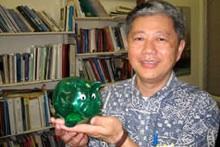 Michael
Cheang (FCS, pictured) and his Kids Savings Project took top billing in the Credit Union National Association’s Web site.
The article features ways that credit unions from Hawai‘i to New York have
helped their members change their lives through the power of savings. The Kids
Savings project has been garnering national, state, and local attention for
developing an important life skill and teaching saving behaviors to elementary school
children and their families. Michael
Cheang (FCS, pictured) and his Kids Savings Project took top billing in the Credit Union National Association’s Web site.
The article features ways that credit unions from Hawai‘i to New York have
helped their members change their lives through the power of savings. The Kids
Savings project has been garnering national, state, and local attention for
developing an important life skill and teaching saving behaviors to elementary school
children and their families.
|
Who's Managing the Farm?
10/20/2011 Source: Office of Communication Services, CTAHR 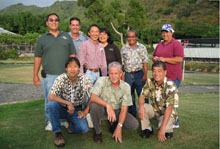 CTAHR maintains 12 stations throughout all 4 counties, spanning the range of climate, soils, and growing conditions important to Hawai‘i’s agriculture. The hardworking staff of these stations help CTAHR faculty to conduct research on a wide range of fruit and nut crops, vegetables, ornamentals, specialty crops (including coffee, tea, kava, and blueberries), and livestock (including beef cattle, goats, and sheep). The farm managers from Mealani (Kamuela), Kula, Poamoho, Waialee, Waimanalo, and Kaua‘i (pictured), along with county administrators, Associate Deans for Research and Extension, and Dean Sylvia Yuen met in Honolulu on Oct. 7 to discuss some of the issues and challenges of running these research facilities. Topics included improving productivity in research and extension activities, staffing needs, employee housing, seed and other germplasm production and distribution, and conducting commercial enterprises and generating revenue on the stations. The all-day meeting was followed by an outstanding dinner and social gathering at the Magoon Greenhouse Facility in Manoa. Many of the meeting participants also stayed the next day to take part in the Second Saturday event at the Pearl City Urban Garden Center. CTAHR maintains 12 stations throughout all 4 counties, spanning the range of climate, soils, and growing conditions important to Hawai‘i’s agriculture. The hardworking staff of these stations help CTAHR faculty to conduct research on a wide range of fruit and nut crops, vegetables, ornamentals, specialty crops (including coffee, tea, kava, and blueberries), and livestock (including beef cattle, goats, and sheep). The farm managers from Mealani (Kamuela), Kula, Poamoho, Waialee, Waimanalo, and Kaua‘i (pictured), along with county administrators, Associate Deans for Research and Extension, and Dean Sylvia Yuen met in Honolulu on Oct. 7 to discuss some of the issues and challenges of running these research facilities. Topics included improving productivity in research and extension activities, staffing needs, employee housing, seed and other germplasm production and distribution, and conducting commercial enterprises and generating revenue on the stations. The all-day meeting was followed by an outstanding dinner and social gathering at the Magoon Greenhouse Facility in Manoa. Many of the meeting participants also stayed the next day to take part in the Second Saturday event at the Pearl City Urban Garden Center.
|
Black Coffee
10/20/2011 Source: Office of Communication Services, CTAHR  The coffee berry borer (CBB) has been in the news lately as coffee growers are harvesting their crops a little more than a year after the invasive pest was first identified in the Islands. Skip Bittenbender (TPSS, pictured) is quoted on KHON TV in its discussion of possible losses for coffee farmers and higher prices for consumers, saying that probably 25% of the crop will be decimated by the tiny beetle during this harvest. In West Hawaii Today’s discussion of the same issue, both Skip and Elsie Burbano (PEPS) are quoted about the effects of CBB. Skip points out here that as bad as things are now, this year will probably be the worst; if all growers follow the protocols laid out by CTAHR researchers, including picking up and destroying all dropped cherries, using traps, and fighting CBB with the naturally occurring fungus Beauveria bassiana, effects should be mitigated in the future. The coffee berry borer (CBB) has been in the news lately as coffee growers are harvesting their crops a little more than a year after the invasive pest was first identified in the Islands. Skip Bittenbender (TPSS, pictured) is quoted on KHON TV in its discussion of possible losses for coffee farmers and higher prices for consumers, saying that probably 25% of the crop will be decimated by the tiny beetle during this harvest. In West Hawaii Today’s discussion of the same issue, both Skip and Elsie Burbano (PEPS) are quoted about the effects of CBB. Skip points out here that as bad as things are now, this year will probably be the worst; if all growers follow the protocols laid out by CTAHR researchers, including picking up and destroying all dropped cherries, using traps, and fighting CBB with the naturally occurring fungus Beauveria bassiana, effects should be mitigated in the future.
|
Teach With Termites
10/20/2011 Source: Office of Communication Services, CTAHR 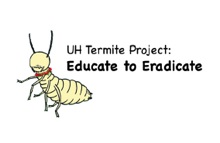 Educate to Eradicate is a PEPS project that shows community members how to reduce pest susceptibility while helping to get schoolchildren excited about science: Students use what they have learned learned about termite biology to teach their parents and other adults how to prevent the wood-chewers from damaging their homes. Tanya Ashimine, a biology, zoology, human physiology, and AVID elective teacher at Kaiser High School, uses the Educate to Eradicate curriculum with such success that she was recently awarded the President's Prize for Outstanding Achievement by the Entomological Foundation. Tanya began using insects in science classes several years ago to teach concepts such as adaptation, communication, ecology, and evolution. Educate to Eradicate is a PEPS project that shows community members how to reduce pest susceptibility while helping to get schoolchildren excited about science: Students use what they have learned learned about termite biology to teach their parents and other adults how to prevent the wood-chewers from damaging their homes. Tanya Ashimine, a biology, zoology, human physiology, and AVID elective teacher at Kaiser High School, uses the Educate to Eradicate curriculum with such success that she was recently awarded the President's Prize for Outstanding Achievement by the Entomological Foundation. Tanya began using insects in science classes several years ago to teach concepts such as adaptation, communication, ecology, and evolution.
|
Hogs on the Range
10/12/2011 Source: Office of Communication Services, CTAHR 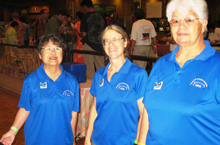 The
Mealani Taste of the Hawaiian Range was started primarily to promote local
grass-fed beef, but it has expanded to showcase and support local production of
numerous agricultural products...including pork. Swine Specialist Halina
Zaleski (HNFAS, center) and the Hawaii Pork Industry Association (HPIA) were featured
at the recent Taste; aided by HPIA Vice-President Darlene Leong (left), and
HPIA Secretary Evelyn Telles (right), Halina helped explain the new
cooking temperatures for pork. Gone are the days when USDA advised cooking pork
to an internal temperature of 165 degrees F. The recommended internal
temperature was recently lowered to 145 degrees F, which creates juicier, more
tender meat. Also helping were HPIA Treasurer Wayne Shimokawa, Lorraine
Shimokawa, HPIA State Contact to the National Pork Board Patsy Oshiro, and HPIA
Director Clayton Lee. Following the Taste, the Hawaii Pork Industry directors
met with Big Island pork producers at the Small Swine Farm Workshop in Kamuela
presented by Halina and Extension Livestock Agent Mike DuPonte (HNFAS). The
Mealani Taste of the Hawaiian Range was started primarily to promote local
grass-fed beef, but it has expanded to showcase and support local production of
numerous agricultural products...including pork. Swine Specialist Halina
Zaleski (HNFAS, center) and the Hawaii Pork Industry Association (HPIA) were featured
at the recent Taste; aided by HPIA Vice-President Darlene Leong (left), and
HPIA Secretary Evelyn Telles (right), Halina helped explain the new
cooking temperatures for pork. Gone are the days when USDA advised cooking pork
to an internal temperature of 165 degrees F. The recommended internal
temperature was recently lowered to 145 degrees F, which creates juicier, more
tender meat. Also helping were HPIA Treasurer Wayne Shimokawa, Lorraine
Shimokawa, HPIA State Contact to the National Pork Board Patsy Oshiro, and HPIA
Director Clayton Lee. Following the Taste, the Hawaii Pork Industry directors
met with Big Island pork producers at the Small Swine Farm Workshop in Kamuela
presented by Halina and Extension Livestock Agent Mike DuPonte (HNFAS).
|
Food, Glorious Food
10/12/2011 Source: Office of Communication Services, CTAHR 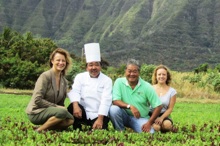 Corilee Watters (HNFAS, left), with the assistance of senior
dietetics student Crystal Bossola (right), is leading UH Food
Day, part of a national event to promote healthy eating, support sustainable farms, and
increase awareness of local food sources. On Oct. 24 Corilee, Ted Radovich
(TPSS), and Dean Okimoto (second from right) of Nalo Farms will present a forum at the Campus
Center dining room from 1:00 to 2:00 p.m. Nalo Farms, located in Waimanalo,
supplies approximately 130 restaurants—as well as UH’s dining services—with
over 3,000 pounds of their tasty greens every week. Following the presentations, there
will be a food demonstration by Philip Shon (second from right), UH Sodexo executive chef, who
works in collaboration with Donna Ojiri, RD, general manager of Sodexo. Also
available will be food tastings from local farms. There will also be booths on
careers in Food and Nutrition. Food Day emphasizes the importance of making
healthy food choices and promoting changes in food and farm policies that
benefit the environment, the economy, and the health and well-being of all
Hawai‘i’s people. Corilee Watters (HNFAS, left), with the assistance of senior
dietetics student Crystal Bossola (right), is leading UH Food
Day, part of a national event to promote healthy eating, support sustainable farms, and
increase awareness of local food sources. On Oct. 24 Corilee, Ted Radovich
(TPSS), and Dean Okimoto (second from right) of Nalo Farms will present a forum at the Campus
Center dining room from 1:00 to 2:00 p.m. Nalo Farms, located in Waimanalo,
supplies approximately 130 restaurants—as well as UH’s dining services—with
over 3,000 pounds of their tasty greens every week. Following the presentations, there
will be a food demonstration by Philip Shon (second from right), UH Sodexo executive chef, who
works in collaboration with Donna Ojiri, RD, general manager of Sodexo. Also
available will be food tastings from local farms. There will also be booths on
careers in Food and Nutrition. Food Day emphasizes the importance of making
healthy food choices and promoting changes in food and farm policies that
benefit the environment, the economy, and the health and well-being of all
Hawai‘i’s people.
|
Kav-ahh
10/12/2011 Source: Office of Communication Services, CTAHR 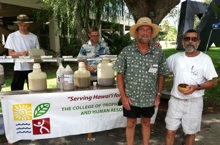 The 8th annual
Hawaii Pacific Islands Kava Festival, aka KavaFest 2011, was held on the
McCarthy Mall on Oct. 8. KavaFest, which is sponsored by CTAHR and the ‘Awa
Development Council, aims to educate the public about kava (‘awa) and to provide
an opportunity to taste and drink it. Festival founder Skip Bittenbender (TPSS, second from right)
points out that kava is “the original pau hana drink” and “the perfect
anti-road rage beverage.” Certainly it would be hard to be aggro while sipping
samples from the kava variety tasting booth hosted by the college or stocking
up on the local, organic vegetables grown at Magoon Research Facilities that
the student group SOFT was selling. Over 20 vendors sold kava, food, and
crafts, and several bands played lots of local music. The festival ended with a
short film festival—about kava, of course. Also pictured are Travis Idol (NREM, left), Andrew Bowles (MBBE, graduate student, second from left), and Marc Rosen (Physics, right). The 8th annual
Hawaii Pacific Islands Kava Festival, aka KavaFest 2011, was held on the
McCarthy Mall on Oct. 8. KavaFest, which is sponsored by CTAHR and the ‘Awa
Development Council, aims to educate the public about kava (‘awa) and to provide
an opportunity to taste and drink it. Festival founder Skip Bittenbender (TPSS, second from right)
points out that kava is “the original pau hana drink” and “the perfect
anti-road rage beverage.” Certainly it would be hard to be aggro while sipping
samples from the kava variety tasting booth hosted by the college or stocking
up on the local, organic vegetables grown at Magoon Research Facilities that
the student group SOFT was selling. Over 20 vendors sold kava, food, and
crafts, and several bands played lots of local music. The festival ended with a
short film festival—about kava, of course. Also pictured are Travis Idol (NREM, left), Andrew Bowles (MBBE, graduate student, second from left), and Marc Rosen (Physics, right).
|
Never Too Early to Recruit
10/12/2011 Source: Office of Communication Services, CTAHR 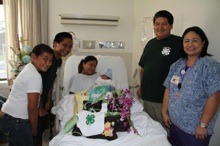 The East Hawai‘i 4-H
program feels you’re never too young to be an honorary member! During National
4-H Week, which ran Oct. 2–8, one of the activities 4-H members did as part of
a community service project was to hold a “National 4-H Week’s First Baby Born
Contest” in collaboration with the maternity ward at Hilo Medical Center in
Hilo. Members gathered donations of baby items and presented them to one lucky
family. This project was such a success that the hospital has asked the group
to make this an annual tradition. Other activities and events during the week
included the annual 4-H Sunday Service at the Hilo Hongwanji, a 4-H
Volunteer/Leader Orientation Training, and a 4-H Kick-Off event at Hapuna Beach
State Park. The East Hawai‘i 4-H
program feels you’re never too young to be an honorary member! During National
4-H Week, which ran Oct. 2–8, one of the activities 4-H members did as part of
a community service project was to hold a “National 4-H Week’s First Baby Born
Contest” in collaboration with the maternity ward at Hilo Medical Center in
Hilo. Members gathered donations of baby items and presented them to one lucky
family. This project was such a success that the hospital has asked the group
to make this an annual tradition. Other activities and events during the week
included the annual 4-H Sunday Service at the Hilo Hongwanji, a 4-H
Volunteer/Leader Orientation Training, and a 4-H Kick-Off event at Hapuna Beach
State Park.
|
Hawai‘i Ag Goes to Washington
10/12/2011 Source: Office of Communication Services, CTAHR 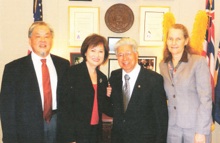 Interim Dean Sylvia Yuen
recently joined a delegation consisting of Russell Kokubon, Director of the
Department of Agriculture; Kris Kanazawa, USDA State Director of Rural
Development; Diane Ley, USDA State Director of Farm Service Agency; and
Jennifer Wooten, program officer for Senator Inouye, to the nation’s capitol.
The delegation met with Senators Inouye and Akaka and Representatives Hanabusa
and Hirono. They also met with USDA Under Secretaries Catherine Woteki and Ed
Avalos, Deputy Secretary Kathleen Merrigan, and administrators of all major
programs to present information on Hawai‘i’s food and agriculture system. The
discussions went well, and positive follow-up actions will be taken as a result
of the meetings. For example, Dr. Woteki has agreed to present at a food
security and safety workshop that Sylvia and Russell are organizing in
conjunction with the APEC meetings in Honolulu, and she will try to schedule
time during that visit to meet with CTAHR faculty to learn more about the
college’s programs. Interim Dean Sylvia Yuen
recently joined a delegation consisting of Russell Kokubon, Director of the
Department of Agriculture; Kris Kanazawa, USDA State Director of Rural
Development; Diane Ley, USDA State Director of Farm Service Agency; and
Jennifer Wooten, program officer for Senator Inouye, to the nation’s capitol.
The delegation met with Senators Inouye and Akaka and Representatives Hanabusa
and Hirono. They also met with USDA Under Secretaries Catherine Woteki and Ed
Avalos, Deputy Secretary Kathleen Merrigan, and administrators of all major
programs to present information on Hawai‘i’s food and agriculture system. The
discussions went well, and positive follow-up actions will be taken as a result
of the meetings. For example, Dr. Woteki has agreed to present at a food
security and safety workshop that Sylvia and Russell are organizing in
conjunction with the APEC meetings in Honolulu, and she will try to schedule
time during that visit to meet with CTAHR faculty to learn more about the
college’s programs.
|
Not Just a Pretty Place
10/12/2011 Source: Office of Communication Services, CTAHR 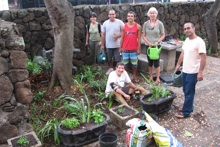 A new garden on campus is a
model—and that doesn’t just mean it looks pretty. A group of CTAHR faculty,
staff, and students have planted the garden in front of Gilmore Hall with
several very specific purposes in mind. The project, funded by CTAHR Efficiency
and Capacity Improvement Funds, is entitled “Butterfly Garden and Back Yard
Cover Cropping at Gilmore Building,” a long title that doesn’t give a full sense
of its scope. Several PEPS and TPSS members involved are Koon-Hui Wang, Andy
Kaufman, Leyla Kaufman, Dan Rubinoff, and William Haines. Establishing,
tending, and observing the garden will be used in the teaching and outreach
activities of a number of classes or programs on the UHM campus. The focus is
on Native Hawaiian plants and noninvasive plant species that provide habitats
for beneficial insects, especially those native or endemic to Hawai‘i and those
that are natural enemies to insect pests and/or are pollinators. Finally, Andy
also designed the garden for efficient water use, incorporating drip irrigation
and organic mulch. It’s not just attractive to insects, either—spicy-scented
peppermint and the bright colors of heliotrope make it just as pleasant for
humans. A new garden on campus is a
model—and that doesn’t just mean it looks pretty. A group of CTAHR faculty,
staff, and students have planted the garden in front of Gilmore Hall with
several very specific purposes in mind. The project, funded by CTAHR Efficiency
and Capacity Improvement Funds, is entitled “Butterfly Garden and Back Yard
Cover Cropping at Gilmore Building,” a long title that doesn’t give a full sense
of its scope. Several PEPS and TPSS members involved are Koon-Hui Wang, Andy
Kaufman, Leyla Kaufman, Dan Rubinoff, and William Haines. Establishing,
tending, and observing the garden will be used in the teaching and outreach
activities of a number of classes or programs on the UHM campus. The focus is
on Native Hawaiian plants and noninvasive plant species that provide habitats
for beneficial insects, especially those native or endemic to Hawai‘i and those
that are natural enemies to insect pests and/or are pollinators. Finally, Andy
also designed the garden for efficient water use, incorporating drip irrigation
and organic mulch. It’s not just attractive to insects, either—spicy-scented
peppermint and the bright colors of heliotrope make it just as pleasant for
humans.
|
Eat Your Experiment
10/5/2011 Source: Office of Communication Services, CTAHR  The students in Alvin Huang’s FSHN 381 Experimental Foods class get to eat their experiments! Actually, there’s a competition among the students to develop a food product, which is then judged by HNFAS faculty and outsiders from the food industry. This year, the students were challenged to develop a high-fiber muffin with the following targets: 10% dietary fiber, less than 8% sugar, and less than 10% fat. They also were restricted to a specific budget. Beyond that, though, they could get crazy. Included among the top muffins was a “Coconana Oat Muffin,” but the field also included a “Garden Rainbow Garlic and Herb muffin” for the savory lovers, a seasonal “High-Fiber Pumpkin Spice Muffin,” and a “Gluten-Free Pumpkin Spice Muffin.” The students also gave a 10-minute oral presentation and developed a complete nutrition label for their muffin. Lucky judges of the muffins were HNFAS faculty Alan Titchenal, Halina Zaleski, and Doug Vincent, as well as outside judges Jennifer Shido, a former FSHN graduate student who’s working in product development for the UH Rainbowtique; Leonard Obaldo, formerly of The Oceanic Institute and now consulting for US AID; and Bill Akiona of OmniGreen Renewables. Congratulations to Alvin’s students for their hard work, creativity, and ingenuity. The students in Alvin Huang’s FSHN 381 Experimental Foods class get to eat their experiments! Actually, there’s a competition among the students to develop a food product, which is then judged by HNFAS faculty and outsiders from the food industry. This year, the students were challenged to develop a high-fiber muffin with the following targets: 10% dietary fiber, less than 8% sugar, and less than 10% fat. They also were restricted to a specific budget. Beyond that, though, they could get crazy. Included among the top muffins was a “Coconana Oat Muffin,” but the field also included a “Garden Rainbow Garlic and Herb muffin” for the savory lovers, a seasonal “High-Fiber Pumpkin Spice Muffin,” and a “Gluten-Free Pumpkin Spice Muffin.” The students also gave a 10-minute oral presentation and developed a complete nutrition label for their muffin. Lucky judges of the muffins were HNFAS faculty Alan Titchenal, Halina Zaleski, and Doug Vincent, as well as outside judges Jennifer Shido, a former FSHN graduate student who’s working in product development for the UH Rainbowtique; Leonard Obaldo, formerly of The Oceanic Institute and now consulting for US AID; and Bill Akiona of OmniGreen Renewables. Congratulations to Alvin’s students for their hard work, creativity, and ingenuity.
|
Hold the Mold
10/5/2011 Source: Office of Communication Services, CTAHR 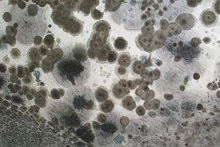 The Chancellor’s Office has put out guidelines on getting ready for the Manoa Green Days, which will take place over Thanksgiving break (Nov. 23, starting 6:00 p.m., to Nov. 27); winter break (Dec. 17 to Jan. 2); and spring break (Mar. 24 to Apr. 1). Since the buildings will be largely closed up during these times and the air conditioning will be off, mold and fungus growth is a possibility, and these tips will help to keep it in check. For instance, plants should be removed and aquariums drained—though presumably not if these things are integral to one’s research? The Manoa Green Days Web site offers more specifics. The Chancellor’s Office has put out guidelines on getting ready for the Manoa Green Days, which will take place over Thanksgiving break (Nov. 23, starting 6:00 p.m., to Nov. 27); winter break (Dec. 17 to Jan. 2); and spring break (Mar. 24 to Apr. 1). Since the buildings will be largely closed up during these times and the air conditioning will be off, mold and fungus growth is a possibility, and these tips will help to keep it in check. For instance, plants should be removed and aquariums drained—though presumably not if these things are integral to one’s research? The Manoa Green Days Web site offers more specifics.
|
Friday Is Genes Day
10/5/2011 Source: Office of Communication Services, CTAHR 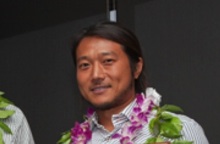 Ryo Kubota (MBBE PhD candidate, pictured), who works in Daniel Jenkins’s (MBBE) lab, will give a talk on “Portable Gene-Based Agricultural Diagnostics” such as the award-winning products his start-up company Diagenetix creates. Attendees can bring their own lunches or partake of the light snacks and refreshments that will be provided at the presentation/demonstration on Friday, Oct. 7, from 12 to 1 or 1:30 p.m. in Gilmore 306. For more detailed information, please e-mail Daniel at danielj@hawaii.edu. Ryo Kubota (MBBE PhD candidate, pictured), who works in Daniel Jenkins’s (MBBE) lab, will give a talk on “Portable Gene-Based Agricultural Diagnostics” such as the award-winning products his start-up company Diagenetix creates. Attendees can bring their own lunches or partake of the light snacks and refreshments that will be provided at the presentation/demonstration on Friday, Oct. 7, from 12 to 1 or 1:30 p.m. in Gilmore 306. For more detailed information, please e-mail Daniel at danielj@hawaii.edu.
|
Don't Eat Grass, Eat Grass-Fed
10/5/2011 Source: Office of Communication Services, CTAHR  Mealani Research Station’s Taste of the Hawaiian Range and Agriculture Festival was held at the Hilton Waikoloa on the Big Island on Sept. 30. More than 1,000 attendees at this premier food-grazing event got to sample dishes prepared by over 30 of the state’s top chefs. Different cuts of local grass-fed beef, pork, lamb, mutton, goat, and wild boar were featured, along with fresh Island-grown fruits and vegetables. Over 30 vendors displayed their artisanal products, including Kona coffee, Puna goat cheese, and Big Island honey, and there were educational displays like CTAHR’s offerings on tea, blueberries (pictured), and ginger. Culinary students of Hawai‘i Community College attended a class on “From Farm to Fork” and then assisted chefs and vendors at the main event. The public was invited to attend a cooking demonstration of grass-fed beef by CTAHR alumnus Derek Kurisu from KTA SuperStores and Chef Scott Hiraishi from Sam Choy’s Kai Lanai. The “Taste” was, as always, a celebration of local agriculture—and a gustatory thrill ride! Mealani Research Station’s Taste of the Hawaiian Range and Agriculture Festival was held at the Hilton Waikoloa on the Big Island on Sept. 30. More than 1,000 attendees at this premier food-grazing event got to sample dishes prepared by over 30 of the state’s top chefs. Different cuts of local grass-fed beef, pork, lamb, mutton, goat, and wild boar were featured, along with fresh Island-grown fruits and vegetables. Over 30 vendors displayed their artisanal products, including Kona coffee, Puna goat cheese, and Big Island honey, and there were educational displays like CTAHR’s offerings on tea, blueberries (pictured), and ginger. Culinary students of Hawai‘i Community College attended a class on “From Farm to Fork” and then assisted chefs and vendors at the main event. The public was invited to attend a cooking demonstration of grass-fed beef by CTAHR alumnus Derek Kurisu from KTA SuperStores and Chef Scott Hiraishi from Sam Choy’s Kai Lanai. The “Taste” was, as always, a celebration of local agriculture—and a gustatory thrill ride!
|
And the Walls Came Tumbling Down
10/5/2011 Source: Office of Communication Services, CTAHR 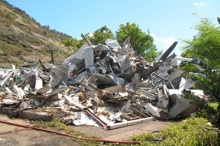 The elderly USDA Fruit Fly Facility at Magoon Labs has been demolished to make way for a new aquaponics area. Clyde Tamaru (MBBE) will be moving the base of operations of his innovative blend of hydroponic gardening and fish farming from his present location at Windward Community College, which has accommodated his program for the past few years, to Magoon. This will be a welcome addition to Magoon’s already rich array of educational and research opportunities, ranging from the breeding of award-winning anthuriums to studying how to put more muscle on farm animals to teaching Noelani first-graders how to plant their first vegetable garden and much more. In other facilities news, the Gilmore elevator renovation project is estimated to be bid out in Dec. 2011, and construction estimated to start in the summer of 2012. The elderly USDA Fruit Fly Facility at Magoon Labs has been demolished to make way for a new aquaponics area. Clyde Tamaru (MBBE) will be moving the base of operations of his innovative blend of hydroponic gardening and fish farming from his present location at Windward Community College, which has accommodated his program for the past few years, to Magoon. This will be a welcome addition to Magoon’s already rich array of educational and research opportunities, ranging from the breeding of award-winning anthuriums to studying how to put more muscle on farm animals to teaching Noelani first-graders how to plant their first vegetable garden and much more. In other facilities news, the Gilmore elevator renovation project is estimated to be bid out in Dec. 2011, and construction estimated to start in the summer of 2012.
|
Learning to Lead
10/3/2011 Source: Office of Communication Services, CTAHR 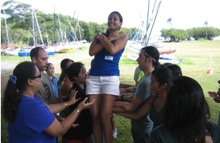 On Sept. 9-11, 26 Food Science and Human Nutrition students participated in the Fall 2011 FSHN Leadership Retreat at Camp Kokokahi in Kaneohe. UHM Assistant Vice Chancellor for Students and Dean of Students Lori Ideta and Leslie Opulauoho of the National Coalition Building Institute Program nurtured the development of the students’ leadership and teambuilding skills by facilitating activities that had them step out of their comfort zones and learn the importance of trust and communication. Campers left with stronger life skills, new friendships, and lifetime memories. The camp was made possible by contributions from Wayne Iwaoka’s (HNFAS) Ka Pouhana Mentor Award and monies from CTAHR. C-N Lee (HNFAS) assisted in the planning process and food preparation. On Sept. 9-11, 26 Food Science and Human Nutrition students participated in the Fall 2011 FSHN Leadership Retreat at Camp Kokokahi in Kaneohe. UHM Assistant Vice Chancellor for Students and Dean of Students Lori Ideta and Leslie Opulauoho of the National Coalition Building Institute Program nurtured the development of the students’ leadership and teambuilding skills by facilitating activities that had them step out of their comfort zones and learn the importance of trust and communication. Campers left with stronger life skills, new friendships, and lifetime memories. The camp was made possible by contributions from Wayne Iwaoka’s (HNFAS) Ka Pouhana Mentor Award and monies from CTAHR. C-N Lee (HNFAS) assisted in the planning process and food preparation.
|
Lighting Lives
10/3/2011 Source: Office of Communication Services, CTAHR 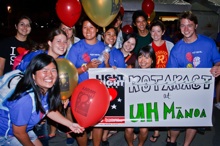 The HNFAS-sponsored Rotaract Club at UH-Manoa helped out the Leukemia and Lymphoma Society by participating in the “Light the Night Walk” at Ward Center on Sept. 22. Rotaract President Ednee Yoshioka, an Animal Sciences Senior, reports that the club exceeded its goal of $1000 by raising nearly $1400. The Rotaract Club is a Rotary-sponsored service club for young men and women at UH. Its purpose is to address the physical and social needs of the community while promoting international understanding and peace through a framework of friendship and service projects. Ashley Stokes (HNFAS) is one of the club sponsors. Pictured, from front left, are Ednee Yoshioka, Whitney Preston, Tracy Sy, Chelsea Lee, Kathleen Harrington, Nanami Tomita, Cherie Patton, Samuel Pastore-Braden, and from back left, Iara Recchi, Hailey Granlund, Dwane Tegman, and Bobby Bergonio. Photo courtesy of Carson Sakamoto. The HNFAS-sponsored Rotaract Club at UH-Manoa helped out the Leukemia and Lymphoma Society by participating in the “Light the Night Walk” at Ward Center on Sept. 22. Rotaract President Ednee Yoshioka, an Animal Sciences Senior, reports that the club exceeded its goal of $1000 by raising nearly $1400. The Rotaract Club is a Rotary-sponsored service club for young men and women at UH. Its purpose is to address the physical and social needs of the community while promoting international understanding and peace through a framework of friendship and service projects. Ashley Stokes (HNFAS) is one of the club sponsors. Pictured, from front left, are Ednee Yoshioka, Whitney Preston, Tracy Sy, Chelsea Lee, Kathleen Harrington, Nanami Tomita, Cherie Patton, Samuel Pastore-Braden, and from back left, Iara Recchi, Hailey Granlund, Dwane Tegman, and Bobby Bergonio. Photo courtesy of Carson Sakamoto.
|
The Greening of the Industry
10/3/2011 Source: Office of Communication Services, CTAHR  Linda Cox (NREM) was commended by the Hawaii Ecotourism Association for her work in establishing a certification program for ecotour operators. The certification allows visitors to gauge the sustainability practices of particular operators and thus promotes tourism that is less damaging to the environment. Chris Colvin, the president of the HEA, praised Linda’s “outstanding contributions” stemming from her “passion, commitment, expertise, and plain hard work.” Linda was also quoted in an article about the certification program in the Star-Advertiser on Sept. 22. There’s a publication about the subject co-written by Linda, Melanie Saucier (NREM), and researchers from UH’s Environmental Center, School of Travel Industry Management, and Geography Department that explains more about the concept of sustainable tourism and sets forth the idea of an evaluation system to promote it. Linda Cox (NREM) was commended by the Hawaii Ecotourism Association for her work in establishing a certification program for ecotour operators. The certification allows visitors to gauge the sustainability practices of particular operators and thus promotes tourism that is less damaging to the environment. Chris Colvin, the president of the HEA, praised Linda’s “outstanding contributions” stemming from her “passion, commitment, expertise, and plain hard work.” Linda was also quoted in an article about the certification program in the Star-Advertiser on Sept. 22. There’s a publication about the subject co-written by Linda, Melanie Saucier (NREM), and researchers from UH’s Environmental Center, School of Travel Industry Management, and Geography Department that explains more about the concept of sustainable tourism and sets forth the idea of an evaluation system to promote it.
|
Island-Grown Tea
10/3/2011 Source: Office of Communication Services, CTAHR 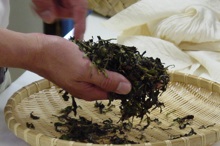 UH-Hilo will host a presentation of the report on the tea industry in Hawai‘i developed by CTAHR in collaboration with the Pacific Asian Center for Entrepreneurship and E-Business at the Shidler College of Business. “Hawai’i-Grown Tea: A Market Feasibility Study” will be discussed on Tuesday, Oct. 18 from 5:00 to 7:30 pm at UCB 115. Please feel free to extend this invitation to anyone who would be interested in attending. UH-Hilo will host a presentation of the report on the tea industry in Hawai‘i developed by CTAHR in collaboration with the Pacific Asian Center for Entrepreneurship and E-Business at the Shidler College of Business. “Hawai’i-Grown Tea: A Market Feasibility Study” will be discussed on Tuesday, Oct. 18 from 5:00 to 7:30 pm at UCB 115. Please feel free to extend this invitation to anyone who would be interested in attending.
|
Sweets in the Field
10/3/2011 Source: Office of Communication Services, CTAHR  A Sweet Corn Field Day will be held from 9 to 11 a.m. on Oct. 8 at CTAHR’s Waimanalo Research Station. Three new sweet corn hybrids will be featured, ‘Sweet Sarah,’ ‘Sweet Jenny,’ and ‘Sweet Cynthia.’ The people for whom they have been named will be honored, as well. The Station is located at 41-698 Ahiki St. in Waimanalo, mauka of Waimanalo Park. On exhibit will be 10 different sweet corn varieties and free seed samples. Descriptive plantings will include corn genetic seedstocks of Hawaii Foundation Seeds and of Hawai‘i’s No. 1 agricultural industry, corn seed. For more information, call James Brewbaker (TPSS) at 295-5688. A Sweet Corn Field Day will be held from 9 to 11 a.m. on Oct. 8 at CTAHR’s Waimanalo Research Station. Three new sweet corn hybrids will be featured, ‘Sweet Sarah,’ ‘Sweet Jenny,’ and ‘Sweet Cynthia.’ The people for whom they have been named will be honored, as well. The Station is located at 41-698 Ahiki St. in Waimanalo, mauka of Waimanalo Park. On exhibit will be 10 different sweet corn varieties and free seed samples. Descriptive plantings will include corn genetic seedstocks of Hawaii Foundation Seeds and of Hawai‘i’s No. 1 agricultural industry, corn seed. For more information, call James Brewbaker (TPSS) at 295-5688.
|
September
Healthy Keiki
9/21/2011 Source: Office of Communication Services, CTAHR  Gary Heusel (4-H) has been chosen by the National 4-H Council as one of 15 awardees for the 2011–2012 Walmart Youth Voice: Youth Choice Grant. Youth Voice, Youth Choice “encourages youth to take action around three healthy living priorities—nutrition, physical fitness, and safety” says the national 4-H Web site. Program leaders use these grants, funded by the Walmart Foundation, to institute local programs, including camps, workshops, and other interactive activities, that help kids lead healthier and more active lives. Each program reaches at least 500 youth and their families. Gary’s commitment to strengthening 4-H in Hawai‘i will be supported by the $50,000 grant—and the keiki will be the real winners. Gary Heusel (4-H) has been chosen by the National 4-H Council as one of 15 awardees for the 2011–2012 Walmart Youth Voice: Youth Choice Grant. Youth Voice, Youth Choice “encourages youth to take action around three healthy living priorities—nutrition, physical fitness, and safety” says the national 4-H Web site. Program leaders use these grants, funded by the Walmart Foundation, to institute local programs, including camps, workshops, and other interactive activities, that help kids lead healthier and more active lives. Each program reaches at least 500 youth and their families. Gary’s commitment to strengthening 4-H in Hawai‘i will be supported by the $50,000 grant—and the keiki will be the real winners.
|
Downright Neighborly
9/21/2011 Source: Office of Communication Services, CTAHR 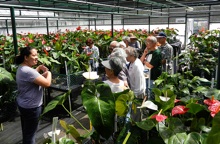 Tessie Amore (pictured) showed off CTAHR’s newly renovated greenhouses and her research at the Magoon Research and Instructional Facility to visitors from the Manoa Acres Residents Association. The close-knit group is comprised of about 100 families living near the CTAHR facility. About 15 “neighbors” attended the tour arranged by Joe DeFrank (TPSS). Joe and Craig Okazaki also introduced the Magoon visitors to Joe’s Hawaiian Rules Bocce Ball. Joe is quickly approaching rock star status with the senior citizens of the neighborhood, having organized a similar tour last year for the Hui O Manoa Seniors organization. As one of the visitors exclaimed, “This tour taught us a great deal about the plants and soils of Hawai‘i and the importance of the research being conducted at your facility.” Tessie Amore (pictured) showed off CTAHR’s newly renovated greenhouses and her research at the Magoon Research and Instructional Facility to visitors from the Manoa Acres Residents Association. The close-knit group is comprised of about 100 families living near the CTAHR facility. About 15 “neighbors” attended the tour arranged by Joe DeFrank (TPSS). Joe and Craig Okazaki also introduced the Magoon visitors to Joe’s Hawaiian Rules Bocce Ball. Joe is quickly approaching rock star status with the senior citizens of the neighborhood, having organized a similar tour last year for the Hui O Manoa Seniors organization. As one of the visitors exclaimed, “This tour taught us a great deal about the plants and soils of Hawai‘i and the importance of the research being conducted at your facility.”
|
Animal Planet, Local-Style
9/21/2011 Source: Office of Communication Services, CTAHR 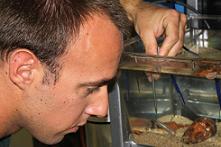 Jon-Paul Bingham shares the spotlight with the graduate students working in his laboratory in a recently aired segment on OC16’s ThinkTech discussing his work with venomous cone snails. Clifford Kapono is studying the peptides in snail toxins, while M.S. candidate Zan Halford is researching how to replicate the natural compounds in the laboratory. Jeffrey Milisen (pictured), another of Jon-Paul’s research assistants, is shown in an exciting sequence involving milking the venom from the snails: He teases the snails with a pinioned fish until one shoots out its toxic harpoon, whereupon he catches it in a collecting tube, snipping off the dart and preserving it and its load of poison for further study. He tells the interviewer that no one in Hawai'i has been killed by the cone snail...yet. But it’s still pretty dramatic...as are the potential benefits of Jon-Paul’s study of these fascinating but deadly creatures. Jon-Paul Bingham shares the spotlight with the graduate students working in his laboratory in a recently aired segment on OC16’s ThinkTech discussing his work with venomous cone snails. Clifford Kapono is studying the peptides in snail toxins, while M.S. candidate Zan Halford is researching how to replicate the natural compounds in the laboratory. Jeffrey Milisen (pictured), another of Jon-Paul’s research assistants, is shown in an exciting sequence involving milking the venom from the snails: He teases the snails with a pinioned fish until one shoots out its toxic harpoon, whereupon he catches it in a collecting tube, snipping off the dart and preserving it and its load of poison for further study. He tells the interviewer that no one in Hawai'i has been killed by the cone snail...yet. But it’s still pretty dramatic...as are the potential benefits of Jon-Paul’s study of these fascinating but deadly creatures.
|
Collaboration in Albania
9/21/2011 Source: Office of Communication Services, CTAHR  The Albania-Hawaii Higher Education and Economics Development (AHEED) project headed by Catherine Chan-Halbrendt (NREM) has sent 6 professors over the past 3 years from UH to Albania to strengthen the agricultural economics education and outreach program of the Agricultural University of Tirana (AUT). However, the time, effort, and expense of traveling to Albania limits the number of classes that can be taught and the UH faculty who can teach them. In order to enhance its ability to empower AUT’s faculty to conduct policy research with the most current tools available, the AHEED project recently taught its first class via Blackboard Collaborate. The use of this cutting-edge technology allowed PingSun Leung (NREM, pictured) to teach “Topics in Quantitative Methods for Agricultural Economics Research” in a virtual online classroom from his office at UH while students in Albania followed along on an interactive, real-time platform. Eight AUT faculty members and six students participated in the course. Overall, participants found the class and the new techniques it taught to be a highly valuable experience. Attendees will use the methods learned to develop new agricultural economics research in the next year. Some attendees were even able to follow the course online from their homes, and all have expressed their interest in having more courses like this in the future. The Albania-Hawaii Higher Education and Economics Development (AHEED) project headed by Catherine Chan-Halbrendt (NREM) has sent 6 professors over the past 3 years from UH to Albania to strengthen the agricultural economics education and outreach program of the Agricultural University of Tirana (AUT). However, the time, effort, and expense of traveling to Albania limits the number of classes that can be taught and the UH faculty who can teach them. In order to enhance its ability to empower AUT’s faculty to conduct policy research with the most current tools available, the AHEED project recently taught its first class via Blackboard Collaborate. The use of this cutting-edge technology allowed PingSun Leung (NREM, pictured) to teach “Topics in Quantitative Methods for Agricultural Economics Research” in a virtual online classroom from his office at UH while students in Albania followed along on an interactive, real-time platform. Eight AUT faculty members and six students participated in the course. Overall, participants found the class and the new techniques it taught to be a highly valuable experience. Attendees will use the methods learned to develop new agricultural economics research in the next year. Some attendees were even able to follow the course online from their homes, and all have expressed their interest in having more courses like this in the future.
|
Improved Accessibility
9/21/2011 Source: Office of Communication Services, CTAHR 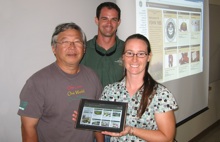 This past semester, with partial funding from CTAHR’s Efficiency and Capacity Improvement Solicitation, UHM’s College of Education's Distance Course Design and Consulting Group (DCDC) worked with CTAHR faculty to develop three new online courses, including The Science of Human Nutrition (FSHN 185), led by Maria Stewart (right), and Introduction to Aquaponics, led by Clyde Tamaru and Bradly Fox (left and middle). Paul McKimmy and Ariana Eichelberger of DCDC held a show-and-tell on the new Human Nutrition and Aquaponics online courses on September 1, showing the course sites, instructors’ guides, and instructors’ support sites that form the backbone of the online courses. They also demonstrated the courses on mobile devices (Android tablet, iPad, and smart phones). CTAHR subject matter experts were on hand to answer questions about the process, the courses, and the DCDC collaboration, while the CTAHR faculty who provided the technical content for the courses and who will teach the courses were on hand to answer questions about the development process and the courses. This past semester, with partial funding from CTAHR’s Efficiency and Capacity Improvement Solicitation, UHM’s College of Education's Distance Course Design and Consulting Group (DCDC) worked with CTAHR faculty to develop three new online courses, including The Science of Human Nutrition (FSHN 185), led by Maria Stewart (right), and Introduction to Aquaponics, led by Clyde Tamaru and Bradly Fox (left and middle). Paul McKimmy and Ariana Eichelberger of DCDC held a show-and-tell on the new Human Nutrition and Aquaponics online courses on September 1, showing the course sites, instructors’ guides, and instructors’ support sites that form the backbone of the online courses. They also demonstrated the courses on mobile devices (Android tablet, iPad, and smart phones). CTAHR subject matter experts were on hand to answer questions about the process, the courses, and the DCDC collaboration, while the CTAHR faculty who provided the technical content for the courses and who will teach the courses were on hand to answer questions about the development process and the courses.
|
Ice Cream Eaters, Unite
9/21/2011 Source: Office of Communication Services, CTAHR 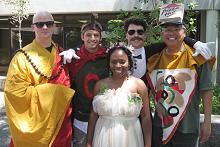 Representatives from CTAHR’s departments and Administration competed for best costume design and fastest ice cream-eating at the 23rd Annual Welcome Back Ice Cream Bash on Sept. 12 in the Sherman Courtyard. CTAHR students, faculty, and staff assembled to enjoy a variety of frozen treats—graciously provided, once again, by Meadow Gold Dairies of Hawai‘i. Debuting this year there was also a delicious sorbet created by Corilee Watters (HNFAS) and Alvin Huang (HNFAS), along with students Karl Sloss, Scott Iwamura, and David St. Jules, made from a variety of locally grown mangoes—38 pounds of them—generously provided by Makaha farmer Mark Suiso. Competing in this year’s contests were A’rel Boies (FCS), Nate Black (HNFAS), Edward Drielak (MBBE), Philip Potter (NREM), Jordie Ocenar (PEPS), and Adrian Lee (Admin.). Congratulations to winners A’rel Boies (costume contest) and Nate Black (ice cream-eating contest). Monetary donations were collected to benefit Kokua Hawaii Foundation, which works to foster a sense of appreciation for the environment in young children so that they become lifelong stewards of the land. A big mahalo to Meadow Gold Dairies of Hawai‘i for their continuous support of CTAHR, Ryan Kurasaki and Charlie Nelson, the HNFAS and NREM departments, Ray Uchida of the O‘ahu Extension Office, Lito Cacho and Richard Fisher of Pearl City Urban Garden Center, and the ice cream scoopers, who scooped a whopping 34 gallons of ice cream and sorbet. Thank you also to everyone who made the Welcome Back Ice Cream Bash a resounding success! Representatives from CTAHR’s departments and Administration competed for best costume design and fastest ice cream-eating at the 23rd Annual Welcome Back Ice Cream Bash on Sept. 12 in the Sherman Courtyard. CTAHR students, faculty, and staff assembled to enjoy a variety of frozen treats—graciously provided, once again, by Meadow Gold Dairies of Hawai‘i. Debuting this year there was also a delicious sorbet created by Corilee Watters (HNFAS) and Alvin Huang (HNFAS), along with students Karl Sloss, Scott Iwamura, and David St. Jules, made from a variety of locally grown mangoes—38 pounds of them—generously provided by Makaha farmer Mark Suiso. Competing in this year’s contests were A’rel Boies (FCS), Nate Black (HNFAS), Edward Drielak (MBBE), Philip Potter (NREM), Jordie Ocenar (PEPS), and Adrian Lee (Admin.). Congratulations to winners A’rel Boies (costume contest) and Nate Black (ice cream-eating contest). Monetary donations were collected to benefit Kokua Hawaii Foundation, which works to foster a sense of appreciation for the environment in young children so that they become lifelong stewards of the land. A big mahalo to Meadow Gold Dairies of Hawai‘i for their continuous support of CTAHR, Ryan Kurasaki and Charlie Nelson, the HNFAS and NREM departments, Ray Uchida of the O‘ahu Extension Office, Lito Cacho and Richard Fisher of Pearl City Urban Garden Center, and the ice cream scoopers, who scooped a whopping 34 gallons of ice cream and sorbet. Thank you also to everyone who made the Welcome Back Ice Cream Bash a resounding success!
|
Putting the “T” in CTAHR
9/21/2011 Source: Office of Communication Services, CTAHR 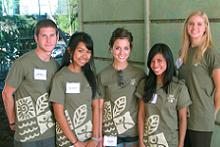 CTAHR’s Academic and Student Affairs Office needed a fresh new “uniform” for its Scholarship Recipients and Student Ambassadors and called upon the Office of Communication Services to design it. The new design, which sports the familiar CTAHR petroglyph, was so well received that OCS decided to increase the order and sell the shirts to others who want to show their CTAHR pride. The shirts are $10 and can be purchased from Gilmore 119. Off-campus friends can download an order form here. Purists don't need to worry—the embroidered CTAHR polo shirts are still available as well. CTAHR’s Academic and Student Affairs Office needed a fresh new “uniform” for its Scholarship Recipients and Student Ambassadors and called upon the Office of Communication Services to design it. The new design, which sports the familiar CTAHR petroglyph, was so well received that OCS decided to increase the order and sell the shirts to others who want to show their CTAHR pride. The shirts are $10 and can be purchased from Gilmore 119. Off-campus friends can download an order form here. Purists don't need to worry—the embroidered CTAHR polo shirts are still available as well.
|
Sending Over the Rainbow
9/7/2011 Source: Office of Communication Services, CTAHR 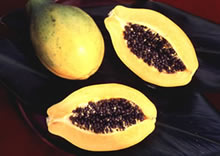 CTAHR’s
genetically altered Rainbow papaya will have a greatly expanded marketplace now
that Japan has agreed to import the fruit. This will be the first genetically
modified fruit that Japan has imported. The lead story in the Star-Advertiser on Sept. 2 explained that Japan’s consumer affairs
officials required that tests be conducted to prove that the fruit is safe for
consumption; approval took about 10 years, but it was proven that the “Rainbow
papaya is chemically no different than naturally grown papaya.” CTAHR
researchers and Dr. Dennis Gonsalves (then at Cornell University and currently director of USDA PBARC in Hilo) developed the Rainbow in response to the devastating ringspot virus
that decimated the Hawai‘i papaya industry in the 1990s; the modified fruit is
resistant to the disease, which means farmers don’t need to use expensive and
destructive pesticides against it. CTAHR’s
genetically altered Rainbow papaya will have a greatly expanded marketplace now
that Japan has agreed to import the fruit. This will be the first genetically
modified fruit that Japan has imported. The lead story in the Star-Advertiser on Sept. 2 explained that Japan’s consumer affairs
officials required that tests be conducted to prove that the fruit is safe for
consumption; approval took about 10 years, but it was proven that the “Rainbow
papaya is chemically no different than naturally grown papaya.” CTAHR
researchers and Dr. Dennis Gonsalves (then at Cornell University and currently director of USDA PBARC in Hilo) developed the Rainbow in response to the devastating ringspot virus
that decimated the Hawai‘i papaya industry in the 1990s; the modified fruit is
resistant to the disease, which means farmers don’t need to use expensive and
destructive pesticides against it.
|
Wearable Art
9/7/2011 Source: Office of Communication Services, CTAHR  Five APDM students will
have their designs shown at the 2011 International Textile and Apparel
Association’s meeting in Philadelphia in November. The designs went through a
rigorous double-blind peer-review process, and the acceptance rate was 39%. The
talented students are Bryant DesBrisay, Jaclyn Santos, Misha Pyle, Anna Tomita,
and Joelle Perry—who had 3 designs accepted, including “Sable,” pictured. All
designs were conceived and produced under the direction of Cynthia Tsark (FCS). Five APDM students will
have their designs shown at the 2011 International Textile and Apparel
Association’s meeting in Philadelphia in November. The designs went through a
rigorous double-blind peer-review process, and the acceptance rate was 39%. The
talented students are Bryant DesBrisay, Jaclyn Santos, Misha Pyle, Anna Tomita,
and Joelle Perry—who had 3 designs accepted, including “Sable,” pictured. All
designs were conceived and produced under the direction of Cynthia Tsark (FCS).
|
Investing in the Future of Agriculture
9/7/2011 Source: Office of Communication Services, CTAHR 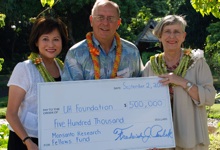 CTAHR has been given a $500,000 donation from Monsanto
Corporation to establish the Monsanto Research Fellows Fund, which will be used
to support graduate research assistants at the MS and PhD level, as well as
post-doctoral fellows in plant sciences and protection. The selection of those
funded will rest entirely in CTAHR’s hands, nor are there any stipulations
concerning the research they undertake. Eligible
students will be able to enhance their educational and professional development
through fellowship programs, which will include financial support for student
research and participation in national professional conferences. Pictured are Dean Sylvia Yuen; Fred Perlak, vice president
of research and business operations for Monsanto in Hawai‘i; and Chancellor Hinshaw. CTAHR has been given a $500,000 donation from Monsanto
Corporation to establish the Monsanto Research Fellows Fund, which will be used
to support graduate research assistants at the MS and PhD level, as well as
post-doctoral fellows in plant sciences and protection. The selection of those
funded will rest entirely in CTAHR’s hands, nor are there any stipulations
concerning the research they undertake. Eligible
students will be able to enhance their educational and professional development
through fellowship programs, which will include financial support for student
research and participation in national professional conferences. Pictured are Dean Sylvia Yuen; Fred Perlak, vice president
of research and business operations for Monsanto in Hawai‘i; and Chancellor Hinshaw.
|
Service With a Smile
9/7/2011 Source: Office of Communication Services, CTAHR 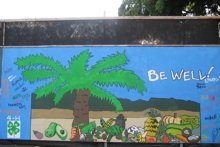 The youngest members of the
CTAHR ‘ohana, the Hawai‘i 4-H members, brightened up the scenery on the Manoa campus when they spent a week this summer learning with faculty and students from the college, doing service-learning
projects, and making new friends with the other 92 participants. Adam Baker
(MBBE), John Barrett (HNFAS), Brent Buckley (HNFAS), Gayle Hori (TPSS), Mary
Martini (FCS), Ted Radovich (TPSS), Roney, Rose Saito (FCS), Rebecca Settlage
(FCS), Ania Wieczorek (TPSS), and Halina Zaleski (HNFAS) all engaged the youth
in activities to teach science concepts that these young mentors will use with
their 4-H groups back home. Bullying, career preparation, drug and alcohol abuse, and social media were discussed by youth and guest speakers. Dean Sylvia
Yuen and FCS Chair Bobbie Yee welcomed the group at a dinner honoring Dean
Okimoto, 2011 Hawai‘i 4-H ‘Ali‘i. The teens who planned the conference had
specifically asked to have an opportunity to provide service while they were in
Manoa. A healthy-living mural on the construction wall behind Miller, visits
with senior citizens in a daycare center, landscaping at the Energy House, and
grounds improvement at the Lyons Arboretum all gave the teens an opportunity to
apply some of what they have learned in 4-H in community service. The youngest members of the
CTAHR ‘ohana, the Hawai‘i 4-H members, brightened up the scenery on the Manoa campus when they spent a week this summer learning with faculty and students from the college, doing service-learning
projects, and making new friends with the other 92 participants. Adam Baker
(MBBE), John Barrett (HNFAS), Brent Buckley (HNFAS), Gayle Hori (TPSS), Mary
Martini (FCS), Ted Radovich (TPSS), Roney, Rose Saito (FCS), Rebecca Settlage
(FCS), Ania Wieczorek (TPSS), and Halina Zaleski (HNFAS) all engaged the youth
in activities to teach science concepts that these young mentors will use with
their 4-H groups back home. Bullying, career preparation, drug and alcohol abuse, and social media were discussed by youth and guest speakers. Dean Sylvia
Yuen and FCS Chair Bobbie Yee welcomed the group at a dinner honoring Dean
Okimoto, 2011 Hawai‘i 4-H ‘Ali‘i. The teens who planned the conference had
specifically asked to have an opportunity to provide service while they were in
Manoa. A healthy-living mural on the construction wall behind Miller, visits
with senior citizens in a daycare center, landscaping at the Energy House, and
grounds improvement at the Lyons Arboretum all gave the teens an opportunity to
apply some of what they have learned in 4-H in community service.
|
August
Fish Gasses
8/31/2011 Source: Office of Communication Services, CTAHR  The
National Research Foundation of Korea, the equivalent of the National Science
Foundation in the U.S., has awarded a 3-year, $300,000 research grant to a
Global Research Network Program team of international researchers led by Samir
Khanal (MBBE), along with Jaewoo Li of Korea University and Kartik Chandran of
Columbia University. In this study, the nitrous oxide emissions from
aquaculture in Hawai‘i will be compared with those of Korea and other Asian
countries to develop a global mapping of N2O emission from
aquaculture and its effects on climate change. Samir received a Hatch grant to
initiate the research in CTAHR, which eventually led to the development of a
full-proposal for the funded project. The
National Research Foundation of Korea, the equivalent of the National Science
Foundation in the U.S., has awarded a 3-year, $300,000 research grant to a
Global Research Network Program team of international researchers led by Samir
Khanal (MBBE), along with Jaewoo Li of Korea University and Kartik Chandran of
Columbia University. In this study, the nitrous oxide emissions from
aquaculture in Hawai‘i will be compared with those of Korea and other Asian
countries to develop a global mapping of N2O emission from
aquaculture and its effects on climate change. Samir received a Hatch grant to
initiate the research in CTAHR, which eventually led to the development of a
full-proposal for the funded project.
|
4-H Helping Military Kids
8/31/2011 Source: Office of Communication Services, CTAHR 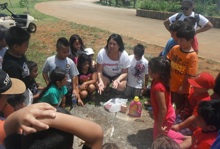 For a week this summer, 75
military youth in Saipan ages 5 to 12 years old took part in the Army Reserve
Enrichment Camp (AREC) at the Marianas Trekking Eco Camp located in Marpi,
Saipan. Kiki Yoshimoto (Extension 4-H), Hawai‘i’s Operation: Military Kids
(OMK) project coordinator, worked with the Army Reserves’ Child Youth and
School Services Staff to provide campers with OMK learning activities that
focused on life skills to help them during the deployment of a
loved one. Ten Army Reserve Soldiers made a special visit to the camp to help
conduct Military Day, on which campers could learn what their parents
experience as military personnel. OMK,
which is implemented through the 4-H/Youth Development Program,
is the U.S. Army’s collaborative effort to support children and youth impacted
by deployment. “I learned about teamwork and listening, and I liked when the
Army Reserve showed up and taught us how to march and sing,” said Noah, a
10-year-old AREC participant. Ben, a 12-year-old camp participant, added, “My
dad is deployed, and I liked how the soldiers took the time to come to the
camp.” For a week this summer, 75
military youth in Saipan ages 5 to 12 years old took part in the Army Reserve
Enrichment Camp (AREC) at the Marianas Trekking Eco Camp located in Marpi,
Saipan. Kiki Yoshimoto (Extension 4-H), Hawai‘i’s Operation: Military Kids
(OMK) project coordinator, worked with the Army Reserves’ Child Youth and
School Services Staff to provide campers with OMK learning activities that
focused on life skills to help them during the deployment of a
loved one. Ten Army Reserve Soldiers made a special visit to the camp to help
conduct Military Day, on which campers could learn what their parents
experience as military personnel. OMK,
which is implemented through the 4-H/Youth Development Program,
is the U.S. Army’s collaborative effort to support children and youth impacted
by deployment. “I learned about teamwork and listening, and I liked when the
Army Reserve showed up and taught us how to march and sing,” said Noah, a
10-year-old AREC participant. Ben, a 12-year-old camp participant, added, “My
dad is deployed, and I liked how the soldiers took the time to come to the
camp.”
|
Yay, DNA Today!
8/31/2011 Source: Office of Communication Services, CTAHR 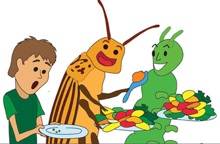 Ania
Wieczorek’s (TPSS) new Web site DNA Today is up and
running. The site is a resource for the general public as well as for
classrooms at the 7th- to 12th-grade level and emphasizes biotechnology in
agriculture being used in Hawai‘i. With its bold graphics, bite-sized morsels
of intriguing information, and even-handed approach to controversial topics, the site
ought to be a hit—and a help. Ania
Wieczorek’s (TPSS) new Web site DNA Today is up and
running. The site is a resource for the general public as well as for
classrooms at the 7th- to 12th-grade level and emphasizes biotechnology in
agriculture being used in Hawai‘i. With its bold graphics, bite-sized morsels
of intriguing information, and even-handed approach to controversial topics, the site
ought to be a hit—and a help.
|
A Warm Welcome
8/31/2011 Source: Office of Communication Services, CTAHR 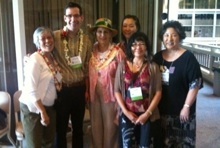 Chancellor
Virginia Hinshaw recently welcomed three new CTAHR faculty, Thao Le and Young Jin Bahng (both FCS) and Steven Gray (NREM), at a new faculty reception. Chairs Cathy
Chan-Halbrendt (NREM) and Bobbie Yee (FCS) also attended. Thao Le’s research areas include developing, implementing, and
evaluating programs to foster positive youth development and resiliency across
the lifespan. She is also interested in mindfulness/contemplative sciences;
multicultural, indigenous, and Asian American populations; and military
youth and families. Young Jin Bahng, Assistant Professor for International
Merchandising in FCS, is currently teaching APDM437: Small Business Start-Up
and APDM 471: International Apparel Trade Issues. Her research interests
include developing retail buying models based on the use of retail inventory
assortment decision factors, consumer market segmentation, and the effect of
globalization on small businesses. Steven Gray’s research focuses on
understanding the “human dimensions” of natural resource management by
integrating human population datasets with datasets generated by traditional
ecological studies. His current research project examines the relationship
between how people make sense of complex environments, how this understanding
influences decision-making, and how these decisions impact ecosystem structure
and function. The three are enthusiastically welcomed to the CTAHR ‘ohana. Pictured, from left to right: Cathy Chan-Halbrendt, Steven Gray, Chancellor Hinshaw, Young Jin Bahng, Thao Le, and Bobbie Yee. Chancellor
Virginia Hinshaw recently welcomed three new CTAHR faculty, Thao Le and Young Jin Bahng (both FCS) and Steven Gray (NREM), at a new faculty reception. Chairs Cathy
Chan-Halbrendt (NREM) and Bobbie Yee (FCS) also attended. Thao Le’s research areas include developing, implementing, and
evaluating programs to foster positive youth development and resiliency across
the lifespan. She is also interested in mindfulness/contemplative sciences;
multicultural, indigenous, and Asian American populations; and military
youth and families. Young Jin Bahng, Assistant Professor for International
Merchandising in FCS, is currently teaching APDM437: Small Business Start-Up
and APDM 471: International Apparel Trade Issues. Her research interests
include developing retail buying models based on the use of retail inventory
assortment decision factors, consumer market segmentation, and the effect of
globalization on small businesses. Steven Gray’s research focuses on
understanding the “human dimensions” of natural resource management by
integrating human population datasets with datasets generated by traditional
ecological studies. His current research project examines the relationship
between how people make sense of complex environments, how this understanding
influences decision-making, and how these decisions impact ecosystem structure
and function. The three are enthusiastically welcomed to the CTAHR ‘ohana. Pictured, from left to right: Cathy Chan-Halbrendt, Steven Gray, Chancellor Hinshaw, Young Jin Bahng, Thao Le, and Bobbie Yee.
|
Longtime Dedication
8/25/2011 Source: Office of Communication Services, CTAHR 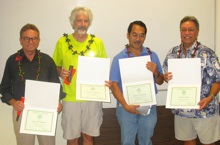 HNFAS recently honored four individuals who have collectively provided over 140 years of service to the department, CTAHR, and UHM. Left to right are pictured Spencer Malecha, Steve Spielman, Stuart Nakamoto, and Wayne Toma. Spencer, one of the world’s leading experts in shrimp and prawn aquaculture, has worked as a researcher and professor for 40 years. Steve, a research associate for 30 years, was originally hired to provide technical support for analyzing samples on the department’s gas chromatographs and now provides technical support to maintain the entire Agricultural Sciences Building, while supporting the research faculty in the department. An Extension agricultural economist for 30 years, Stuart has most recently been working to develop two high-value crops for Hawai‘i, tea and blueberries. He is also the leader of Hawai‘i’s program to assist farmers in risk management. Wayne has been HNFAS’ IT and computer specialist for 40 years. When he was hired as a computer specialist, information technology involved entering individual data points on punch cards for UH’s mainframe computer. Besides assisting faculty with computing needs, Wayne also manages CTAHR’s computer lab in Ag Sciences. The department thanks these dedicated faculty and staff members for their hard work and service! HNFAS recently honored four individuals who have collectively provided over 140 years of service to the department, CTAHR, and UHM. Left to right are pictured Spencer Malecha, Steve Spielman, Stuart Nakamoto, and Wayne Toma. Spencer, one of the world’s leading experts in shrimp and prawn aquaculture, has worked as a researcher and professor for 40 years. Steve, a research associate for 30 years, was originally hired to provide technical support for analyzing samples on the department’s gas chromatographs and now provides technical support to maintain the entire Agricultural Sciences Building, while supporting the research faculty in the department. An Extension agricultural economist for 30 years, Stuart has most recently been working to develop two high-value crops for Hawai‘i, tea and blueberries. He is also the leader of Hawai‘i’s program to assist farmers in risk management. Wayne has been HNFAS’ IT and computer specialist for 40 years. When he was hired as a computer specialist, information technology involved entering individual data points on punch cards for UH’s mainframe computer. Besides assisting faculty with computing needs, Wayne also manages CTAHR’s computer lab in Ag Sciences. The department thanks these dedicated faculty and staff members for their hard work and service!
|
Rats, a Lungworm!
8/25/2011 Source: Office of Communication Services, CTAHR 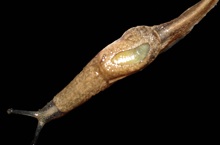 Jim Hollyer (PEPS); Robert Cowie, a researcher in the Pacific Biosciences Research Center (PBRC); and colleagues at the U.S. Department of Agriculture in Hilo and the Centers for Disease Control in Atlanta held an international workshop on rat lungworm disease on August 17-18. The parasitic infection, often contracted when people accidentally eat an infected slug or snail like the semi-slug (Parmarion martensi) pictured, has recently caused serious illness, including coma, in a number of people in the state. The workshop brought together an international group of experts to develop a concerted research agenda to address this disease worldwide. Though it appears to be a tropical disease, with the increasing spread of invasive alien species to all parts of the world, and with global warming increasing the potential range of the parasite, it is seen as an important emerging infectious disease. Future workshops are being planned for each island that will solicit local input and offer outreach. A team including Jim and Robert Cowie also recently released a fact sheet explaining how to minimize the risks of contracting rat lungworm disease from possibly contaminated produce. Jim Hollyer (PEPS); Robert Cowie, a researcher in the Pacific Biosciences Research Center (PBRC); and colleagues at the U.S. Department of Agriculture in Hilo and the Centers for Disease Control in Atlanta held an international workshop on rat lungworm disease on August 17-18. The parasitic infection, often contracted when people accidentally eat an infected slug or snail like the semi-slug (Parmarion martensi) pictured, has recently caused serious illness, including coma, in a number of people in the state. The workshop brought together an international group of experts to develop a concerted research agenda to address this disease worldwide. Though it appears to be a tropical disease, with the increasing spread of invasive alien species to all parts of the world, and with global warming increasing the potential range of the parasite, it is seen as an important emerging infectious disease. Future workshops are being planned for each island that will solicit local input and offer outreach. A team including Jim and Robert Cowie also recently released a fact sheet explaining how to minimize the risks of contracting rat lungworm disease from possibly contaminated produce.
|
Forest-Making
8/25/2011 Source: Office of Communication Services, CTAHR 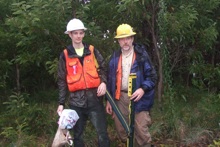 Travis Idol and JB Friday (both NREM) have been involved in the planning, site location, species selection, layout, and general publicizing of the Panawea Zoo Discovery Forest project at the Panaewa Rainforest Zoo & Gardens in Hilo. This project is spearheaded by the Hawaii Forest Industry Association (HFIA) and its educational arm, the Hawaii Forest Institute (HFI), along with a group of community partners, including CTAHR. Plans for the Panaewa Zoo Discovery Forest include a forest demonstrating native Hawaiian plants; an agro-forest demonstrating cultural, medicinal, overstory, midstory, and understory plants; and interpretive materials. The native plan provides a tiered effect of native trees, plants, and groundcovers including naupaka kuahiwi, maile, hapu‘u pulu, kolea, and kopiko. Areas have been prepared for the Native Forest and Agro-forest demonstration plots, and a community volunteer outplanting event is planned for Saturday, Aug. 27, from 9 a.m. to 2 p.m. JB will be on hand, and the project site is located near one of the zoo’s main attractions, Namaste the white Bengal tiger. If you’d like to volunteer, contact Mike Donoho at (808) 936-7526 or kukuiplanning@gmail.com. Travis Idol and JB Friday (both NREM) have been involved in the planning, site location, species selection, layout, and general publicizing of the Panawea Zoo Discovery Forest project at the Panaewa Rainforest Zoo & Gardens in Hilo. This project is spearheaded by the Hawaii Forest Industry Association (HFIA) and its educational arm, the Hawaii Forest Institute (HFI), along with a group of community partners, including CTAHR. Plans for the Panaewa Zoo Discovery Forest include a forest demonstrating native Hawaiian plants; an agro-forest demonstrating cultural, medicinal, overstory, midstory, and understory plants; and interpretive materials. The native plan provides a tiered effect of native trees, plants, and groundcovers including naupaka kuahiwi, maile, hapu‘u pulu, kolea, and kopiko. Areas have been prepared for the Native Forest and Agro-forest demonstration plots, and a community volunteer outplanting event is planned for Saturday, Aug. 27, from 9 a.m. to 2 p.m. JB will be on hand, and the project site is located near one of the zoo’s main attractions, Namaste the white Bengal tiger. If you’d like to volunteer, contact Mike Donoho at (808) 936-7526 or kukuiplanning@gmail.com.
|
Penguins at the Hilton
8/25/2011 Source: Office of Communication Services, CTAHR 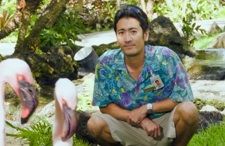 An HNFAS alumnus, Kevin Murata, was featured in the July issue of Malamalama. Kevin, who received his BS in Animal Sciences in 2002, is a wildlife attendant at the Hilton Hawaiian Village and a part-time veterinary technician. He cares for the many exotic birds and fish at the resort, but his primary job is taking care of the blackfooted penguins that frolic and play in their tropical habitat there. (This type of penguin comes from Africa, so Hawai‘i’s lack of ice and snow doesn’t bother them.) He especially likes introducing them to the children at the Village, but he cautions, “A lot of people just assume that these penguins are cuddly little teddy bears, which in truth they’re not. They can inflict major damage.” Good to know! An HNFAS alumnus, Kevin Murata, was featured in the July issue of Malamalama. Kevin, who received his BS in Animal Sciences in 2002, is a wildlife attendant at the Hilton Hawaiian Village and a part-time veterinary technician. He cares for the many exotic birds and fish at the resort, but his primary job is taking care of the blackfooted penguins that frolic and play in their tropical habitat there. (This type of penguin comes from Africa, so Hawai‘i’s lack of ice and snow doesn’t bother them.) He especially likes introducing them to the children at the Village, but he cautions, “A lot of people just assume that these penguins are cuddly little teddy bears, which in truth they’re not. They can inflict major damage.” Good to know!
|
Kids Count on COF
8/25/2011 Source: Office of Communication Services, CTAHR  The Center on the Family is the Hawai‘i affiliate for the Annie E. Casey Foundation’s KIDS COUNT initiative, which tracks indicators of children’s well-being nationwide and state by state. The Foundation’s 2011 KIDS COUNT Data Book, which was released last week, offers some worrisome indicators of children’s and teens’ status in Hawai‘i—and a few rays of hope as well. There has been a rise, since 2000, in the percentage of low-birthweight babies, high school dropouts, children in poverty, and children in single-parent families. The child death rate rose, as well. Hawai‘i’s overall rank in a composite index of child well-being has gone from 11th in the nation in the mid-2000s to 26th, based on the most recent data. Several indicators tracked in the Data Book reflect the general economic problems of the state and the country, such as number of children impacted by foreclosure (14,000 since 2007) and living in households with at least one unemployed parent (25,000). Ivette Stern (COF), head of Hawai‘i KIDS COUNT, points out the “link between family income and economic stability, and children's academic achievement and later success.” Grace Fong, director of COF, cautions, “While there are many complex factors that have contributed to this decline over the past several years, this downward trend cannot be ignored. The investments we make in our children now are investments we make in our state's future.” The news isn’t all bad, though: There have been improvements in the infant mortality rate and the teen death rate, and a lowering of the teen birth rate in the state since 2000. The Center on the Family is the Hawai‘i affiliate for the Annie E. Casey Foundation’s KIDS COUNT initiative, which tracks indicators of children’s well-being nationwide and state by state. The Foundation’s 2011 KIDS COUNT Data Book, which was released last week, offers some worrisome indicators of children’s and teens’ status in Hawai‘i—and a few rays of hope as well. There has been a rise, since 2000, in the percentage of low-birthweight babies, high school dropouts, children in poverty, and children in single-parent families. The child death rate rose, as well. Hawai‘i’s overall rank in a composite index of child well-being has gone from 11th in the nation in the mid-2000s to 26th, based on the most recent data. Several indicators tracked in the Data Book reflect the general economic problems of the state and the country, such as number of children impacted by foreclosure (14,000 since 2007) and living in households with at least one unemployed parent (25,000). Ivette Stern (COF), head of Hawai‘i KIDS COUNT, points out the “link between family income and economic stability, and children's academic achievement and later success.” Grace Fong, director of COF, cautions, “While there are many complex factors that have contributed to this decline over the past several years, this downward trend cannot be ignored. The investments we make in our children now are investments we make in our state's future.” The news isn’t all bad, though: There have been improvements in the infant mortality rate and the teen death rate, and a lowering of the teen birth rate in the state since 2000.
|
Garden Menaces and More
8/25/2011 Source: Office of Communication Services, CTAHR 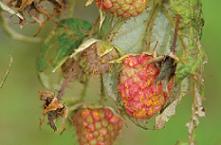 Sporulating uredinia! Necrotic petioles! Erumpant and crustose lesions! These are only a few of the warning signs that your innocent-looking plants may be infected with disturbing pathogens. A recent publication by Scot Nelson (PEPS), Fred Brooks (PEPS), and Glen Teves (TPSS), “Taro Leaf Blight in Hawai'i,” details the causes, symptoms, and possible cures of this economically important plant disease. In “Raspberry Late Leaf Rust in Hawai‘i Caused by Pucciniastrum americanum,” Scot explains a possible downfall of the would-be raspberry farmer—infected drupelets. You simply can’t sell berries with infected drupelets. If it’s a fluorescent pseudomonad you’re faced with, creating shot-holes in your abaxial leaf surfaces, it just might be “Bacterial Leaf Spot of Hibiscus in Hawai‘i,” also by Scot, while if there are fuzzy black telia on the undersides of your bamboo leaves you may be plagued with “Kweilingia Rust of Bamboo in Hawai‘i.” The disease, that is, not the publication, which is by Scot and Matthew Goo. Undaunted by Kweilingia rust and determined to grow some bamboo? Kheng T. Cheah and Lee C. Chaille (both TPSS) offer a tissue culture protocol for somatic embryogenesis from mature bamboo. In “Somatic Embryogenesis From Mature Bambusa ventricosa,” each stage is carefully explained, from the excision of the necrotic mother tissue to the development of embryonic calli to the growth of beautiful bamboo. With no sporulating uredinia. Sporulating uredinia! Necrotic petioles! Erumpant and crustose lesions! These are only a few of the warning signs that your innocent-looking plants may be infected with disturbing pathogens. A recent publication by Scot Nelson (PEPS), Fred Brooks (PEPS), and Glen Teves (TPSS), “Taro Leaf Blight in Hawai'i,” details the causes, symptoms, and possible cures of this economically important plant disease. In “Raspberry Late Leaf Rust in Hawai‘i Caused by Pucciniastrum americanum,” Scot explains a possible downfall of the would-be raspberry farmer—infected drupelets. You simply can’t sell berries with infected drupelets. If it’s a fluorescent pseudomonad you’re faced with, creating shot-holes in your abaxial leaf surfaces, it just might be “Bacterial Leaf Spot of Hibiscus in Hawai‘i,” also by Scot, while if there are fuzzy black telia on the undersides of your bamboo leaves you may be plagued with “Kweilingia Rust of Bamboo in Hawai‘i.” The disease, that is, not the publication, which is by Scot and Matthew Goo. Undaunted by Kweilingia rust and determined to grow some bamboo? Kheng T. Cheah and Lee C. Chaille (both TPSS) offer a tissue culture protocol for somatic embryogenesis from mature bamboo. In “Somatic Embryogenesis From Mature Bambusa ventricosa,” each stage is carefully explained, from the excision of the necrotic mother tissue to the development of embryonic calli to the growth of beautiful bamboo. With no sporulating uredinia.
|
Go Milk a Snail!
8/17/2011 Source: Office of Communication Services, CTAHR 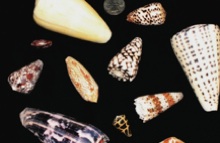 Jon-Paul Bingham (MBBE) will be featured in an hour-long discussion on OC16’s ThinkTech Hawaii about the importance of snails in biochemical research, particularly the possible applications of cone snails’ toxins for pain relief and pesticides. The program airs this Sunday, Aug. 21, at 10:30 p.m., though the video can also be seen online if that's past your bedtime. Though these snails are extremely poisonous, they have the ability to dull the sensation of pain, and a pain medication made from a particular type of cone snail has already been approved by the FDA. How does one extract the toxins from these deadly creatures, you may ask? Why, you milk them, of course! But be very careful. Jon-Paul describes the only person ever to have survived the sting of a certain type of cone snail—20 years later the man’s still in pain, with a wound that won’t heal. Also explained is the complicated life cycle of the rat lungworm and the tortuous process, involving snail slime, by which it can end up on a consumer’s plate—or wreaking havoc with her or his nervous system. Wash that lettuce! Jon-Paul Bingham (MBBE) will be featured in an hour-long discussion on OC16’s ThinkTech Hawaii about the importance of snails in biochemical research, particularly the possible applications of cone snails’ toxins for pain relief and pesticides. The program airs this Sunday, Aug. 21, at 10:30 p.m., though the video can also be seen online if that's past your bedtime. Though these snails are extremely poisonous, they have the ability to dull the sensation of pain, and a pain medication made from a particular type of cone snail has already been approved by the FDA. How does one extract the toxins from these deadly creatures, you may ask? Why, you milk them, of course! But be very careful. Jon-Paul describes the only person ever to have survived the sting of a certain type of cone snail—20 years later the man’s still in pain, with a wound that won’t heal. Also explained is the complicated life cycle of the rat lungworm and the tortuous process, involving snail slime, by which it can end up on a consumer’s plate—or wreaking havoc with her or his nervous system. Wash that lettuce!
|
Business Plan Champs
8/17/2011 Source: Office of Communication Services, CTAHR 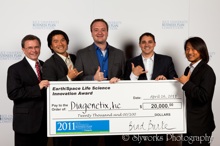 Diagenetix, a research team/company headed by Ryo Kubota (PhD student, MBBE) recently won $20,000 at Rice University’s Business Plan Competition. The team, which also includes MBBE graduate Scott Shibata, MBA/JD student Kahlan Salina, and MBA student David Schmidt, is the first from Hawai‘i to have qualified for this prestigious event. It’s the biggest business plan competition in the world, with hand-picked teams competing for over $1.3 million in prizes. The Diagenetix members were awarded NASA’s Best Earth/Space Life Science Innovation Award for the pioneering and timely product they have invented and intend to market, a hand-held device that identifies the bacteria and viruses that cause numerous infectious diseases. The team also won the grand prize at UH’s Shidler Business Plan Competition in 2010. Both Ryo and Scott are mentored by Daniel Jenkins (MBBE). From left to right: Jeffrey Davis, Scott Shibata, Kahlan Salina, David Schmidt, and Ryo Kubota. Diagenetix, a research team/company headed by Ryo Kubota (PhD student, MBBE) recently won $20,000 at Rice University’s Business Plan Competition. The team, which also includes MBBE graduate Scott Shibata, MBA/JD student Kahlan Salina, and MBA student David Schmidt, is the first from Hawai‘i to have qualified for this prestigious event. It’s the biggest business plan competition in the world, with hand-picked teams competing for over $1.3 million in prizes. The Diagenetix members were awarded NASA’s Best Earth/Space Life Science Innovation Award for the pioneering and timely product they have invented and intend to market, a hand-held device that identifies the bacteria and viruses that cause numerous infectious diseases. The team also won the grand prize at UH’s Shidler Business Plan Competition in 2010. Both Ryo and Scott are mentored by Daniel Jenkins (MBBE). From left to right: Jeffrey Davis, Scott Shibata, Kahlan Salina, David Schmidt, and Ryo Kubota.
|
Helping MOOOve Hawai‘i Beef to the Top
8/17/2011 Source: Office of Communication Services, CTAHR  Ashley Stokes (HNFAS) coordinated CTAHR’s first Beef Herd Breeding and Artificial Insemination summer course. Manoa students traveled to Kamuela, on the Big Island, to attend lectures and gain hands-on experience at the Mealani Research Station; Douglas Vincent and Michael Duponte (both HNFAS) also offered instruction. The ANSC499 class visited Ponoholo Ranch, Parker Ranch, and Spencer Akana’s Ranch to see each ranch’s unique breeding and AI management program. Jill Mattos of Hawaii Beef Producers invited the class to tour their slaughter and processing facilities for the beef industry, and Glen Fukumoto (HNFAS, Extension) explained carcass evaluation and the USDA grading system. Finally, students were challenged to successfully AI cows and withstand the “not so glorious” elements of the job. Each one came through with flying colors—along with cramped arm muscles and plenty of sweat. Ashley Stokes (HNFAS) coordinated CTAHR’s first Beef Herd Breeding and Artificial Insemination summer course. Manoa students traveled to Kamuela, on the Big Island, to attend lectures and gain hands-on experience at the Mealani Research Station; Douglas Vincent and Michael Duponte (both HNFAS) also offered instruction. The ANSC499 class visited Ponoholo Ranch, Parker Ranch, and Spencer Akana’s Ranch to see each ranch’s unique breeding and AI management program. Jill Mattos of Hawaii Beef Producers invited the class to tour their slaughter and processing facilities for the beef industry, and Glen Fukumoto (HNFAS, Extension) explained carcass evaluation and the USDA grading system. Finally, students were challenged to successfully AI cows and withstand the “not so glorious” elements of the job. Each one came through with flying colors—along with cramped arm muscles and plenty of sweat.
What ensured this newly introduced course’s success was the teamwork with Mealani Research Station staff, including Marla Fergerstrom (HNFAS), the Farm Manager; Roy Ishizu; Leslie Hasegawa; Lori Hasegawa; and Damien “Sonny” Arruda III), as well as Hawai‘i County Extension’s Russell Nagata. Mealani hosted a cookout on the last day to celebrate—the guest of honor was the station’s own grass-finished rib-eye beef, provided by Kulana Foods, Inc. A big mahalo for partial funding for the course from the USDA/NIFA-funded Agribusiness Education, Training, and Incubation Project, and to all of those who contributed to the success of the class!
|
Goats on the Slopes
8/17/2011 Source: Office of Communication Services, CTAHR 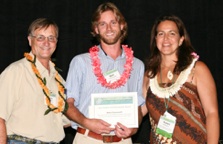 Mark Chynoweth (NREM, Master’s student) received the Best Student Oral Presentation Award at the awards luncheon of the Hawai‘i Conservation Conference held Aug. 2-4. Mark (pictured, center), whose co-advisors are Chris Lepczyk and Creighton Litton (both NREM), is interested in “geospatial analysis of environmental issues to conserve natural resources for future generations.” In a session on “Invasive Species (Feral Mammals),” he gave a presentation on “Movement Patterns and Habitat Utilization of Nonnative Feral Goats in Hawaiian Dryland Montane Landscapes.” Large populations of nonnative, feral goats have been present on five Hawaiian Islands for at least a century, he explains, but little is known about how they use and interact with their environment. Understanding this is essential to managing not only the goats, but also the native and nonnative plants they interact with and disturb. GPS satellite collars were used to track the goats’ movement patterns for a year in the Pohakoloa Training Area; the results of this study will be useful for the conservation and restoration of the native Hawaiian dry forest ecosystem, which is perhaps the most degraded type of ecosystem in the Hawaiian Islands. Mark Chynoweth (NREM, Master’s student) received the Best Student Oral Presentation Award at the awards luncheon of the Hawai‘i Conservation Conference held Aug. 2-4. Mark (pictured, center), whose co-advisors are Chris Lepczyk and Creighton Litton (both NREM), is interested in “geospatial analysis of environmental issues to conserve natural resources for future generations.” In a session on “Invasive Species (Feral Mammals),” he gave a presentation on “Movement Patterns and Habitat Utilization of Nonnative Feral Goats in Hawaiian Dryland Montane Landscapes.” Large populations of nonnative, feral goats have been present on five Hawaiian Islands for at least a century, he explains, but little is known about how they use and interact with their environment. Understanding this is essential to managing not only the goats, but also the native and nonnative plants they interact with and disturb. GPS satellite collars were used to track the goats’ movement patterns for a year in the Pohakoloa Training Area; the results of this study will be useful for the conservation and restoration of the native Hawaiian dry forest ecosystem, which is perhaps the most degraded type of ecosystem in the Hawaiian Islands.
|
A Balanced Meal in a Tank
8/10/2011 Source: Office of Communication Services, CTAHR 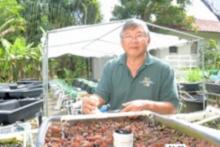 Clyde Tamaru (MBBE) was featured in the August issue of Hawaii Business Magazine, where he describes why tilapia are the best fish in Hawai‘i for aquaponics systems: They can survive swimming around in their own waste products better than most other fish. This is a necessary trait, as it’s these very waste products, including ammonia and nitrogen, that nourish the hydroponically grown plants. But don’t think badly of tilapia, says Clyde—they’re being served in some of the Islands’ finest restaurants, including Alan Wong’s. The system is not only sustainable—it’s potentially gourmet. What could be better? Clyde Tamaru (MBBE) was featured in the August issue of Hawaii Business Magazine, where he describes why tilapia are the best fish in Hawai‘i for aquaponics systems: They can survive swimming around in their own waste products better than most other fish. This is a necessary trait, as it’s these very waste products, including ammonia and nitrogen, that nourish the hydroponically grown plants. But don’t think badly of tilapia, says Clyde—they’re being served in some of the Islands’ finest restaurants, including Alan Wong’s. The system is not only sustainable—it’s potentially gourmet. What could be better?
|
Bee Afraid
8/10/2011 Source: Office of Communication Services, CTAHR 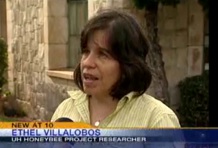 Ethel Villalobos was recently interviewed on KITV News discussing the new honeybee pest that is harming hives on O‘ahu, Maui, Moloka‘i, and the Big Island. The small hive beetle ferments the honey in the hives into a disagreeable slime that causes bees to abandon their colonies. Ethel, who coordinates the UH Honeybee Project, has primarily been engaged in fighting another bee pest, the varroa mite. She says that this beetle is a very damaging adversary: “It can find hives 7 kilometers away.” Ethel Villalobos was recently interviewed on KITV News discussing the new honeybee pest that is harming hives on O‘ahu, Maui, Moloka‘i, and the Big Island. The small hive beetle ferments the honey in the hives into a disagreeable slime that causes bees to abandon their colonies. Ethel, who coordinates the UH Honeybee Project, has primarily been engaged in fighting another bee pest, the varroa mite. She says that this beetle is a very damaging adversary: “It can find hives 7 kilometers away.”
|
Killer Slugs
8/10/2011 Source: Office of Communication Services, CTAHR 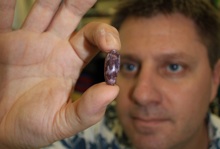 Jon-Paul Bingham (MBBE) will be presenting at the Waikiki Aquarium at their upcoming “Meet the Molluscs” Family Night, Aug. 26, 6:00-8:30, which offers an opportunity to get up close and personal with snails, octopuses, and squid. Jon-Paul will be speaking on “Killer Slugs Who Make Drugs”; with the fascinating and hair-raising information he has to offer, the children attending will probably grow up to be marine biochemists—except for those faint-hearted souls who will refuse to step foot in the water. The program is $10 per person ($12 for non-members); children 2 and under are free. Click here to register. Jon-Paul Bingham (MBBE) will be presenting at the Waikiki Aquarium at their upcoming “Meet the Molluscs” Family Night, Aug. 26, 6:00-8:30, which offers an opportunity to get up close and personal with snails, octopuses, and squid. Jon-Paul will be speaking on “Killer Slugs Who Make Drugs”; with the fascinating and hair-raising information he has to offer, the children attending will probably grow up to be marine biochemists—except for those faint-hearted souls who will refuse to step foot in the water. The program is $10 per person ($12 for non-members); children 2 and under are free. Click here to register.
|
July
Giving Thanks
7/27/2011 Source: Office of Communication Services, CTAHR  CTAHR serves the community—but it’s especially nice when different departments can help each other as well. Naomi Kanehiro (Extension, HNFAS) recently expressed gratitude for the work of FCS: “Family Resources graduates do wonderful things in the community.” Specifically, Samantha Tsoi (Fam-R alumna) was able to offer Naomi’s family help and support. Naomi continued, “As our population ages, many of us find ourselves caregiving for aging relatives and facing end-of-life situations. We can benefit from gerontology professionals and need their help. A very special Auntie that we had been caring for was in a nursing facility for several months and died there. Samantha is the social worker at the facility and was so essential in us getting through a very difficult time. She was gentle, calm and caring. She was able to communicate with Auntie and talked-story with her. Samantha greeted and put family members at ease and made us comfortable with facing end-of-life issues. Much gratitude and thanks to Samantha Tsoi and the Department of Family and Consumer Sciences.” Naomi also points out, “Gerontological careers are a growing and important life path...meeting the needs of families of aging relatives is a noble undertaking.” And so is offering thanks to these often-underappreciated caregivers. Naomi is pictured on the left, with Samantha, middle, and Barbara Yee (Chair, FCS), right. CTAHR serves the community—but it’s especially nice when different departments can help each other as well. Naomi Kanehiro (Extension, HNFAS) recently expressed gratitude for the work of FCS: “Family Resources graduates do wonderful things in the community.” Specifically, Samantha Tsoi (Fam-R alumna) was able to offer Naomi’s family help and support. Naomi continued, “As our population ages, many of us find ourselves caregiving for aging relatives and facing end-of-life situations. We can benefit from gerontology professionals and need their help. A very special Auntie that we had been caring for was in a nursing facility for several months and died there. Samantha is the social worker at the facility and was so essential in us getting through a very difficult time. She was gentle, calm and caring. She was able to communicate with Auntie and talked-story with her. Samantha greeted and put family members at ease and made us comfortable with facing end-of-life issues. Much gratitude and thanks to Samantha Tsoi and the Department of Family and Consumer Sciences.” Naomi also points out, “Gerontological careers are a growing and important life path...meeting the needs of families of aging relatives is a noble undertaking.” And so is offering thanks to these often-underappreciated caregivers. Naomi is pictured on the left, with Samantha, middle, and Barbara Yee (Chair, FCS), right.
|
On the Silk Road
7/27/2011 Source: Office of Communication Services, CTAHR 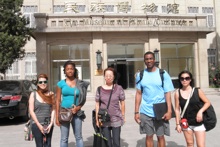 Shu Hwa Lin (FCS) and three
APDM students, Melissa Lee, Rebecca Atkin, and Sebren Khufu, have just returned
from an exciting and educational trip with the China Culture Exchange Study
Tour sponsored by UH-Hilo. Here they’re pictured on the steps of the Museum of
Ethnic Cultures at Mizu University, Beijing. The group also visited Peking
University, where they were hosted by the Department of Philosophy; the White
Horse Temple and Shaolin Kungfu at Luoyang, Henan Province; the Silk Museum in
Nanjing; the Silk Factory and Embroidery Institute in Suzhou; the China Silk
Museum in Hangzhou; and Shanghai. They visited three high schools, where the
students were invited to stay for a more intensive exchange, teaching English
and learning Chinese language and culture. But we’re glad they decided to bring
what they learned there back home, instead. Shu Hwa Lin (FCS) and three
APDM students, Melissa Lee, Rebecca Atkin, and Sebren Khufu, have just returned
from an exciting and educational trip with the China Culture Exchange Study
Tour sponsored by UH-Hilo. Here they’re pictured on the steps of the Museum of
Ethnic Cultures at Mizu University, Beijing. The group also visited Peking
University, where they were hosted by the Department of Philosophy; the White
Horse Temple and Shaolin Kungfu at Luoyang, Henan Province; the Silk Museum in
Nanjing; the Silk Factory and Embroidery Institute in Suzhou; the China Silk
Museum in Hangzhou; and Shanghai. They visited three high schools, where the
students were invited to stay for a more intensive exchange, teaching English
and learning Chinese language and culture. But we’re glad they decided to bring
what they learned there back home, instead.
|
Put Your Branches in the Air!
7/27/2011 Source: Office of Communication Services, CTAHR  James Leary (NREM) and his innovative Herbicide Ballistic Technology (HBT) were featured last week on a local affiliate of NBC News in Wyoming, which was later picked up by MSNBC.com. James has invented a way to adopt pneumatic paintball guns for delivering small gelatin capsules filled with herbicide for controlling invasive plants and trees with surgical precision. In this news segment, he demonstrates their effectiveness against the salt cedar (Tamarix sp.) tree in Wyoming, which is a noxious weed across the western US. Back in Hawai‘i, this technology is being developed to help CTAHR’s
local conservation stakeholders in the fight against even more
aggressive weeds such as Miconia. The HBT projectiles can be used to treat hard-to-reach areas like cliffs and ravines; the technology also makes for reduced disturbance of remote areas and reduces pesticide exposure to the applicator, since the herbicide is safely contained in the small projectiles. A further plus of the inventive idea, as James’s interviewer discovered, is that it actually makes weed control fun! James Leary (NREM) and his innovative Herbicide Ballistic Technology (HBT) were featured last week on a local affiliate of NBC News in Wyoming, which was later picked up by MSNBC.com. James has invented a way to adopt pneumatic paintball guns for delivering small gelatin capsules filled with herbicide for controlling invasive plants and trees with surgical precision. In this news segment, he demonstrates their effectiveness against the salt cedar (Tamarix sp.) tree in Wyoming, which is a noxious weed across the western US. Back in Hawai‘i, this technology is being developed to help CTAHR’s
local conservation stakeholders in the fight against even more
aggressive weeds such as Miconia. The HBT projectiles can be used to treat hard-to-reach areas like cliffs and ravines; the technology also makes for reduced disturbance of remote areas and reduces pesticide exposure to the applicator, since the herbicide is safely contained in the small projectiles. A further plus of the inventive idea, as James’s interviewer discovered, is that it actually makes weed control fun!
|
It's a Dirty Job...
7/27/2011 Source: Office of Communication Services, CTAHR 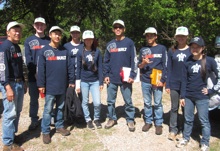 The Maui 4-H
Dirt Devils were recently honored at an awards ceremony held in Kahului to
recognize their national accomplishments at the 60th National Land and Range
Judging Contest held in Oklahoma City. More than 700 FFA and 4-H members from
about 38 states across the US competed May 3-5 to evaluate land characteristics
like topsoil, subsoil, slope, plant life, and suitability of sites for
different uses. Teams and individuals were also required to recommend treatment
to improve the land's adaptability for certain purposes like producing crops,
raising cattle, or building homes. The Dirt Devils qualified for the national
event by winning the county and then the state Land Judging contests earlier in
the year. On Maui, the contest is sponsored by the National Resource Conservation
Service, the Soil and Water Conservation Districts, and CTAHR Cooperative
Extension. The Maui Economic Development Board and Monsanto Corporation
provided additional financial support. Agent Robin Shimabuku provides “train
the trainer” education for the team coaches, while the whole CES-Kahului office
and Maui Master Gardeners help with the local contest event. Team members are
Coleby Hanisch, Taylor Hori, Ashley Malek, Justine Malek, Haley Murayama, Jared
Shimada, Tyler Yamada, and Devin Vinoray; Dr. Daryl Yamada is their advisor.
Tyler Yamada was the national champion, placing 1st in Individual Homesite
Judging; Ashey Malek won 8th place in Individual Land Judging; and the Maui
Dirt Devils as a team placed 4th in Team Land Judging. The Maui 4-H
Dirt Devils were recently honored at an awards ceremony held in Kahului to
recognize their national accomplishments at the 60th National Land and Range
Judging Contest held in Oklahoma City. More than 700 FFA and 4-H members from
about 38 states across the US competed May 3-5 to evaluate land characteristics
like topsoil, subsoil, slope, plant life, and suitability of sites for
different uses. Teams and individuals were also required to recommend treatment
to improve the land's adaptability for certain purposes like producing crops,
raising cattle, or building homes. The Dirt Devils qualified for the national
event by winning the county and then the state Land Judging contests earlier in
the year. On Maui, the contest is sponsored by the National Resource Conservation
Service, the Soil and Water Conservation Districts, and CTAHR Cooperative
Extension. The Maui Economic Development Board and Monsanto Corporation
provided additional financial support. Agent Robin Shimabuku provides “train
the trainer” education for the team coaches, while the whole CES-Kahului office
and Maui Master Gardeners help with the local contest event. Team members are
Coleby Hanisch, Taylor Hori, Ashley Malek, Justine Malek, Haley Murayama, Jared
Shimada, Tyler Yamada, and Devin Vinoray; Dr. Daryl Yamada is their advisor.
Tyler Yamada was the national champion, placing 1st in Individual Homesite
Judging; Ashey Malek won 8th place in Individual Land Judging; and the Maui
Dirt Devils as a team placed 4th in Team Land Judging.
|
Fight Fire With Fire Models
7/27/2011 Source: Office of Communication Services, CTAHR  Lisa Ellsworth, (PhD student, NREM) has received a very
prestigious PhD fellowship from the Joint Fire Science Program to fund part of
her dissertation on fire science and management in Hawai‘i. She was one of 7
students nationally to be honored with this award. Lisa is studying how to
improve fire behavior models for use by land managers in Hawai‘i charged with
reducing fire ignitions and activity (e.g., the Department of Defense). Fire
behavior models are used worldwide for wildfire prevention and management, but
current models, developed on the Mainland, don’t accurately predict when or
where fires will start or how they’ll act in Hawai‘i or other tropical locales.
Specifically, land managers need more accurate and timely data on fuel
moisture, an important variable determining of the possibility of fire
ignitions and behavior. Now they rely on a time-consuming method of physically
determining the moisture levels in guinea grass and other nonnative grasses, which
are a large source of fuel in many degraded habitats in the tropics. Lisa will
develop a readily available way to predict fuel moisture in-situ and real-time,
using a combination of intensive fieldwork and data from the Terra-MODIS
Enhanced Vegetation Index. Lisa, whose advisor is Dr. Creighton M. Litton
(NREM), will be required to publish at least one peer-reviewed article and give
at least one conference presentation about the work she accomplishes with this
award. Lisa Ellsworth, (PhD student, NREM) has received a very
prestigious PhD fellowship from the Joint Fire Science Program to fund part of
her dissertation on fire science and management in Hawai‘i. She was one of 7
students nationally to be honored with this award. Lisa is studying how to
improve fire behavior models for use by land managers in Hawai‘i charged with
reducing fire ignitions and activity (e.g., the Department of Defense). Fire
behavior models are used worldwide for wildfire prevention and management, but
current models, developed on the Mainland, don’t accurately predict when or
where fires will start or how they’ll act in Hawai‘i or other tropical locales.
Specifically, land managers need more accurate and timely data on fuel
moisture, an important variable determining of the possibility of fire
ignitions and behavior. Now they rely on a time-consuming method of physically
determining the moisture levels in guinea grass and other nonnative grasses, which
are a large source of fuel in many degraded habitats in the tropics. Lisa will
develop a readily available way to predict fuel moisture in-situ and real-time,
using a combination of intensive fieldwork and data from the Terra-MODIS
Enhanced Vegetation Index. Lisa, whose advisor is Dr. Creighton M. Litton
(NREM), will be required to publish at least one peer-reviewed article and give
at least one conference presentation about the work she accomplishes with this
award.
|
Kuleana
7/20/2011 Source: Office of Communication Services, CTAHR  The College continues to engage in its broad scope of research interests and pursuits, as evidenced by the range of projects that have been awarded funding in the past several months. Jim Hollyer (PEPS) will be providing education and outreach to farmers on how to keep human pathogens out of their water-based production environments, while Naomi Kanehiro (Extension, HNFAS), will be promoting and supporting quality nutrition services provided by licensed child care providers, which will thereby contribute to the health and safety of the children enrolled. Ji-Yeon Kim (COF) is looking to “support, monitor and report on the substance abuse treatment services provided by agencies funded by the Hawaii Department of Health, Alcohol and Drug Abuse Division, and assist in the development, implementation, and improvement of the Hawai‘i Web-based treatment services information systems.” Charly Kinoshita’s Hawaii AgDiscovery Program will help high school students to experience many aspects of agribusiness and college campus life through field and lab activities, while Christopher Lepczyk (NREM) plans to “Improve Estimates of Game Harvests and Hunting Participation in the State of Hawai`i.” Wei-Wen Winston Su (MBBE, pictured) aims to “develop synthetic oleosomes with multiple functionalities and examine their efficacy as nanoscale carriers for cancer therapy,” and finally, Sarah Yuan will be undertaking data analysis of the homeless in Hawai‘i. Social issues, cutting-edge science, concern for the keiki, and support for those who interact with the ‘aina: all these and more are CTAHR’s kuleana. The College continues to engage in its broad scope of research interests and pursuits, as evidenced by the range of projects that have been awarded funding in the past several months. Jim Hollyer (PEPS) will be providing education and outreach to farmers on how to keep human pathogens out of their water-based production environments, while Naomi Kanehiro (Extension, HNFAS), will be promoting and supporting quality nutrition services provided by licensed child care providers, which will thereby contribute to the health and safety of the children enrolled. Ji-Yeon Kim (COF) is looking to “support, monitor and report on the substance abuse treatment services provided by agencies funded by the Hawaii Department of Health, Alcohol and Drug Abuse Division, and assist in the development, implementation, and improvement of the Hawai‘i Web-based treatment services information systems.” Charly Kinoshita’s Hawaii AgDiscovery Program will help high school students to experience many aspects of agribusiness and college campus life through field and lab activities, while Christopher Lepczyk (NREM) plans to “Improve Estimates of Game Harvests and Hunting Participation in the State of Hawai`i.” Wei-Wen Winston Su (MBBE, pictured) aims to “develop synthetic oleosomes with multiple functionalities and examine their efficacy as nanoscale carriers for cancer therapy,” and finally, Sarah Yuan will be undertaking data analysis of the homeless in Hawai‘i. Social issues, cutting-edge science, concern for the keiki, and support for those who interact with the ‘aina: all these and more are CTAHR’s kuleana.
|
Summer (Meeting) Fun
7/20/2011 Source: Office of Communication Services, CTAHR 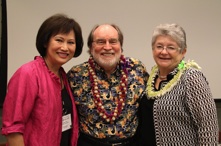 Last week CTAHR hosted a very successful Western Region Joint Summer Meeting, a conference for deans of agriculture and directors of research, instruction, and extension, as well as community advisory board members from the Western states and other Pacific islands. Participants met at the Hilton Waikiki Beach Hotel for 3 days to attend association meetings and hear speeches by “GREAT keynote speakers,” including Governor Neil Abercrombie and UH President M.R.C. Greenwood (both pictured with Dean Sylvia Yuen). Dan Picutta, State Department officer on assignment with the Pacific Command, was the luncheon speaker. Panels shared important information on the Children’s Healthy Living project, led by Rachel Novotny, soil-less farming, headed by Clyde Tamaru, and agrosecurity, led by Barry Brennan. Then participants went on field trips to the Pearl City Urban Garden, Monsanto Hawaii, and MA‘O Farms, where they were able to see the scope of agricultural possibilities in the Islands. There was also a delightful Aloha Dinner at Washington Place, which convinced attendees—not that they needed much convincing—that Hawai‘i is “an amazing setting for some truly engaging and educational sessions.” Last week CTAHR hosted a very successful Western Region Joint Summer Meeting, a conference for deans of agriculture and directors of research, instruction, and extension, as well as community advisory board members from the Western states and other Pacific islands. Participants met at the Hilton Waikiki Beach Hotel for 3 days to attend association meetings and hear speeches by “GREAT keynote speakers,” including Governor Neil Abercrombie and UH President M.R.C. Greenwood (both pictured with Dean Sylvia Yuen). Dan Picutta, State Department officer on assignment with the Pacific Command, was the luncheon speaker. Panels shared important information on the Children’s Healthy Living project, led by Rachel Novotny, soil-less farming, headed by Clyde Tamaru, and agrosecurity, led by Barry Brennan. Then participants went on field trips to the Pearl City Urban Garden, Monsanto Hawaii, and MA‘O Farms, where they were able to see the scope of agricultural possibilities in the Islands. There was also a delightful Aloha Dinner at Washington Place, which convinced attendees—not that they needed much convincing—that Hawai‘i is “an amazing setting for some truly engaging and educational sessions.”
|
X-treme Fruits
7/20/2011 Source: Office of Communication Services, CTAHR 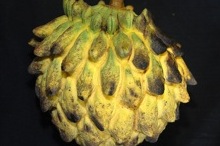 The biggest, the smelliest, the most astringent—Hawai‘i flora can be a realm of extremes. Six new publications in CTAHR’s Fruits and Nuts category tell the story. Did you know that the former Guinness Book of World Records’ largest jackfruit was grown in Hawai‘i? At 79 pounds, it held the record for years, though it’s since been supplanted by a 122-pound monster exhibited in India. (The largest soursop on official record was also grown in Hawai‘i, though it’s a mere 8 pounds and change, and there are reports of larger fruits elsewhere.) Did you know that the jaboticaba will fruit 6 times a year if given sufficient water, and each small tree can produce up to 1,000 pounds of the little purple fruits? Did you even know there was such a fruit as a rollinia (pictured)? (It looks more like something lurking under the bed, but all the hot chefs swear by it.) Here’s an interesting fact: The bilimbi (you might not have known that one either) can indeed be eaten, but if you’re not hungry, you can just use it to clean knife blades and remove rust stains. Not unlike Coca Cola, though probably healthier. Finally, there’s nothing record breaking about the abiu, but don’t overlook the publication detailing its virtues on that account—it includes a recipe for abiu–date sticky toffee pudding with bourbon sauce and vanilla ice cream. So ‘ono! The biggest, the smelliest, the most astringent—Hawai‘i flora can be a realm of extremes. Six new publications in CTAHR’s Fruits and Nuts category tell the story. Did you know that the former Guinness Book of World Records’ largest jackfruit was grown in Hawai‘i? At 79 pounds, it held the record for years, though it’s since been supplanted by a 122-pound monster exhibited in India. (The largest soursop on official record was also grown in Hawai‘i, though it’s a mere 8 pounds and change, and there are reports of larger fruits elsewhere.) Did you know that the jaboticaba will fruit 6 times a year if given sufficient water, and each small tree can produce up to 1,000 pounds of the little purple fruits? Did you even know there was such a fruit as a rollinia (pictured)? (It looks more like something lurking under the bed, but all the hot chefs swear by it.) Here’s an interesting fact: The bilimbi (you might not have known that one either) can indeed be eaten, but if you’re not hungry, you can just use it to clean knife blades and remove rust stains. Not unlike Coca Cola, though probably healthier. Finally, there’s nothing record breaking about the abiu, but don’t overlook the publication detailing its virtues on that account—it includes a recipe for abiu–date sticky toffee pudding with bourbon sauce and vanilla ice cream. So ‘ono!
|
Colors of Summer: Green
7/11/2011 Source: Office of Communication Services, CTAHR 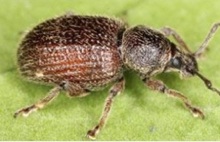 Here's the green light to check out some recent plant-centric publications. Schools looking to go green will be helped by a discussion of “Student and Food Safety: Best Practices for Hawai‘i School Gardens,” which lists important things to remember and beware of when setting up a school garden, including poisonous plants, sunstroke, sharp garden tools, improperly applied pesticides, and natural pests and contaminants. It also discusses what it means to go organic and how to become certified, as well as how to set up a farm stand. Commercial growers will need to know about “The Produce Traceability Intitiative,” a voluntary approach to labeling and tracking produce. In the case of food-borne illnesses, which have been becoming increasingly common, it’s helpful to know exactly what farm that spinach or those bean sprouts originated from. Finally, growers and gardeners will be aided by the beautifully designed poster “Most Unwanted Pests in the United States,” a creepy-crawly collection of thrips, scales, mealybugs, and more, including the wingless weevil pictured here, photographed by Christoph Benisch. Check the poster out to keep this group off your ‘ohelo berries, anthuriums, and school gardens! Here's the green light to check out some recent plant-centric publications. Schools looking to go green will be helped by a discussion of “Student and Food Safety: Best Practices for Hawai‘i School Gardens,” which lists important things to remember and beware of when setting up a school garden, including poisonous plants, sunstroke, sharp garden tools, improperly applied pesticides, and natural pests and contaminants. It also discusses what it means to go organic and how to become certified, as well as how to set up a farm stand. Commercial growers will need to know about “The Produce Traceability Intitiative,” a voluntary approach to labeling and tracking produce. In the case of food-borne illnesses, which have been becoming increasingly common, it’s helpful to know exactly what farm that spinach or those bean sprouts originated from. Finally, growers and gardeners will be aided by the beautifully designed poster “Most Unwanted Pests in the United States,” a creepy-crawly collection of thrips, scales, mealybugs, and more, including the wingless weevil pictured here, photographed by Christoph Benisch. Check the poster out to keep this group off your ‘ohelo berries, anthuriums, and school gardens!
|
Colors of Summer: Red
7/11/2011 Source: Office of Communication Services, CTAHR 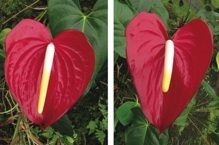 Read on for some red-hot-off-the-presses publications. “‘Kilauea’ and ‘Red Button,’ two ‘Ohelo, Vaccinium reticulatum, cultivars from Hawai‘i” details the uses of these two cultivars for ornamental and berry-bearing purposes—they look luscious enough to make you consider living high on a volcano just to grow them. The paper “‘‘Apapane’ and ‘‘I‘iwi’ Anthurium” describes the characteristics of these 2 new varieties of the popular heart-shaped red flower, developed from UH’s patented ‘Tropic Fire.’ They’re just as beautiful and glossy red as the native Hawaiian birds they’re named for, though luckily not as rare. “A Review of Mobile/Modular Slaughter and Processing Technology” discusses a relatively new way to solve the problem that small ranchers in remote areas often have: They’re too far from traditional slaughterhouses, and they may not have many animals to be slaughtered at one time. These and other issues are causing Hawai‘i ranchers to look into mobile slaughterhouses—often built into trailers or modular units—which offer more flexibility and are being used with success in several areas on the Mainland. More local, grass-fed beef? Anyone who’s been to the Taste of the Hawaiian Range would say you can’t go wrong. Read on for some red-hot-off-the-presses publications. “‘Kilauea’ and ‘Red Button,’ two ‘Ohelo, Vaccinium reticulatum, cultivars from Hawai‘i” details the uses of these two cultivars for ornamental and berry-bearing purposes—they look luscious enough to make you consider living high on a volcano just to grow them. The paper “‘‘Apapane’ and ‘‘I‘iwi’ Anthurium” describes the characteristics of these 2 new varieties of the popular heart-shaped red flower, developed from UH’s patented ‘Tropic Fire.’ They’re just as beautiful and glossy red as the native Hawaiian birds they’re named for, though luckily not as rare. “A Review of Mobile/Modular Slaughter and Processing Technology” discusses a relatively new way to solve the problem that small ranchers in remote areas often have: They’re too far from traditional slaughterhouses, and they may not have many animals to be slaughtered at one time. These and other issues are causing Hawai‘i ranchers to look into mobile slaughterhouses—often built into trailers or modular units—which offer more flexibility and are being used with success in several areas on the Mainland. More local, grass-fed beef? Anyone who’s been to the Taste of the Hawaiian Range would say you can’t go wrong.
|
Kia Ora!
7/11/2011 Source: Office of Communication Services, CTAHR 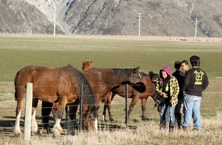 Recently East Hawai‘i County 4-H Agent Becky Settlage, along with nine 4-H members and 2 chaperones, traveled to New Zealand as part of the East Hawai‘i 4-H Exchange program. Though New Zealand does not have a 4-H program, Becky made contact with the manager for the New Zealand Young Farmers program, which had just started a teen ag group this past year. The timing was perfect for the two groups to collaborate on an exchange program. Despite some challenges along the way, including a few members who were unable to complete the program, the earthquakes and aftershocks in Christchurch, and the original flight reservations being accidentally cancelled, they had a great journey in the end. Now halfway through their journey, with travel to New Zealand behind them, they are beginning preparations for hosting the New Zealand Young Farmers in 2012. Ticket from Honolulu to New Zealand: $1069. Passport: $110. Wool socks: $15. Thermal underwear for cold winter days: $16.50. The 4-H experience of a lifetime: priceless. More photos can also be viewed online: free! Recently East Hawai‘i County 4-H Agent Becky Settlage, along with nine 4-H members and 2 chaperones, traveled to New Zealand as part of the East Hawai‘i 4-H Exchange program. Though New Zealand does not have a 4-H program, Becky made contact with the manager for the New Zealand Young Farmers program, which had just started a teen ag group this past year. The timing was perfect for the two groups to collaborate on an exchange program. Despite some challenges along the way, including a few members who were unable to complete the program, the earthquakes and aftershocks in Christchurch, and the original flight reservations being accidentally cancelled, they had a great journey in the end. Now halfway through their journey, with travel to New Zealand behind them, they are beginning preparations for hosting the New Zealand Young Farmers in 2012. Ticket from Honolulu to New Zealand: $1069. Passport: $110. Wool socks: $15. Thermal underwear for cold winter days: $16.50. The 4-H experience of a lifetime: priceless. More photos can also be viewed online: free!
|
Taking Sustainability on the Road
7/11/2011 Source: Office of Communication Services, CTAHR 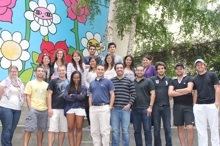 Samir Khanal (MBBE) recently taught a 3-credit course on “Sustainability: Green & Global” at the American Business School in Paris under the auspices of UH-Manoa’s Summer Program of Study Abroad Center. There were 24 students from the US, France, Lebanon, Turkey, Mexico, Morocco, and South Africa. Samir took this opportunity to develop a full course entitled “Sustainable Engineering,” which will be offered as an experimental course at UHM in Fall 2011. Samir Khanal (MBBE) recently taught a 3-credit course on “Sustainability: Green & Global” at the American Business School in Paris under the auspices of UH-Manoa’s Summer Program of Study Abroad Center. There were 24 students from the US, France, Lebanon, Turkey, Mexico, Morocco, and South Africa. Samir took this opportunity to develop a full course entitled “Sustainable Engineering,” which will be offered as an experimental course at UHM in Fall 2011.
|
Two Awards Are Better Than One
7/11/2011 Source: Office of Communication Services, CTAHR  Pavlos Anastasiadis (MBBE, PhD student) recently garnered 2 prestigious and competitive awards. First, he was named the best Young Scientist by the Board of the International Commission for Acoustics in Sydney, Australia, at the International Congress on Acoustics there, for his work on the elastic and mechanical properties of human and mouse atherosclerotic plaque as studied with ultra-high frequency scanning acoustic microscopy. Then he was awarded for the best paper at the meeting of the Acoustical Society of America in Seattle, along with the University of Boston and University of Rochester. The work presented there was on the real-time quantification of cell permeability of blood vessel cells (endothelial cells) for drug and gene delivery. His work was conducted in the laboratory of John S. Allen, who has joint appointments in the College of Engineering’s Department of Mechanical Engineering and MBBE. Here’s to collaboration between the two colleges! Pavlos Anastasiadis (MBBE, PhD student) recently garnered 2 prestigious and competitive awards. First, he was named the best Young Scientist by the Board of the International Commission for Acoustics in Sydney, Australia, at the International Congress on Acoustics there, for his work on the elastic and mechanical properties of human and mouse atherosclerotic plaque as studied with ultra-high frequency scanning acoustic microscopy. Then he was awarded for the best paper at the meeting of the Acoustical Society of America in Seattle, along with the University of Boston and University of Rochester. The work presented there was on the real-time quantification of cell permeability of blood vessel cells (endothelial cells) for drug and gene delivery. His work was conducted in the laboratory of John S. Allen, who has joint appointments in the College of Engineering’s Department of Mechanical Engineering and MBBE. Here’s to collaboration between the two colleges!
|
Rat Lungworm, Begone!
7/6/2011 Source: Office of Communication Services, CTAHR 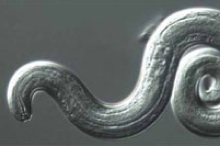 If you need funding to pursue the Herculean task of ridding the Islands and beyond of rat lungworm, groundnut ringspot virus, and the bagrada bug, you’ll want to check out funding from USDA for Critical Issues: Emerging & New Plant and Animal Pests, due Aug 1. Don’t want to get up close and personal with a groundnut’s ringspot? Consider NSF’s Scholarships in Science, Technology, Engineering, and Math, due July 13, or a couple of USDA Rural Development grants: Rural Cooperative Development Grant Program, due July 22, or Value Added Producer Grants, due Aug 29. Then there’s always the NSF Tribal Colleges and Universities Program—get back to them by July 21 or Aug 4—or USDA’s Higher Education Multi-Scholars Program—Aug 22. For more information on these and many more available grants, see the latest list of currently available funding opportunities, which is available in grant specialist Sharee Pepper’s “New Funding Opportunities” section under Research & Extension on the Employees’ page of the CTAHR Web site. If you need funding to pursue the Herculean task of ridding the Islands and beyond of rat lungworm, groundnut ringspot virus, and the bagrada bug, you’ll want to check out funding from USDA for Critical Issues: Emerging & New Plant and Animal Pests, due Aug 1. Don’t want to get up close and personal with a groundnut’s ringspot? Consider NSF’s Scholarships in Science, Technology, Engineering, and Math, due July 13, or a couple of USDA Rural Development grants: Rural Cooperative Development Grant Program, due July 22, or Value Added Producer Grants, due Aug 29. Then there’s always the NSF Tribal Colleges and Universities Program—get back to them by July 21 or Aug 4—or USDA’s Higher Education Multi-Scholars Program—Aug 22. For more information on these and many more available grants, see the latest list of currently available funding opportunities, which is available in grant specialist Sharee Pepper’s “New Funding Opportunities” section under Research & Extension on the Employees’ page of the CTAHR Web site.
|
An Eye on the Environment
7/5/2011 Source: Office of Communication Services, CTAHR 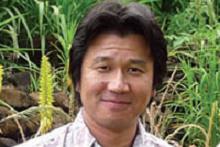 Tomoaki Miura (NREM, pictured) has been awarded a 3-year research grant from NASA with a total funding of over $600,000. He'll be working as a science team member for one of the two primary sensors of the next-generation United States environmental monitoring satellite system, the Visible Infrared Imaging Radiometer Suite (VIIRS) sensor. The VIIRS collects information on land and sea surface temperatures, clouds, polar ice, and other indicators that are used to get a better understanding of global climate change. This is a new and exciting research territory for CTAHR, and Tomoaki is just the person to lead the college into it. Tomoaki Miura (NREM, pictured) has been awarded a 3-year research grant from NASA with a total funding of over $600,000. He'll be working as a science team member for one of the two primary sensors of the next-generation United States environmental monitoring satellite system, the Visible Infrared Imaging Radiometer Suite (VIIRS) sensor. The VIIRS collects information on land and sea surface temperatures, clouds, polar ice, and other indicators that are used to get a better understanding of global climate change. This is a new and exciting research territory for CTAHR, and Tomoaki is just the person to lead the college into it.
|
Weed Eaters and Papaya Pests
7/5/2011 Source: Office of Communication Services, CTAHR Three project teams led by CTAHR faculty were awarded nearly $500,000 by the USDA Western Sustainable Agriculture Research and Extension (WSARE) program. Since 1988, SARE has funded more than 69 projects in Hawai‘i, with total grants exceeding $3 million for farmers, ranchers, Extension agents and educators, researchers, nonprofits, students, and communities. Check here for a complete list of Hawai‘i awardees.
- “Training Livestock to Eat Weeds in the Tropical Pacific and Evaluating the Effects on Meat Quality for Stronger Ranch Profits,” Principal Investigator: Matthew Stevenson (HNFAS); producer cooperator: Randall Cremer; $49,610.
- “Reducing Pacific Island Growers’ Reliance on Off-Island Fertilizer Sources through Improved Awareness and Efficient Use of Local Inputs,” Principal Investigator: Theodore Radovich (TPSS); cooperators: Nguyen Hue (TPSS), Jari Sugano (PEPS), Mark Hamamoto, Al Santoro, Tova Callender, Stanley Gurr, Fred Takebayashi, Alton Arakaki (TPSS), Mark Cummings, Hector Valenzuela (TPSS), Linda Cox (NREM), Leland Nishek, Kimo Franklin; $284,070.
- “Developing Sustainable Pest Control Practices Against Major Pests in Papaya in Hawaii,” Principal Investigator: Leyla Kaufman (PEPS); cooperators: Melvin Matsuda, Kenneth Kamiya, Ross Sibucao, Orlando Manuel, Mark Wright (PEPS), Koon-Hui Wang (PEPS), Jari Sugano (PEPS); $148,174
|
Governor's Garden
7/5/2011 Source: Office of Communication Services, CTAHR 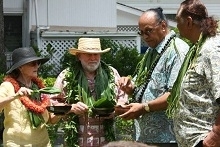 CTAHR partnered with individuals, schools, community associations, and the Hawaii Department of Agriculture to establish a “new day” vegetable and fruit garden at the governor’s residence on the Washington Place grounds. The garden will provide food for the first family and help to educate the community about fresh, nutritious, locally grown vegetables and fruits, as part of a wider initiative to achieve a higher level of food security and self-sufficiency in the state. At the dedication and blessing ceremony, Kahu Kamaki Kanehele called the event “a truly new day in Hawai‘i.” He explained that this was the first planting of a vegetable garden at Washington Place since 1917, when Queen Lili‘uokalani lived there. About 20 children from the Kainalu Elementary School, the Nanakuli Elementary School, and the University Laboratory School, along with Governor Abercrombie himself, planted vegetable seedlings and fruit trees, among them papaya seedlings provided by CTAHR’s Ted Radovich (TPSS) and his sustainable agriculture program. CTAHR partnered with individuals, schools, community associations, and the Hawaii Department of Agriculture to establish a “new day” vegetable and fruit garden at the governor’s residence on the Washington Place grounds. The garden will provide food for the first family and help to educate the community about fresh, nutritious, locally grown vegetables and fruits, as part of a wider initiative to achieve a higher level of food security and self-sufficiency in the state. At the dedication and blessing ceremony, Kahu Kamaki Kanehele called the event “a truly new day in Hawai‘i.” He explained that this was the first planting of a vegetable garden at Washington Place since 1917, when Queen Lili‘uokalani lived there. About 20 children from the Kainalu Elementary School, the Nanakuli Elementary School, and the University Laboratory School, along with Governor Abercrombie himself, planted vegetable seedlings and fruit trees, among them papaya seedlings provided by CTAHR’s Ted Radovich (TPSS) and his sustainable agriculture program.
|
Who Needs Dirt?
7/5/2011 Source: Office of Communication Services, CTAHR  A workshop on the “Challenges and Opportunities of Soil-Less Farming in Hawaii,” facilitated by Clyde Tamaru (MBBE, pictured), will be offered on Saturday, July 23, at Windward Community College from 9:00 to 12:30. Participants can find out about food safety certification of aquaponically and hydroponically grown foods from Jim Hollyer (PEPS) and discuss the economic realities of these farming methods with Harry Ako (MBBE). Then participants will hear from farmers already successful in this field, including Richard Ha of Hamakua Springs Country Farms and Paul Singleton of Waipoli Hydroponic Greens. Finally, they’ll have the opportunity to talk with those who market produce in the Islands, including Tisha Uyehara of Armstrong Produce and James Channels of Foodland, to find out what is expected of growers. A limited number of seats are available—to reserve a place, please contact Harry Ako at 956-2012 or hako@hawaii.edu, or Clyde Tamaru at 342-1063 or ctamaru@hawaii.edu. Check here for more detailed information, including a program of the workshop and directions to WCC. A workshop on the “Challenges and Opportunities of Soil-Less Farming in Hawaii,” facilitated by Clyde Tamaru (MBBE, pictured), will be offered on Saturday, July 23, at Windward Community College from 9:00 to 12:30. Participants can find out about food safety certification of aquaponically and hydroponically grown foods from Jim Hollyer (PEPS) and discuss the economic realities of these farming methods with Harry Ako (MBBE). Then participants will hear from farmers already successful in this field, including Richard Ha of Hamakua Springs Country Farms and Paul Singleton of Waipoli Hydroponic Greens. Finally, they’ll have the opportunity to talk with those who market produce in the Islands, including Tisha Uyehara of Armstrong Produce and James Channels of Foodland, to find out what is expected of growers. A limited number of seats are available—to reserve a place, please contact Harry Ako at 956-2012 or hako@hawaii.edu, or Clyde Tamaru at 342-1063 or ctamaru@hawaii.edu. Check here for more detailed information, including a program of the workshop and directions to WCC.
|
Win-Win
7/5/2011 Source: Office of Communication Services, CTAHR 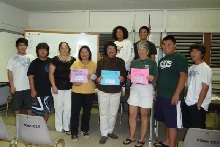 The members of the Kona 4-H Federation wanted to give back to their community, so they did. To the tune of thousands of dollars. The youth, with their adult partners, came together, brainstormed, and decided that in these tough economic times cold, hard cash was the way to go. They eventually raised more than $12,000 to benefit local and national charities, including the Ronald McDonald House, the Food Basket, the Japan-Hawaii Relief Fund, and the American Red Cross Hats Off Project. The charities were thrilled with the material support, but the 4-H’ers gained something more: hands-on experience in life skills such as communication, public speaking, decision making, empathy, working together, and taking responsibility. The members of the Kona 4-H Federation wanted to give back to their community, so they did. To the tune of thousands of dollars. The youth, with their adult partners, came together, brainstormed, and decided that in these tough economic times cold, hard cash was the way to go. They eventually raised more than $12,000 to benefit local and national charities, including the Ronald McDonald House, the Food Basket, the Japan-Hawaii Relief Fund, and the American Red Cross Hats Off Project. The charities were thrilled with the material support, but the 4-H’ers gained something more: hands-on experience in life skills such as communication, public speaking, decision making, empathy, working together, and taking responsibility.
|
Got Milk?
7/5/2011 Source: Office of Communication Services, CTAHR  Corilee Watters (HNFAS) and her research assistants Lee Rosner (left) and Shelley Wong (right) are working with neonatologists, including Sheree Kuo (2nd from left) and Lynn Iwamoto (2nd from right) at Kapi‘olani Medical Center for Women and Children to investigate optimal nutrition for premature infants during growth and development. Both Lee and Shelley are recipients of Undergraduate Research Opportunities Council funding to complete studies on nutrition, growth and development. Lee’s project relates to growth outcomes as relating to early nutrition intervention, and Shelley’s project is on the effects of increased maternal breast milk administration to premature infants. Corilee Watters (HNFAS) and her research assistants Lee Rosner (left) and Shelley Wong (right) are working with neonatologists, including Sheree Kuo (2nd from left) and Lynn Iwamoto (2nd from right) at Kapi‘olani Medical Center for Women and Children to investigate optimal nutrition for premature infants during growth and development. Both Lee and Shelley are recipients of Undergraduate Research Opportunities Council funding to complete studies on nutrition, growth and development. Lee’s project relates to growth outcomes as relating to early nutrition intervention, and Shelley’s project is on the effects of increased maternal breast milk administration to premature infants.
|
Teaching With Termites
7/5/2011 Source: Office of Communication Services, CTAHR 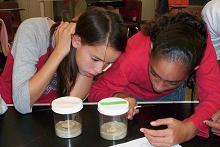 For the past 8 years, CTAHR has been partnering with Hawai‘i public school teachers on the “Termite Project - Educate to Eradicate” curriculum program to teach kids science using those mighty munchers, Formosan subterranean termites. The curriculum project, led by Interim Associate Dean Ken Grace and PEPS Extension Specialist Julian Yates and funded by USDA-ARS, started with 90 students in four O‘ahu classrooms in 2003. Since then, it's reached over 10,000 students in 370+ classrooms statewide. The program has garnered regional and even national attention. Last month, 1st grade teacher Cory Shindo of Kipapa Elementary and biology teacher Tanya Ashimine of Kaiser High School were each awarded the 2011 President’s Prize in Primary and Secondary Education by the Pacific Branch of the Entomological Society of America. Cory and Tanya have also been nominated for the society’s national awards, to be announced later this year. The program has also included a popular series of summer adult seminars on termite prevention, attended by over 2,000 Hawai‘i residents. The federal government has eliminated funding for the popular program this year, but Ken and Julian, along with project director Maria Aihara-Sasaki (PEPS) and entomology graduate student Makena Mason, have been focusing on making it a sustainable, teacher-driven program for the past several years. CTAHR plans to continue providing curriculum tools (and termites!) to partner schools for as long as possible to boost science literacy and help achieve the goal of termite-free Hawai‘i houses. For the past 8 years, CTAHR has been partnering with Hawai‘i public school teachers on the “Termite Project - Educate to Eradicate” curriculum program to teach kids science using those mighty munchers, Formosan subterranean termites. The curriculum project, led by Interim Associate Dean Ken Grace and PEPS Extension Specialist Julian Yates and funded by USDA-ARS, started with 90 students in four O‘ahu classrooms in 2003. Since then, it's reached over 10,000 students in 370+ classrooms statewide. The program has garnered regional and even national attention. Last month, 1st grade teacher Cory Shindo of Kipapa Elementary and biology teacher Tanya Ashimine of Kaiser High School were each awarded the 2011 President’s Prize in Primary and Secondary Education by the Pacific Branch of the Entomological Society of America. Cory and Tanya have also been nominated for the society’s national awards, to be announced later this year. The program has also included a popular series of summer adult seminars on termite prevention, attended by over 2,000 Hawai‘i residents. The federal government has eliminated funding for the popular program this year, but Ken and Julian, along with project director Maria Aihara-Sasaki (PEPS) and entomology graduate student Makena Mason, have been focusing on making it a sustainable, teacher-driven program for the past several years. CTAHR plans to continue providing curriculum tools (and termites!) to partner schools for as long as possible to boost science literacy and help achieve the goal of termite-free Hawai‘i houses.
|
June
Don’t Eat That Soda Can
6/21/2011 Source: Office of Communication Services, CTAHR  Jordan Oshiro, a senior in HNFAS, has been awarded a $3,000 summer research stipend by the UHM Undergraduate Research Opportunities Council. Jordan’s proposed study is entitled “Is U.S. infant and toddler aluminum intake excessive?” Working with Joannie Dobbs, Jordan will be re-evaluating the aluminum content of the American diet after the two found a significant decimal-place error in previously published food data. The proposal was “ranked among the best out of a total of 64 applications that were recommended for support” following a rigorous evaluation by a council of 10 faculty reviewers. This isn’t the first honor for Jordan: At the 2011 CTAHR-COE Student Research Symposium he presented on “Investigating nutrition beliefs of students at the University of Hawai‘i” and took home the award for the Best Oral Presentation by an Undergraduate Student in CTAHR. Jordan Oshiro, a senior in HNFAS, has been awarded a $3,000 summer research stipend by the UHM Undergraduate Research Opportunities Council. Jordan’s proposed study is entitled “Is U.S. infant and toddler aluminum intake excessive?” Working with Joannie Dobbs, Jordan will be re-evaluating the aluminum content of the American diet after the two found a significant decimal-place error in previously published food data. The proposal was “ranked among the best out of a total of 64 applications that were recommended for support” following a rigorous evaluation by a council of 10 faculty reviewers. This isn’t the first honor for Jordan: At the 2011 CTAHR-COE Student Research Symposium he presented on “Investigating nutrition beliefs of students at the University of Hawai‘i” and took home the award for the Best Oral Presentation by an Undergraduate Student in CTAHR.
|
(S)cat!
6/21/2011 Source: Office of Communication Services, CTAHR 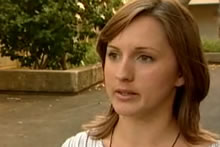 Alisa Davis (MS student, NREM, pictured) coordinates a project, managed by the Office of Facilities and Grounds, which aims to improve the feral cat management program on the UHM campus. On May 23, KITV News highlighted the project, which focuses on population surveys, health assessments, outreach to cat caregivers and feeders on campus, and a study on toxoplasmosis in cat colonies (toxoplasmosis, carried in the waste of infected cats, can cause fetal death in humans). If you have questions about the project, you can contact Alisa at alisaad@hawaii.edu. Alisa Davis (MS student, NREM, pictured) coordinates a project, managed by the Office of Facilities and Grounds, which aims to improve the feral cat management program on the UHM campus. On May 23, KITV News highlighted the project, which focuses on population surveys, health assessments, outreach to cat caregivers and feeders on campus, and a study on toxoplasmosis in cat colonies (toxoplasmosis, carried in the waste of infected cats, can cause fetal death in humans). If you have questions about the project, you can contact Alisa at alisaad@hawaii.edu.
|
Keep an Eye on That Bird
6/21/2011 Source: Office of Communication Services, CTAHR 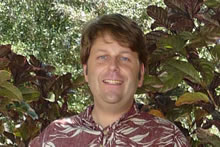 Chris Lepczyk (NREM, pictured) was interviewed for an article in the May issue of Nature Climate Change on the role of amateur data collection—known as “citizen science”—in climate-change studies. Phenology, or the study of “the timing of key events in the life of a plant or animal,” is of especial interest to amateur naturalists, and increasingly scientists are incorporating citizen data into their research. There’s still some question about its value, though, and here’s where Chris weighed in. Chris, who trains volunteers to monitor birds, is in favor of the partnership between academia and the surrounding community: “without citizen science data,” he says, “we would not have detected many of the phenological changes seen in species distributions and timing of migrations, in relation to climate change.” He also points out that most times, in terms of the data collected by scientists and volunteers, “there isn’t a difference.” So if you’ve been making a note of when your mangoes ripen every year, know that you’re part of an “army of observers”—and keep up the good work! Chris Lepczyk (NREM, pictured) was interviewed for an article in the May issue of Nature Climate Change on the role of amateur data collection—known as “citizen science”—in climate-change studies. Phenology, or the study of “the timing of key events in the life of a plant or animal,” is of especial interest to amateur naturalists, and increasingly scientists are incorporating citizen data into their research. There’s still some question about its value, though, and here’s where Chris weighed in. Chris, who trains volunteers to monitor birds, is in favor of the partnership between academia and the surrounding community: “without citizen science data,” he says, “we would not have detected many of the phenological changes seen in species distributions and timing of migrations, in relation to climate change.” He also points out that most times, in terms of the data collected by scientists and volunteers, “there isn’t a difference.” So if you’ve been making a note of when your mangoes ripen every year, know that you’re part of an “army of observers”—and keep up the good work!
|
Green Tourism
6/21/2011 Source: Office of Communication Services, CTAHR 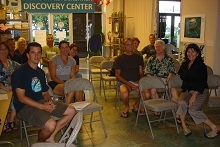 Linda Cox (NREM) gave a presentation on June 14 at a meeting (pictured) jointly sponsored by the Hawaii Ecotourism Association (HEA) and the Pacific Whale Foundation. As part of her Community Economic Development Program, Linda has served as an advisor to HEA for many years and is currently involved in their efforts to develop a statewide certification program for eco-tour companies, which is being funded by the Hawaii Tourism Authority. Linda will be conducting public meetings across the state the last two weeks of June, as well as co-authoring a chapter on sustainable tourism for a book to be published early in 2012 by the Sustainable Living Institute on Maui and developing a video on sustainable tourism certification. Linda Cox (NREM) gave a presentation on June 14 at a meeting (pictured) jointly sponsored by the Hawaii Ecotourism Association (HEA) and the Pacific Whale Foundation. As part of her Community Economic Development Program, Linda has served as an advisor to HEA for many years and is currently involved in their efforts to develop a statewide certification program for eco-tour companies, which is being funded by the Hawaii Tourism Authority. Linda will be conducting public meetings across the state the last two weeks of June, as well as co-authoring a chapter on sustainable tourism for a book to be published early in 2012 by the Sustainable Living Institute on Maui and developing a video on sustainable tourism certification.
|
Anaerobic Digestion
6/13/2011 Source: Office of Communication Services, CTAHR 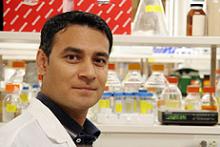 OmniGreen Renewables (OGR), in collaboration with Samir Khanal (MBBE, pictured), has received a half-million-dollar grant from USDA NIFA Small Business Innovation Research Phase II for bioenergy production. Samir’s Bioenergy Lab will be the lead university partner in the funded project and will conduct an anaerobic digestion study using Jatropha seedcake—the byproduct after Jatropha seeds are pressed for oil to make biofuel—and local high-yield biomass as feedstocks for maximal biogas production. This is a decentralized, community-based project with an emphasis on renewable energy, agriculture, and food production. It’s hoped the project will provide direct benefits to rural communities on each of the Hawaiian Islands by creating jobs and strengthening the local economy. OmniGreen Renewables (OGR), in collaboration with Samir Khanal (MBBE, pictured), has received a half-million-dollar grant from USDA NIFA Small Business Innovation Research Phase II for bioenergy production. Samir’s Bioenergy Lab will be the lead university partner in the funded project and will conduct an anaerobic digestion study using Jatropha seedcake—the byproduct after Jatropha seeds are pressed for oil to make biofuel—and local high-yield biomass as feedstocks for maximal biogas production. This is a decentralized, community-based project with an emphasis on renewable energy, agriculture, and food production. It’s hoped the project will provide direct benefits to rural communities on each of the Hawaiian Islands by creating jobs and strengthening the local economy.
|
Connecting With Kupuna
6/13/2011 Source: Office of Communication Services, CTAHR 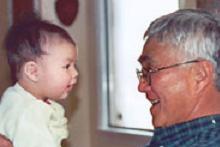 COF reports that Hawai‘i’s percentages of elderly and of intergenerational households are among the highest in the nation. Nonetheless, it can be difficult to bridge the generation gap. This is where the Ka ‘Aha project, offered by FCS, comes in. Multigenerational “teams” of family, friends, and neighbors register for an eight-week session, during which they read information posted in “byte-sized” chunks on the Ka ‘Aha Web site and participate in suggested activities to strengthen bonds of connection and understanding between youth and kupuna. Possibilities include teaching each other the games kids play now and those they played decades ago, connecting through technology (Skypin’ with Tutu!), looking over a family album together, and preparing and eating foods together. Heather Greenwood (Extension, Maui) is the contact for the project, which aims to create “a strong, healthy community” by showing people who may not believe they have much in common how to work together and appreciate each other. COF reports that Hawai‘i’s percentages of elderly and of intergenerational households are among the highest in the nation. Nonetheless, it can be difficult to bridge the generation gap. This is where the Ka ‘Aha project, offered by FCS, comes in. Multigenerational “teams” of family, friends, and neighbors register for an eight-week session, during which they read information posted in “byte-sized” chunks on the Ka ‘Aha Web site and participate in suggested activities to strengthen bonds of connection and understanding between youth and kupuna. Possibilities include teaching each other the games kids play now and those they played decades ago, connecting through technology (Skypin’ with Tutu!), looking over a family album together, and preparing and eating foods together. Heather Greenwood (Extension, Maui) is the contact for the project, which aims to create “a strong, healthy community” by showing people who may not believe they have much in common how to work together and appreciate each other.
|
Trip Tips—or, "In the Event of a Disaster…"
6/13/2011 Source: Office of Communication Services, CTAHR Here’s the latest installment of travel tips, culled from UH’s eTravel page. The items seem uniquely concerned with travel disasters, but don’t let that dampen your enthusiasm for the open road—or keep you from filing your paperwork correctly!
Q: When is a Travel Request required?
A: Any time an employee is traveling for University business, an approved Travel Request is required to cover the traveler while he/she is away. In addition, in the event of a disaster, the University will be able to identify employees traveling in the area of the disaster.
Q: When should I submit my Travel Request?
A: For travel without a travel advance, a Request should be approved prior to departure. For travel with a travel advance, a Request must be approved and submitted to Disbursing at least 10 days prior to departure.
Q: What constitutes no-cost travel?
A: This is when an employee is traveling for official UH business, but UH is not paying for the trip as it’s being funded by another organization or institution.
Q: If there’s no cost to the University, does a travel document still have to be submitted?
A: Yes. If the employee is traveling for official UH business, even if at no cost to the University, a Travel Request must be submitted to cover the traveler while he/she is away. In addition, in the event of a disaster, the University will be able to identify employees traveling in the area of the disaster.
|
Hatching Success
6/13/2011 Source: Office of Communication Services, CTAHR 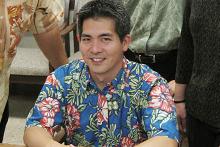 The Agribusiness Incubator Program, headed by CTAHR’s Steven Chiang (pictured), was recently featured in Entrepreneur magazine in an article focusing on “market-specific business accelerators...helping entrepreneurs around the country get their businesses off the ground”—though in this case, of course, the ground is where the businesses AIP helps are based. Entrepreneur calls the program “boot camp” for “small farm and agriculture businesses.” Apparently, they mean this as a compliment, pointing out that AIP aided 10 new businesses to start up last year, helped to get 12 new products out, and increased the revenues of the businesses they advised by over a third—and the profits of those businesses by over 150 percent! The Agribusiness Incubator Program, headed by CTAHR’s Steven Chiang (pictured), was recently featured in Entrepreneur magazine in an article focusing on “market-specific business accelerators...helping entrepreneurs around the country get their businesses off the ground”—though in this case, of course, the ground is where the businesses AIP helps are based. Entrepreneur calls the program “boot camp” for “small farm and agriculture businesses.” Apparently, they mean this as a compliment, pointing out that AIP aided 10 new businesses to start up last year, helped to get 12 new products out, and increased the revenues of the businesses they advised by over a third—and the profits of those businesses by over 150 percent!
|
Come Together, Right Now
6/13/2011 Source: Office of Communication Services, CTAHR 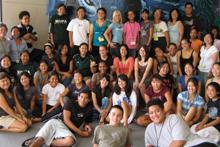 Now’s the time for 4-H’ers and their advisors to start registering for the 2011 4-H Ahaolelo (the name indicates a gathering for a meeting). This year’s meeting will take place on the UH-Manoa campus, from July 19 through July 21, but participants need to register by June 30 (scroll down linked page to download pdf). Since 1947 the meeting has brought together 4-H’ers from throughout Hawai‘i, as well as participants from Canada, Guam, California, Micronesia, and Japan. The wide range of topics to be covered during this meeting will include Animal Science, Bullying, Collegiate 4-H, Cultural Diversity, Genetics, Oceanography, Social Media, and Veterinary Science. “The 4-H Ahaolelo is rich in tradition,” says its Web site; “the week of ‘coming together’ has played an important part in the development of 4-H in Hawaii [and] provides opportunities to make friends and exchange ideas.” Now’s the time for 4-H’ers and their advisors to start registering for the 2011 4-H Ahaolelo (the name indicates a gathering for a meeting). This year’s meeting will take place on the UH-Manoa campus, from July 19 through July 21, but participants need to register by June 30 (scroll down linked page to download pdf). Since 1947 the meeting has brought together 4-H’ers from throughout Hawai‘i, as well as participants from Canada, Guam, California, Micronesia, and Japan. The wide range of topics to be covered during this meeting will include Animal Science, Bullying, Collegiate 4-H, Cultural Diversity, Genetics, Oceanography, Social Media, and Veterinary Science. “The 4-H Ahaolelo is rich in tradition,” says its Web site; “the week of ‘coming together’ has played an important part in the development of 4-H in Hawaii [and] provides opportunities to make friends and exchange ideas.”
|
If You Intend to Write a Letter of Intent...
6/13/2011 Source: Office of Communication Services, CTAHR for the Industry/University Cooperative Research Centers Program, make sure you get it written by June 26. It could mean a large NSF grant, and you know we all could use one of those. Next due is the USDA Farm Business Management & Benchmarking Program, on June 27, followed by the USDA Organic Transitions Program on June 30 and the USDA AFRI Food Safety Program on July 5. Finally, if you're looking to get up close and personal with some grass, the USDA Rangeland Program has a grant that's due July 6. The latest list of currently available funding opportunities is also available in grant specialist Sharee Pepper’s “New Funding Opportunities” section under Research & Extension on the Employees’ page of the CTAHR Web site.
|
If Can, Can
6/6/2011 Source: Office of Communication Services, CTAHR 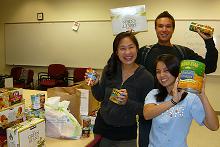 The HNFAS, MBBE, and O‘ahu County CES offices combined their collective canned goods consciousness for the Ag Sci Building “Fruit and Veggie” Can Drive as part of UH’s Food Drive for the Hawaii Foodbank in April and May. The drive culminated on May 3rd with a collection day in the 219 Conference Room. Thanks are due to HNFAS Council members Casey Shimokawa, Dustin Lee, and Shelley Wong (pictured) for providing their “can-do” attitude in helping on collection day. In all, 220 pounds of food (6 boxes) were collected, including 175 pounds of fruits and veggies. There were also $120 in merchandise purchases and $760 in monetary donations for the Foodbank. CTAHR as a whole collected 11 boxes of food, $600 in merchandise sales, and over $2,800 in cash/check donations. A big mahalo to all those who contributed time, effort, and donations to the food drive! The HNFAS, MBBE, and O‘ahu County CES offices combined their collective canned goods consciousness for the Ag Sci Building “Fruit and Veggie” Can Drive as part of UH’s Food Drive for the Hawaii Foodbank in April and May. The drive culminated on May 3rd with a collection day in the 219 Conference Room. Thanks are due to HNFAS Council members Casey Shimokawa, Dustin Lee, and Shelley Wong (pictured) for providing their “can-do” attitude in helping on collection day. In all, 220 pounds of food (6 boxes) were collected, including 175 pounds of fruits and veggies. There were also $120 in merchandise purchases and $760 in monetary donations for the Foodbank. CTAHR as a whole collected 11 boxes of food, $600 in merchandise sales, and over $2,800 in cash/check donations. A big mahalo to all those who contributed time, effort, and donations to the food drive!
|
No, They’re Not Feeding Rum to the Fish...
6/6/2011 Source: Office of Communication Services, CTAHR One of the high school students Samir Khanal (MBBE) has mentored in his lab for the past three years, Sarah Tamashiro, was recently featured in a Star-Advertiser article about her achievements. She and another of Samir’s protegees, Lindsay Fujimoto, have been working on cultivating potential food products from the by-products of rum manufacturing. They helped to grow a nutritious fungus that’s being considered as a possible protein supplement for humans and a high-grade food for farmed fish.
|
Way Beyond a Grass Fire
6/6/2011 Source: Office of Communication Services, CTAHR 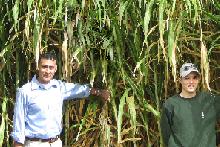 Samir Khanal (MBBE, pictured with MS student Devin Takara) has received a 2-year grant of $199,590 from Sun Grant for biofuel research. The research aims at developing a mobile, decentralized, closed-loop system for biofuel and biobased product generation with minimal environmental impacts, using banagrass, a locally available high-yield tropical grass. Make that very high-yield—from the looks of that grass, it's a good thing someone is doing something with it before it takes over! Samir Khanal (MBBE, pictured with MS student Devin Takara) has received a 2-year grant of $199,590 from Sun Grant for biofuel research. The research aims at developing a mobile, decentralized, closed-loop system for biofuel and biobased product generation with minimal environmental impacts, using banagrass, a locally available high-yield tropical grass. Make that very high-yield—from the looks of that grass, it's a good thing someone is doing something with it before it takes over!
|
Capital for Capital Improvements
6/6/2011 Source: Office of Communication Services, CTAHR 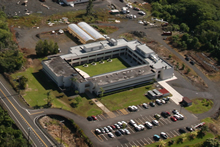 Governor Neil Abercrombie has released $2,000,000 in general obligation bond funds for construction to renovate UH-Manoa’s Komohana Research and Extension Center in Hilo as a part of his New Day Work Projects, which aim to create jobs and stimulate the economy. These projects are aimed at improving and/or constructing learning facilities and campus environments within the Department of Education and the University of Hawai‘i. CTAHR’s Komohana Research and Extension Center is an integral part of its community, offering services as diverse as a Master Gardener helpline, water-testing kits, and seminars on getting into agritourism. Governor Neil Abercrombie has released $2,000,000 in general obligation bond funds for construction to renovate UH-Manoa’s Komohana Research and Extension Center in Hilo as a part of his New Day Work Projects, which aim to create jobs and stimulate the economy. These projects are aimed at improving and/or constructing learning facilities and campus environments within the Department of Education and the University of Hawai‘i. CTAHR’s Komohana Research and Extension Center is an integral part of its community, offering services as diverse as a Master Gardener helpline, water-testing kits, and seminars on getting into agritourism.
|
Native Health
6/6/2011 Source: Office of Communication Services, CTAHR “The Program in Native Hawaiian and Indigenous Health,” a proposal on which CTAHR collaborated with JABSOM, Social Work, Nursing, Law, and the School of Hawaiian Knowledge, was selected out of 8 proposals for the Chancellor’s Strategic Hiring Initiative in Native Hawaiian Programs. Chancellor Hinshaw says, “The proposals presented quality ideas and reflected tremendous depth of commitment to these issues”; about this proposal, she adds, “This cluster’s strengths are in addressing an urgent need of the Hawaiian community, providing a bold vision with measurable outcomes and launching a new Master of Public Health in Indigenous Health.” Three joint faculty positions were approved for this cluster: one 0.75 FTE in Public Health and 0.25 FTE in CTAHR, one 0.75 FTE in Public Health and 0.25 FTE in Social Work, and one 0.75 FTE in JABSOM-Native Hawaiian Health and 0.25 FTE in Hawai‘inuiakea School of Hawaiian Knowledge. The coordinators and the Chancellor’s office will work during the summer with the proposers to define job descriptions and the search process, including strategies for recruiting underrepresented candidates. The recruitments will begin when faculty return in the fall, and hiring should be underway in 2012. Since there were so many strong proposals, there will also be a call for new cluster proposals on the same themes in spring 2012.
|
Extending a Hand in Health and Nutrition
6/6/2011 Source: Office of Communication Services, CTAHR  The Hawai‘i Extension Nutrition and Health Program Area began 4 years ago, with Extension faculty and staff from every county coming together to identify and discuss key nutrition and health issues facing people in Hawai‘i, gaps in Extension programming, and ideas for professional development. This led to the formation of 3 work groups on resource management, healthy aging, and food skills: Each group identified relevant current projects and resources within CTAHR and UH, as well as gaps and potential collaborators. Working together across counties and departments, the work groups have compiled lists of resources and relevant materials, developed lessons on food skills for teens and nutrition for seniors, and initiated projects with an intergenerational approach. These Extension educators also organized and held two 2-day professional development workshops on intergenerational programs and healthy aging and on building Extension’s public value. Being an organized program area has encouraged and fostered better collaboration among Extension educators, like program leader Julia Zee (pictured) who continue to explore new projects, professional development, and ways to reach diverse audiences across the state. The Hawai‘i Extension Nutrition and Health Program Area began 4 years ago, with Extension faculty and staff from every county coming together to identify and discuss key nutrition and health issues facing people in Hawai‘i, gaps in Extension programming, and ideas for professional development. This led to the formation of 3 work groups on resource management, healthy aging, and food skills: Each group identified relevant current projects and resources within CTAHR and UH, as well as gaps and potential collaborators. Working together across counties and departments, the work groups have compiled lists of resources and relevant materials, developed lessons on food skills for teens and nutrition for seniors, and initiated projects with an intergenerational approach. These Extension educators also organized and held two 2-day professional development workshops on intergenerational programs and healthy aging and on building Extension’s public value. Being an organized program area has encouraged and fostered better collaboration among Extension educators, like program leader Julia Zee (pictured) who continue to explore new projects, professional development, and ways to reach diverse audiences across the state.
|
May
Hot Topics
5/30/2011 Source: Office of Communication Services, CTAHR  Looking for some light summer reading? Check out this star on the Wiley-Blackwell bestseller list by Samir Khanal (MBBE): Anaerobic Biotechnology for Bioenergy Production: Principles and Applications. It’s a searing, cogent look at the problem of environmental pollution and the ways anaerobes can help. Samir is also the lead editor and author of Biofuel and Bioenergy from Biowastes and Biomass, a timely look at the important issue of fuel sustainability. Take it to the beach this weekend! Looking for some light summer reading? Check out this star on the Wiley-Blackwell bestseller list by Samir Khanal (MBBE): Anaerobic Biotechnology for Bioenergy Production: Principles and Applications. It’s a searing, cogent look at the problem of environmental pollution and the ways anaerobes can help. Samir is also the lead editor and author of Biofuel and Bioenergy from Biowastes and Biomass, a timely look at the important issue of fuel sustainability. Take it to the beach this weekend!
|
New Face on Moloka‘i
5/30/2011 Source: Office of Communication Services, CTAHR We’re pleased to announce that on June 15, Jennifer Hawkins will join CTAHR as an Extension agent in the DHHL-CTAHR program on Moloka‘i. Jennifer brings a wealth of experience from her position as a County Extension Agent-Agriculture in Faulkner County, Arkansas. Her experience and background include animal production and 4-H youth development, and she also organized and coordinated the Master Gardener Program there for 10 years. Her diverse agricultural expertise and experience will serve well the needs of the DHHL homestead clientele, and she will be a great asset to the Extension office and community in Moloka‘i. Her husband, Eric, and daughter, Hope, will be with her for this new adventure. We are confident that Jennifer’s skills, attitude, and character will add to the overall excellence of the college. Be sure to welcome Jennifer at the earliest opportunity!
|
Get Responsible
5/30/2011 Source: Office of Communication Services, CTAHR An interactive session on the Responsible
Conduct of Research will be held on June 16 in St. John 011 from 8:00 a.m. to
12 noon. Participants should pre-register by June 10—just email uhrcr@hawaii.edu to register. You’ll then receive background materials to
read prior to the session. You’ll also need to complete the CITI online course prior to
attendance.
|
Does Your Methyl Bromide Need a Transition?
5/30/2011 Source: Office of Communication Services, CTAHR 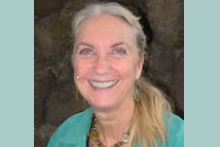 The latest list of currently available funding opportunities is now available in grant specialist Sharee Pepper’s “New Funding Opportunities” newsletter, which is posted by the CTAHR Research Office. There are 2 USDA Integrated Research, Education, and Extension grants, one on methyl bromide transition and one for the National Integrated Food Safety Initiative, which are due June 22 and June 27. There’s also a USDA Rural Health and Safety Education grant, due July 1, and a USDA National Integrated Water Quality Program grant, due July 15.The latest newsletter can always be downloaded from the New Funding Opportunities section under Research & Extension on the Employees’ page of the CTAHR Web site. The latest list of currently available funding opportunities is now available in grant specialist Sharee Pepper’s “New Funding Opportunities” newsletter, which is posted by the CTAHR Research Office. There are 2 USDA Integrated Research, Education, and Extension grants, one on methyl bromide transition and one for the National Integrated Food Safety Initiative, which are due June 22 and June 27. There’s also a USDA Rural Health and Safety Education grant, due July 1, and a USDA National Integrated Water Quality Program grant, due July 15.The latest newsletter can always be downloaded from the New Funding Opportunities section under Research & Extension on the Employees’ page of the CTAHR Web site.
|
The Wild Life of a Grad Student
5/30/2011 Source: Office of Communication Services, CTAHR 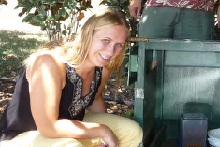 Cheryl Lohr (PhD student, NREM) is one of only two graduate students from across the US to have been awarded a position in the
Wildlife Society's Leadership Institute class of 2011. Every year the Leadership Institute provides training to 10 young wildlife professionals from across the country who have the potential to fill leadership positions in the workplace and society. Because 70% of leaders in the wildlife profession are projected to retire in the next decade, the Wildlife Society has designed this Institute to groom future leaders to face the many and multifarious conservation and management issues that lie ahead. Cheryl will participate in distance-learning exercises, including developing summary documents regarding professional leadership, plus intensive mentoring activities and leadership workshops at the
2011 TWS Annual Conference in Waikoloa on the Big Island in November. Congratulations, Cheryl! Cheryl Lohr (PhD student, NREM) is one of only two graduate students from across the US to have been awarded a position in the
Wildlife Society's Leadership Institute class of 2011. Every year the Leadership Institute provides training to 10 young wildlife professionals from across the country who have the potential to fill leadership positions in the workplace and society. Because 70% of leaders in the wildlife profession are projected to retire in the next decade, the Wildlife Society has designed this Institute to groom future leaders to face the many and multifarious conservation and management issues that lie ahead. Cheryl will participate in distance-learning exercises, including developing summary documents regarding professional leadership, plus intensive mentoring activities and leadership workshops at the
2011 TWS Annual Conference in Waikoloa on the Big Island in November. Congratulations, Cheryl!
|
Toku Tanaka
5/23/2011 Source: Office of Communication Services, CTAHR We are saddened to report that Emeritus Poultry Extension Specialist Tokushi “Toku” Tanaka passed away on Sunday, May 15, at age 89. Toku earned his BS (1948) and MS (1953) from UH. Long after his retirement, he remained active in his department, working with the poultry industry and Extension staff. As an undergraduate he played baseball for the university; in later years, he was an avid golfer, playing with the CTAHR golf club. One of Toku’s greatest legacies was the 1972 publication of an immensely popular brochure, “Small Scale Poultry Production,” which stayed in great demand until supplies were exhausted. He is survived by a niece and nephew. Our best wishes go out to his family.
|
Alumnus Honored
5/23/2011 Source: Office of Communication Services, CTAHR  Charles R. Figley, who earned his BS in Human Development (now Family and Consumer Sciences) in 1970 from UH, has been named the 2010 Fellow of the National Council on Family Relations. Charles, a leader in the field of trauma psychology, was also the first recipient of the American Psychological Lifetime Achievement Award in Trauma Psychology in Aug. 2009. He is Paul Henry Kurzweg Distinguished Chair and Professor and Director of the Traumatology Institute and Psychosocial Stress Research Program at Tulane University. Charles has published more than 200 scholarly works, including 20 books and 114 refereed journal articles that report on 35 research projects focusing on the stresses and resiliency of individuals, families and communities. He was also the founding editor of the International Journal of Family Psychotherapy and the Journal of Trauma Stress. Charles R. Figley, who earned his BS in Human Development (now Family and Consumer Sciences) in 1970 from UH, has been named the 2010 Fellow of the National Council on Family Relations. Charles, a leader in the field of trauma psychology, was also the first recipient of the American Psychological Lifetime Achievement Award in Trauma Psychology in Aug. 2009. He is Paul Henry Kurzweg Distinguished Chair and Professor and Director of the Traumatology Institute and Psychosocial Stress Research Program at Tulane University. Charles has published more than 200 scholarly works, including 20 books and 114 refereed journal articles that report on 35 research projects focusing on the stresses and resiliency of individuals, families and communities. He was also the founding editor of the International Journal of Family Psychotherapy and the Journal of Trauma Stress.
|
Going Viral
5/23/2011 Source: Office of Communication Services, CTAHR  Joannie Dobbs (HNFAS) and Alan Titchenal (HNFAS, pictured) recently pointed out a problem with the Web’s ease of repetition and replication in their column “Health Options” in the Star-Advertiser. They explain that once an error shows up on the Web, it’s almost impossible to rectify it: Even if the original source is corrected, the wrong information has probably already been copied, pasted, Facebooked, tweeted about, or outright plagiarized by too many others to ever find and qualify. As a case in point, they discuss an error in the dosage instructions for iron supplements for infants: A press release from the American Academy of Pediatrics had erroneously printed a dosage recommendation three times the acceptable upper limit for infants—a dosage that would in fact be toxic. Alan and Joannie point out that though the original source had only had this information up for 12 days before correcting it, numerous Web sites were already posting it, and 6 months later, when they checked again, more than 25 were still recommending the potentially fatal dose. Just FYI, it’s supposed to be 11 mg of iron per day, not 11 mg per kilogram of body weight—spread the word! Joannie Dobbs (HNFAS) and Alan Titchenal (HNFAS, pictured) recently pointed out a problem with the Web’s ease of repetition and replication in their column “Health Options” in the Star-Advertiser. They explain that once an error shows up on the Web, it’s almost impossible to rectify it: Even if the original source is corrected, the wrong information has probably already been copied, pasted, Facebooked, tweeted about, or outright plagiarized by too many others to ever find and qualify. As a case in point, they discuss an error in the dosage instructions for iron supplements for infants: A press release from the American Academy of Pediatrics had erroneously printed a dosage recommendation three times the acceptable upper limit for infants—a dosage that would in fact be toxic. Alan and Joannie point out that though the original source had only had this information up for 12 days before correcting it, numerous Web sites were already posting it, and 6 months later, when they checked again, more than 25 were still recommending the potentially fatal dose. Just FYI, it’s supposed to be 11 mg of iron per day, not 11 mg per kilogram of body weight—spread the word!
|
Honor and Laughter
5/23/2011 Source: Office of Communication Services, CTAHR  CTAHR’s alumni and community partners were well represented at the recent 23rd Annual Awards Banquet. Representative Clift Tsuji and Senator Gilbert Kahele presented legislative commendations to honorees Arnold Hara, PingSun Leung, and Harold Tanouye, and CTAHR’s 2002 Outstanding Alumnus Derek Kurisu (pictured, with Dean Sylvia Yuen) did—as expected—a fantastic job as Master of Ceremonies. Attendees were delighted by gift bags containing coffee from Kauai Coffee, candies from Hawaiian Host, tomatoes from Hamakua Farms, and pineapples from Maui Gold. Generous sponsors of the distinguished tables included Meadow Gold, Alluvion, Monsanto Hawaii, Aloun Farms, Hawaiian Host, Taro Brand, Alexander & Baldwin, Inc., Green Point Nurseries, Pioneer Hi-Bred, and Kona Sunset Farm...and it was proven conclusively in a riotous game that all Smart People are able to recognize the logos of these companies on sight. In honor of their support of the college, Big Island Candies presented the sponsors with beautiful boxes of their delicious cookies. The Directors of the Department of Agriculture, Russell Kokubun; Department of Business, Economic Development, and Tourism, Richard Lim; and Department of Health, Loretta Fuddy, joined in the festivities, as did President M.R.C. Greenwood. Jennifer Sabas read a message from Senator Inouye, who was sorry not to have been able to attend—we suppose it’s probably better that he didn’t know beforehand just how much fun he'd be missing! CTAHR’s alumni and community partners were well represented at the recent 23rd Annual Awards Banquet. Representative Clift Tsuji and Senator Gilbert Kahele presented legislative commendations to honorees Arnold Hara, PingSun Leung, and Harold Tanouye, and CTAHR’s 2002 Outstanding Alumnus Derek Kurisu (pictured, with Dean Sylvia Yuen) did—as expected—a fantastic job as Master of Ceremonies. Attendees were delighted by gift bags containing coffee from Kauai Coffee, candies from Hawaiian Host, tomatoes from Hamakua Farms, and pineapples from Maui Gold. Generous sponsors of the distinguished tables included Meadow Gold, Alluvion, Monsanto Hawaii, Aloun Farms, Hawaiian Host, Taro Brand, Alexander & Baldwin, Inc., Green Point Nurseries, Pioneer Hi-Bred, and Kona Sunset Farm...and it was proven conclusively in a riotous game that all Smart People are able to recognize the logos of these companies on sight. In honor of their support of the college, Big Island Candies presented the sponsors with beautiful boxes of their delicious cookies. The Directors of the Department of Agriculture, Russell Kokubun; Department of Business, Economic Development, and Tourism, Richard Lim; and Department of Health, Loretta Fuddy, joined in the festivities, as did President M.R.C. Greenwood. Jennifer Sabas read a message from Senator Inouye, who was sorry not to have been able to attend—we suppose it’s probably better that he didn’t know beforehand just how much fun he'd be missing!
|
Milk Money
5/23/2011 Source: Office of Communication Services, CTAHR 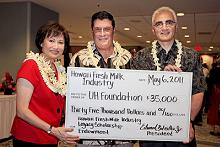 The Hawai‘i Fresh Milk Industry (HFMI) has donated $35,000 for a Legacy Scholarship Endowment to support students with an interest in sustainable dairy or other livestock production who are pursuing studies in the Animal Sciences program in the Department of Human Nutrition, Food and Animal Sciences. The scholarship endowment was made possible by the joint efforts of the Hawai‘i dairy producers on O‘ahu and the Big Island, in recognition of the support given to the industry by the local community. It also builds on the dairy industry’s commitment to nurturing the community: “The dairy industry in Hawai‘i has a longstanding history of supporting the community it serves.... This endowment continues our educational efforts, investing in the next generation of leaders in our community,” said Edward Boteilho, Jr., president of HFMI. He also points out that “This scholarship will be a lasting memorial to all dairymen and Dr. Chin Lee,” a specialist in dairy science at CTAHR. Interim Dean Sylvia Yuen says, “This generous gift is an investment in the future—a legacy that will help grow and diversify Hawai‘i’s economy. Many bright and deserving students will be the beneficiaries”—and so will all those hoping for more local dairies in the Islands. The Hawai‘i Fresh Milk Industry (HFMI) has donated $35,000 for a Legacy Scholarship Endowment to support students with an interest in sustainable dairy or other livestock production who are pursuing studies in the Animal Sciences program in the Department of Human Nutrition, Food and Animal Sciences. The scholarship endowment was made possible by the joint efforts of the Hawai‘i dairy producers on O‘ahu and the Big Island, in recognition of the support given to the industry by the local community. It also builds on the dairy industry’s commitment to nurturing the community: “The dairy industry in Hawai‘i has a longstanding history of supporting the community it serves.... This endowment continues our educational efforts, investing in the next generation of leaders in our community,” said Edward Boteilho, Jr., president of HFMI. He also points out that “This scholarship will be a lasting memorial to all dairymen and Dr. Chin Lee,” a specialist in dairy science at CTAHR. Interim Dean Sylvia Yuen says, “This generous gift is an investment in the future—a legacy that will help grow and diversify Hawai‘i’s economy. Many bright and deserving students will be the beneficiaries”—and so will all those hoping for more local dairies in the Islands.
|
4-H Fashion
5/16/2011 Source: Office of Communication Services, CTAHR 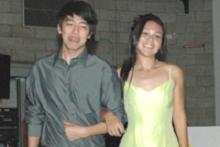 On May 1, the O'ahu 4-H club staged a Fashion Revue, Exhibit, and Photography contest with the theme “Masquerade” in the UH Art Auditorium. The versatile 4-H'ers not only created or assembled a range of glamorous garments; they also modeled them, photographed the models during their runway strut (pictured are two participants from last year's revue), entertained the audience with presentations, and created the tasty desserts that were served after the fashion show. Now, that’s well rounded. On May 1, the O'ahu 4-H club staged a Fashion Revue, Exhibit, and Photography contest with the theme “Masquerade” in the UH Art Auditorium. The versatile 4-H'ers not only created or assembled a range of glamorous garments; they also modeled them, photographed the models during their runway strut (pictured are two participants from last year's revue), entertained the audience with presentations, and created the tasty desserts that were served after the fashion show. Now, that’s well rounded.
|
Get Some Money and Do Some Good With It
5/16/2011 Source: Office of Communication Services, CTAHR Interested in alternative fuel sources or keeping the country healthy? The latest list of currently available funding opportunities is now available in grant specialist Sharee Pepper’s newsletter "New Funding Opportunities," which is posted by the CTAHR Research Office. New grant information and deadlines are available for over 33 grants of possible interest to CTAHR faculty, including 2 grants for extension personnel. Some new funding opportunities include grants for NSF Science and Technology Centers, USDA and DOE Biomass Research and Development, and USDS/NIFA Rural Health and Safety Education. The summary table at the end of the newsletter also includes deadlines for 7 USDA-AFRI Foundational Programs that are still open. The latest newsletter can always be downloaded from the New Funding Opportunities section under Research & Extension on the Employees’ page of the CTAHR Web site.
|
Out of the Garden and Into the Frying Pan
5/16/2011 Source: Office of Communication Services, CTAHR  To celebrate the culmination of their very successful first year of garden-partnership with SOFT, Noelani Elementary’s first grade classes have reaped the fruits of their labors and helped to put out a cookbook built around the bounty they grew in their gardens. In it you’ll find such tempting treats as Thai Crunch Salad, Tomato Basil Sauce, and Vegetable Frittata. The colorfully illustrated little book will definitely inspire you to get into the kitchen—and perhaps the garden, as well! To celebrate the culmination of their very successful first year of garden-partnership with SOFT, Noelani Elementary’s first grade classes have reaped the fruits of their labors and helped to put out a cookbook built around the bounty they grew in their gardens. In it you’ll find such tempting treats as Thai Crunch Salad, Tomato Basil Sauce, and Vegetable Frittata. The colorfully illustrated little book will definitely inspire you to get into the kitchen—and perhaps the garden, as well!
|
Partnering for Food Sustainability
5/16/2011 Source: Office of Communication Services, CTAHR 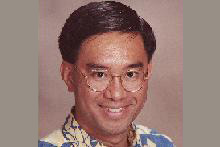 Matthew Loke, an administrator with the State Department of Agriculture, has joined NREM as visiting faculty. He’s keeping his day job, but he’ll also be working closely with PingSun Leung and other CTAHR economists to establish benchmark data to address Hawai‘i’s ability to become more independent in terms of food production and to lessen our dependence on imported food. This CTAHR-HDOA effort strives to provide long-needed information to plan for growth, to measure tangible progress, and to make sound projections on agriculture and allied industries in Hawai‘i. Welcome to the CTAHR ‘ohana, Matthew! Matthew Loke, an administrator with the State Department of Agriculture, has joined NREM as visiting faculty. He’s keeping his day job, but he’ll also be working closely with PingSun Leung and other CTAHR economists to establish benchmark data to address Hawai‘i’s ability to become more independent in terms of food production and to lessen our dependence on imported food. This CTAHR-HDOA effort strives to provide long-needed information to plan for growth, to measure tangible progress, and to make sound projections on agriculture and allied industries in Hawai‘i. Welcome to the CTAHR ‘ohana, Matthew!
|
Local Boy
5/16/2011 Source: Office of Communication Services, CTAHR 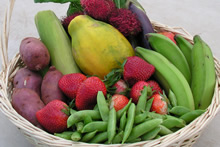 Agricultural economist PingSun Leung (NREM), winner of the 2011 CTAHR Outstanding Alumnus Award, was quoted in the May issue of Honolulu Magazine, in its special Green Hawaii section, on the importance of eating local. He says changing just 10 percent of our diets to local foods would "keep $313 million in Hawaii and create 2,300 new jobs." And the possibilites for eating local are expanding all the time, as anyone who scarfed down the locavorous fare at the recent Awards Banquet can attest. Agricultural economist PingSun Leung (NREM), winner of the 2011 CTAHR Outstanding Alumnus Award, was quoted in the May issue of Honolulu Magazine, in its special Green Hawaii section, on the importance of eating local. He says changing just 10 percent of our diets to local foods would "keep $313 million in Hawaii and create 2,300 new jobs." And the possibilites for eating local are expanding all the time, as anyone who scarfed down the locavorous fare at the recent Awards Banquet can attest.
|
Harvesting Green
5/9/2011 Source: Office of Communication Services, CTAHR 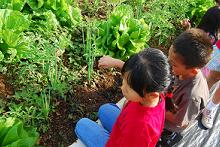 The partnership between Noelani Elementary School and the Sustainable and Organic Farm Training group is bearing fruit. On their most recent visit, the SOFT students assisted the next generation of farmers to harvest lettuce, green onions, and other goodies. That's another good way to get kids to eat their vegetables—and malama the ‘aina at the same time. The partnership between Noelani Elementary School and the Sustainable and Organic Farm Training group is bearing fruit. On their most recent visit, the SOFT students assisted the next generation of farmers to harvest lettuce, green onions, and other goodies. That's another good way to get kids to eat their vegetables—and malama the ‘aina at the same time.
|
In the Mooood for Fashion
5/9/2011 Source: Office of Communication Services, CTAHR 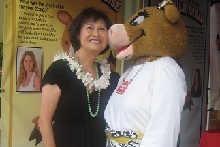 Meadow Gold and the APDM senior designers held a Lani Moo Couture Design Project this academic year. The Lani Moo Couture designs and designers were featured at Paradox Blanc, the 45th annual fashion show of the Apparel Product Design and Merchandising, at the East-West Center on May 1. Meadow Gold was a major sponsor of the fashion show, as well as making a generous donation of $2,500 towards design classroom equipment needed to enhance student learning. The Lani Moo challenge was to design and construct a complete costume for Meadow Gold’s beloved mascot Lani Moo that would combine functionality and comfort for her many public appearances. Cynthia Tsark was the faculty mentor who guided senior designers Joelle Perry, Samantha Mallon, Inbar Maor, Victoria Nyberg, Bryant Des-Brisay, Misha Pyle and Jaclyn Santos. Many thanks to Lani Moo and Meadow Gold for their support! Meadow Gold and the APDM senior designers held a Lani Moo Couture Design Project this academic year. The Lani Moo Couture designs and designers were featured at Paradox Blanc, the 45th annual fashion show of the Apparel Product Design and Merchandising, at the East-West Center on May 1. Meadow Gold was a major sponsor of the fashion show, as well as making a generous donation of $2,500 towards design classroom equipment needed to enhance student learning. The Lani Moo challenge was to design and construct a complete costume for Meadow Gold’s beloved mascot Lani Moo that would combine functionality and comfort for her many public appearances. Cynthia Tsark was the faculty mentor who guided senior designers Joelle Perry, Samantha Mallon, Inbar Maor, Victoria Nyberg, Bryant Des-Brisay, Misha Pyle and Jaclyn Santos. Many thanks to Lani Moo and Meadow Gold for their support!
|
Travel to a Better Place
5/9/2011 Source: Office of Communication Services, CTAHR A special meeting will be held to review the new Travel Policy APM A8.851. Everyone is invited to join in this Halawai Web Conference and learn about this policy’s impact on travel documents on Friday, May 13, from 10:00 to 10:30 a.m. There will be time for questions and answers. If you are interested in participating, please email your UH user ID to Adrian Lee at leea@ctahr.hawaii.edu to register for the meeting. If you want to view the meeting at a later time, also email Adrian your user ID, since it will be needed to allow you access to the recorded session. For any immediate questions about this or any other policy, please contact your fiscal officer: Diane Okubo: okubod@ctahr.hawaii.edu
Gayle Yamashita: yamashitag@ctahr.hawaii.edu
Naomi Fujita: fujitan@ctahr.hawaii.edu
Priscilla Wong: wongp@ctahr.hawaii.edu
|
An Evening of Elegance
5/9/2011 Source: Office of Communication Services, CTAHR 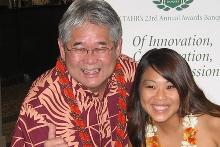 Attendees at the Awards Banquet on May 6 were entertained by the high-energy Derek Kurisu, CTAHR alumnus and local TV star, and the personable Jayna Tasaka (FCS) (both pictured) as they feasted on Farm-to-Table fare and applauded members of the CTAHR ‘ohana and friends. Certificates of commendation from the Hawai‘i State Legislature were presented to Arnold Hara, Harold Tanouye, and PingSun Leung. So many people helped to make the event a success that it would be impossible to name them all. Thanks must be given, though, to Derek for producing the fun and lively videos celebrating awardees Harold and PingSun, and to Elsie Kawahara for serving as IT technician, and to the many donors who decorated the venue and gave partygoers a tangible memento of the evening. The flowers that brought elegance to the Hibiscus Ballroom came from Tessie Amore (TPSS), Roger Corrales (Waimanalo Research Station), Marla Fergerstrom (Mealani Research Station), Joanne Lichty (Komohana Research and Extension Center), David Oka (Maui Agricultural Research Center), Ray Uchida (Cooperative Extension), Roy Yamakawa (Kaua‘i Agricultural Research Center), and the Pearl City Urban Garden Center staff. The eco gift bags, donated by the NEW project, were filled with honey from the Honey Bee project, vegetable seeds from the Agricultural Diagnostic Service Center, papayas from the Poamoho Research Station, bananas from the Waimanalo Research Station, and cards made by Shu Hwa Lin (FCS). In celebration of the growing partnership between CTAHR and the College of Engineering, the COE bought a table at the banquet and two COE students, Larry Martin and Xi Hang Cao, were recognized for their performance in the recent Student Research Symposium. In all, almost 400 people attended, including President Greenwood. She remarked on the important role CTAHR plays in Hawai‘i’s communities—and they know how to throw a great party, too! Attendees at the Awards Banquet on May 6 were entertained by the high-energy Derek Kurisu, CTAHR alumnus and local TV star, and the personable Jayna Tasaka (FCS) (both pictured) as they feasted on Farm-to-Table fare and applauded members of the CTAHR ‘ohana and friends. Certificates of commendation from the Hawai‘i State Legislature were presented to Arnold Hara, Harold Tanouye, and PingSun Leung. So many people helped to make the event a success that it would be impossible to name them all. Thanks must be given, though, to Derek for producing the fun and lively videos celebrating awardees Harold and PingSun, and to Elsie Kawahara for serving as IT technician, and to the many donors who decorated the venue and gave partygoers a tangible memento of the evening. The flowers that brought elegance to the Hibiscus Ballroom came from Tessie Amore (TPSS), Roger Corrales (Waimanalo Research Station), Marla Fergerstrom (Mealani Research Station), Joanne Lichty (Komohana Research and Extension Center), David Oka (Maui Agricultural Research Center), Ray Uchida (Cooperative Extension), Roy Yamakawa (Kaua‘i Agricultural Research Center), and the Pearl City Urban Garden Center staff. The eco gift bags, donated by the NEW project, were filled with honey from the Honey Bee project, vegetable seeds from the Agricultural Diagnostic Service Center, papayas from the Poamoho Research Station, bananas from the Waimanalo Research Station, and cards made by Shu Hwa Lin (FCS). In celebration of the growing partnership between CTAHR and the College of Engineering, the COE bought a table at the banquet and two COE students, Larry Martin and Xi Hang Cao, were recognized for their performance in the recent Student Research Symposium. In all, almost 400 people attended, including President Greenwood. She remarked on the important role CTAHR plays in Hawai‘i’s communities—and they know how to throw a great party, too!
|
SNAP To It!
5/9/2011 Source: Office of Communication Services, CTAHR  For people finding it hard to find the money to feed their families, healthy choices might not be top-of-mind. But there's help: UH-CES SNAP-Ed. The University of Hawai‘i’s Cooperative Extension Service Supplemental Nutrition Assistance Program - Education is a project funded by the United States Department of Agriculture (USDA) - Food and Nutrition Service (FNS), and contracted by Hawai‘i’s Department of Human Services (DHS). UH-CES SNAP-Ed collaborates with community agencies and other projects to provide those who have limited budgets with free nutrition education, life skills, food demonstrations, food resource management, and the encouragement to consume more fruits and vegetables in order to live a healthy lifestyle. It operates out of the Nutrition Education for Wellness program (NEW) under CTAHR’s Cooperative Extension Service. Education and activities are designed to increase nutrition knowledge and physical activity. It potentially increases the likelihood that those with limited budgets will make healthful food choices and choose a more physically active lifestyle, both concepts compatible with the most recent dietary advice, as reflected in the Dietary Guidelines for Americans and the Food Guidance System (MyPyramid.gov). For more information, contact Kami Nishimura at kamin@hawaii.edu. For people finding it hard to find the money to feed their families, healthy choices might not be top-of-mind. But there's help: UH-CES SNAP-Ed. The University of Hawai‘i’s Cooperative Extension Service Supplemental Nutrition Assistance Program - Education is a project funded by the United States Department of Agriculture (USDA) - Food and Nutrition Service (FNS), and contracted by Hawai‘i’s Department of Human Services (DHS). UH-CES SNAP-Ed collaborates with community agencies and other projects to provide those who have limited budgets with free nutrition education, life skills, food demonstrations, food resource management, and the encouragement to consume more fruits and vegetables in order to live a healthy lifestyle. It operates out of the Nutrition Education for Wellness program (NEW) under CTAHR’s Cooperative Extension Service. Education and activities are designed to increase nutrition knowledge and physical activity. It potentially increases the likelihood that those with limited budgets will make healthful food choices and choose a more physically active lifestyle, both concepts compatible with the most recent dietary advice, as reflected in the Dietary Guidelines for Americans and the Food Guidance System (MyPyramid.gov). For more information, contact Kami Nishimura at kamin@hawaii.edu.
|
Get Resources
5/3/2011 Source: Office of Communication Services, CTAHR Here are some resources on submitting grants electronically on grants.gov that may be useful:
-
-
NIFA Help Desk, phone: (202) 401-5048 (M-F 7:00 a.m. - 5:00 p.m. ET)
-
-
-
UH ORS Help Desk, phone: 956-5198 (M-F 7:45 a.m. - 4:30 p.m. HST)
|
Never Too Young for Sustainability
5/2/2011 Source: Office of Communication Services, CTAHR  These days everyone is talking about going green, but what exactly does that mean? In his bioenergy lab, Samir Khanal (MBBE, pictured in center with his class) is currently seeking to answer this question by investigating the potential for biorefineries in Hawai‘i. While there’s plenty of cutting-edge technology and science going on in Samir’s lab, at the forefront of the bio-sustainability campaign there are two high school students, Lindsay Fujimoto and Sarah Tamashiro, who are being mentored in the art of producing valuable, edible, protein-rich fungi for animal feed from the biofuel waste stream. Over the last three years, Lindsay and Sarah have proudly represented the work they have conducted in Samir’s lab at the Hawaii State Science and Engineering Fair, winning multiple awards. Their success not only showcases the research being done at CTAHR, but it also educates the younger generation and our future scientists. This year, the girls will be traveling to Los Angeles to compete in Intel's International Science and Engineering Fair (ISEF). Good luck, Sarah and Lindsay! These days everyone is talking about going green, but what exactly does that mean? In his bioenergy lab, Samir Khanal (MBBE, pictured in center with his class) is currently seeking to answer this question by investigating the potential for biorefineries in Hawai‘i. While there’s plenty of cutting-edge technology and science going on in Samir’s lab, at the forefront of the bio-sustainability campaign there are two high school students, Lindsay Fujimoto and Sarah Tamashiro, who are being mentored in the art of producing valuable, edible, protein-rich fungi for animal feed from the biofuel waste stream. Over the last three years, Lindsay and Sarah have proudly represented the work they have conducted in Samir’s lab at the Hawaii State Science and Engineering Fair, winning multiple awards. Their success not only showcases the research being done at CTAHR, but it also educates the younger generation and our future scientists. This year, the girls will be traveling to Los Angeles to compete in Intel's International Science and Engineering Fair (ISEF). Good luck, Sarah and Lindsay!
|
Calendar Pinups
5/2/2011 Source: Office of Communication Services, CTAHR  Four members of the CTAHR ‘ohana are featured in the first calendar to be produced and distributed by RCUH. The calendar was created “to showcase the diversity of exemplary research” and “outstanding researchers” at UH, including Dan Rubinoff (PEPS), Charly Kinoshita (Associate Dean, pictured), Steve Chiang (Agribusiness Education Training and Incubation), and Sylvia Yuen (Interim Dean and Director). RCUH will be distributing the calendars to all current regular-status RCUH employees, PIs, Deans/Directors, and some UH administrators. Four members of the CTAHR ‘ohana are featured in the first calendar to be produced and distributed by RCUH. The calendar was created “to showcase the diversity of exemplary research” and “outstanding researchers” at UH, including Dan Rubinoff (PEPS), Charly Kinoshita (Associate Dean, pictured), Steve Chiang (Agribusiness Education Training and Incubation), and Sylvia Yuen (Interim Dean and Director). RCUH will be distributing the calendars to all current regular-status RCUH employees, PIs, Deans/Directors, and some UH administrators.
|
Marathon Maven
5/2/2011 Source: Office of Communication Services, CTAHR  Halina Zaleski (HNFAS, pictured) was among the runners in the 2011 Boston Marathon. She completed the Patriot’s Day Marathon in 4 hours, 13 minutes, and 22 seconds. Running at a 9:40 pace, she finished 38th in her age group. Congratulations, Halina! Halina Zaleski (HNFAS, pictured) was among the runners in the 2011 Boston Marathon. She completed the Patriot’s Day Marathon in 4 hours, 13 minutes, and 22 seconds. Running at a 9:40 pace, she finished 38th in her age group. Congratulations, Halina!
|
Earth Day Planting
5/2/2011 Source: Office of Communication Services, CTAHR 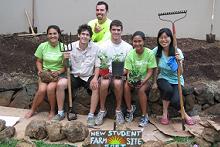 A small cadre of enthusiastic Student Organic Farm Training (SOFT) students began installing two gardens on the Manoa campus grounds as part of the UH Earth Day festivities on May 20. One garden is located on the makai side of the art building and boasts 8 varieties of banana trees and will also eventually include a few citrus trees. Before the tree canopies get too mature, the students will plant an intercropping of sweet potato, yacon, taro, cassava, pigeon pea, and jicama. The second garden is located in the Sustainability Courtyard and will have some of the same crops plus sunflowers, lemongrass, taro, cocoyam, and various herbs. Roxanne Adams, the Manoa Campus Landscaping Manager, assisted the group in getting approval for the project. A small cadre of enthusiastic Student Organic Farm Training (SOFT) students began installing two gardens on the Manoa campus grounds as part of the UH Earth Day festivities on May 20. One garden is located on the makai side of the art building and boasts 8 varieties of banana trees and will also eventually include a few citrus trees. Before the tree canopies get too mature, the students will plant an intercropping of sweet potato, yacon, taro, cassava, pigeon pea, and jicama. The second garden is located in the Sustainability Courtyard and will have some of the same crops plus sunflowers, lemongrass, taro, cocoyam, and various herbs. Roxanne Adams, the Manoa Campus Landscaping Manager, assisted the group in getting approval for the project.
|
Good Energy for the Energy House
5/2/2011 Source: Office of Communication Services, CTAHR Mary Martini (FCS), the Family Education and Training Center of Hawaii, and the Energy House were featured in the Honolulu Weekly’s 2011 Sustainability Guide (April 13-19). The Energy House is praised: “While many sustainable education programs focus on skills, youth education, and experiential learning, Energy House concentrates on the family. This has allowed Martini to reach a diverse cross-section of Hawaii and suggest that sustainable living might do a lot more than save our environment.” So is Mary: “‘Through hands on, practical skill building, we train the kids to make their families work,’ explains Martini. She may be right. For when our families work, our communities work, and it is our communities who will end up solving the problems we face environmentally.”
|
April
A Valuable Resource
4/25/2011 Source: Office of Communication Services, CTAHR  Cynthia Lai (NREM, pictured left), a graduate assistant working with Cathy Chan-Halbrendt (NREM), is one of the two CTAHR students awarded the Student Excellence in Research Award at the master's level this year. She’ll receive $650 for the university-wide award, $400 from the Research Corporation of UH and $250 from University Research Council. Cynthia also participated in the recent 23rd annual Student Research Symposium, where she received the award for the NREM Best MS Student Oral Presentation. But that’s not all—last year at the Symposium, she was honored, with Noe Abejon, with the award for the NREM Best MS Student Poster Presentation, and at the beginning of this past semester she conducted a seminar on the “Economics of Environmental Degradation Intervention and Conservation Agricultural Practices in Tribal Villages in India,” focusing on “the management of natural resources…specifically, the international agricultural sector of farmland management.” As she pointed out in her description of the seminar, “This study provides a positive catalyst for environmental awareness, agricultural technology transfer and extension research in developing countries.” An excellent researcher and a global thinker, Cynthia exemplifies what CTAHR strives to foster in its students. Cynthia Lai (NREM, pictured left), a graduate assistant working with Cathy Chan-Halbrendt (NREM), is one of the two CTAHR students awarded the Student Excellence in Research Award at the master's level this year. She’ll receive $650 for the university-wide award, $400 from the Research Corporation of UH and $250 from University Research Council. Cynthia also participated in the recent 23rd annual Student Research Symposium, where she received the award for the NREM Best MS Student Oral Presentation. But that’s not all—last year at the Symposium, she was honored, with Noe Abejon, with the award for the NREM Best MS Student Poster Presentation, and at the beginning of this past semester she conducted a seminar on the “Economics of Environmental Degradation Intervention and Conservation Agricultural Practices in Tribal Villages in India,” focusing on “the management of natural resources…specifically, the international agricultural sector of farmland management.” As she pointed out in her description of the seminar, “This study provides a positive catalyst for environmental awareness, agricultural technology transfer and extension research in developing countries.” An excellent researcher and a global thinker, Cynthia exemplifies what CTAHR strives to foster in its students.
|
Full-Bore Against the Borer
4/25/2011 Source: Office of Communication Services, CTAHR  The coffee berry borer continues to be a major concern for Hawai‘i’s coffee industry and a major target of efforts by CTAHR faculty to develop and implement effective control strategies. Hilo USDA researchers Eric Jang (pictured) and Robert Hollingsworth (both CTAHR graduates and current entomology graduate faculty) recently organized a special symposium on the coffee berry borer at the annual meeting of the Pacific Branch of the Entomological Society of America, at the Hilton Waikoloa. Speakers on the notorious pest that is threatening Kona coffee farms included CTAHR, USDA, and Hawaii Department of Agriculture specialists. As part of CTAHR’s ongoing efforts to battle the borer, the presentations from the symposium have been posted on the CTAHR coffee berry borer Web page. Coffee farmers can also find the latest recommendations for beetle control. The coffee berry borer continues to be a major concern for Hawai‘i’s coffee industry and a major target of efforts by CTAHR faculty to develop and implement effective control strategies. Hilo USDA researchers Eric Jang (pictured) and Robert Hollingsworth (both CTAHR graduates and current entomology graduate faculty) recently organized a special symposium on the coffee berry borer at the annual meeting of the Pacific Branch of the Entomological Society of America, at the Hilton Waikoloa. Speakers on the notorious pest that is threatening Kona coffee farms included CTAHR, USDA, and Hawaii Department of Agriculture specialists. As part of CTAHR’s ongoing efforts to battle the borer, the presentations from the symposium have been posted on the CTAHR coffee berry borer Web page. Coffee farmers can also find the latest recommendations for beetle control.
|
Keeping the Keiki off the Couch
4/25/2011 Source: Office of Communication Services, CTAHR 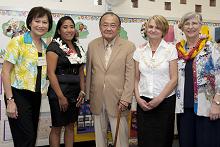 CTAHR has been awarded a $24.8 million grant by the USDA National Institute for Food and Agriculture (NIFA) to develop food, nutrition, and physical activity intervention, including training, monitoring, and evaluation systems, in order to guide sustainable development of children’s obesity-prevention programs and policies in the Pacific region. The 5-year competitive grant, the only one of its kind nationwide, funds the Children’s Healthy Living Program for Remote Underserved Minority Populations in the Pacific (CHIL), led by Rachel Novotny (HNFAS, pictured with Sylvia Yuen, Daniel Inouye, and Virginia Hinshaw). The program’s goal is to build social/cultural, political/economic, and physical/built environments in partnership with local communities to promote active play and intake of healthy food, in order to prevent childhood obesity in Hawai‘i, Alaska, American Samoa, the Commonwealth of the Northern Marianas, Guam, the Federated States of Micronesia, Palau, and the Republic of the Marshall Islands. Rachel says, “Native communities in the Pacific Region are seriously underrepresented in obesity research, despite a high prevalence of obesity and related behavioral and environmental risk factors. According to the few available data for the region, prevalence of overweight and obesity has been estimated at 60-90% of the adult population and 15-45% of 2- to 8-year-olds, higher than levels seen in the contiguous U.S.” Senator Daniel Inouye, present at the announcement of the grant, pointed out that “Childhood obesity is an expensive epidemic in America, and combating it requires diligence and proper education.” CTAHR has been awarded a $24.8 million grant by the USDA National Institute for Food and Agriculture (NIFA) to develop food, nutrition, and physical activity intervention, including training, monitoring, and evaluation systems, in order to guide sustainable development of children’s obesity-prevention programs and policies in the Pacific region. The 5-year competitive grant, the only one of its kind nationwide, funds the Children’s Healthy Living Program for Remote Underserved Minority Populations in the Pacific (CHIL), led by Rachel Novotny (HNFAS, pictured with Sylvia Yuen, Daniel Inouye, and Virginia Hinshaw). The program’s goal is to build social/cultural, political/economic, and physical/built environments in partnership with local communities to promote active play and intake of healthy food, in order to prevent childhood obesity in Hawai‘i, Alaska, American Samoa, the Commonwealth of the Northern Marianas, Guam, the Federated States of Micronesia, Palau, and the Republic of the Marshall Islands. Rachel says, “Native communities in the Pacific Region are seriously underrepresented in obesity research, despite a high prevalence of obesity and related behavioral and environmental risk factors. According to the few available data for the region, prevalence of overweight and obesity has been estimated at 60-90% of the adult population and 15-45% of 2- to 8-year-olds, higher than levels seen in the contiguous U.S.” Senator Daniel Inouye, present at the announcement of the grant, pointed out that “Childhood obesity is an expensive epidemic in America, and combating it requires diligence and proper education.”
|
Star Power
4/25/2011 Source: Office of Communication Services, CTAHR 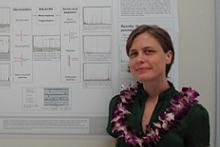 Described as one of “the best and brightest rising stars at UHM,” Margaret Ruzicka (PhD-MBBE, pictured) will be honored with a 2011 Achievement Rewards for College Scientists (ARCS) Award from the Honolulu chapter of the organization. She gave a presentation on her research this past weekend at the 2011 Scholar Presentations, applauded by her proud mentor Charly Kinoshita, but the actual award, the Helen Jones Farrar Award in Tropical Agriculture, will be conferred at the ARCS Scholar Award Banquet on May 2. At that time the ARCS Scholar of the Year Award will be announced (Margaret’s in the running for this, as well). She also, not surprisingly, was selected for the best PhD poster presentation award at this year’s Student Research Symposium, and as a master’s student, Margaret won a bronze medal as part of a team of student researchers who created a “toolkit” of synthetic DNA sequences. Her star is continuing to rise! Described as one of “the best and brightest rising stars at UHM,” Margaret Ruzicka (PhD-MBBE, pictured) will be honored with a 2011 Achievement Rewards for College Scientists (ARCS) Award from the Honolulu chapter of the organization. She gave a presentation on her research this past weekend at the 2011 Scholar Presentations, applauded by her proud mentor Charly Kinoshita, but the actual award, the Helen Jones Farrar Award in Tropical Agriculture, will be conferred at the ARCS Scholar Award Banquet on May 2. At that time the ARCS Scholar of the Year Award will be announced (Margaret’s in the running for this, as well). She also, not surprisingly, was selected for the best PhD poster presentation award at this year’s Student Research Symposium, and as a master’s student, Margaret won a bronze medal as part of a team of student researchers who created a “toolkit” of synthetic DNA sequences. Her star is continuing to rise!
|
Researchers of Tomorrow
4/25/2011 Source: Office of Communication Services, CTAHR 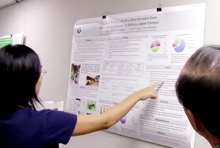 This year, CTAHR teamed up for the first time with the College of Engineering (COE) for the 23rd annual Student Research Symposium. Over 300 students, faculty, staff, and guests gathered for a lively, scholarly exchange over the 135 poster and oral presentations by undergraduate and graduate students in 5 CTAHR departments and 3 departments in COE. The caliber of the students’ work was truly impressive. Thanks must go to those whose hard work made this event successful, including the student participants and faculty advisor/mentors, judges and moderators, staff and student volunteers, members of the Symposium Planning Committee, and last but not least Chef Mark Segobiano and his students for preparing the food and refreshments for the symposium. Many students distinguished themselves and were honored for their work, but here are the all-college all-stars: This year, CTAHR teamed up for the first time with the College of Engineering (COE) for the 23rd annual Student Research Symposium. Over 300 students, faculty, staff, and guests gathered for a lively, scholarly exchange over the 135 poster and oral presentations by undergraduate and graduate students in 5 CTAHR departments and 3 departments in COE. The caliber of the students’ work was truly impressive. Thanks must go to those whose hard work made this event successful, including the student participants and faculty advisor/mentors, judges and moderators, staff and student volunteers, members of the Symposium Planning Committee, and last but not least Chef Mark Segobiano and his students for preparing the food and refreshments for the symposium. Many students distinguished themselves and were honored for their work, but here are the all-college all-stars:
- CTAHR Best PhD Student Oral Presentation: Margaret Ruzicka (MBBE)
- CTAHR Best PhD Student Poster Presentation: Akhil Srivastava (PEPS)
- CTAHR Best MS Student Oral Presentation: Angelita Acebes (PEPS)
- CTAHR Best MS Student Poster Presentation: Phoebe Hwang (TPSS)
- CTAHR Best Undergraduate Oral Presentation-CTAHR: Page Iida (HNFAS)
- CTAHR Best Undergraduate Oral Presentation-COE: Larry Martin (Electrical Engineering)
- CTAHR Best Undergraduate Poster Presentation-CTAHR: Kara Yamada/Kacie Ho (HNFAS)
- CTAHR Best Undergraduate Poster Presentation-COE: Xi Hang Cao (Electrical Engineering)
Here's the full list of student honorees (you'll have to scroll down a bit to get to it).
|
Researching Health
4/25/2011 Source: Office of Communication Services, CTAHR 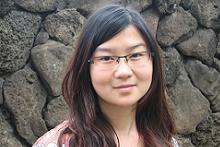 Worried about the numerous outbreaks of food poisoning that have been sickening consumers in the Islands and throughout the country? Don’t be: Ningjian Liang (master’s, HNFAS) is working on the problem. Ningjian has just won a Student Excellence in Research Award, one of two awarded to CTAHR students out of only three university-wide. She has successfully established a method for rapid detection of live Salmonella cells in lettuce, one of the most common vectors for food poisoning in the news lately. What she demonstrated could greatly improve the accuracy of routine DNA-based detection methods, and this work will appear soon in the Journal of Food Science. She has submitted another manuscript, on the natural antimicrobial effect of noni juice, to the International Journal of Food Microbiology and has co-authored 2 other manuscripts that have also been submitted for publication. Ningjian’s research is closely related to the safety of the U.S. food supply; it has provided valuable information for food manufacturers and regulatory agencies to monitor food production and protect the public’s health. Not only that: Last year Ningjian won 2nd place for her MS Student Poster Presentation in the Student Research Symposium, and this year she captured the award for HNFAS Best Graduate Student Poster Presentation at the same venue. Her mentor, Yong Li, says he’s sure she’ll excel in research; we’d say she’s well on her way. Worried about the numerous outbreaks of food poisoning that have been sickening consumers in the Islands and throughout the country? Don’t be: Ningjian Liang (master’s, HNFAS) is working on the problem. Ningjian has just won a Student Excellence in Research Award, one of two awarded to CTAHR students out of only three university-wide. She has successfully established a method for rapid detection of live Salmonella cells in lettuce, one of the most common vectors for food poisoning in the news lately. What she demonstrated could greatly improve the accuracy of routine DNA-based detection methods, and this work will appear soon in the Journal of Food Science. She has submitted another manuscript, on the natural antimicrobial effect of noni juice, to the International Journal of Food Microbiology and has co-authored 2 other manuscripts that have also been submitted for publication. Ningjian’s research is closely related to the safety of the U.S. food supply; it has provided valuable information for food manufacturers and regulatory agencies to monitor food production and protect the public’s health. Not only that: Last year Ningjian won 2nd place for her MS Student Poster Presentation in the Student Research Symposium, and this year she captured the award for HNFAS Best Graduate Student Poster Presentation at the same venue. Her mentor, Yong Li, says he’s sure she’ll excel in research; we’d say she’s well on her way.
|
Now If They Could Just Make Dieting Fun...
4/18/2011 Source: Office of Communication Services, CTAHR  For over 20 years, Anne Shovic (HNFAS, pictured) has directed the Didactic Program in Dietetics, which prepares UH students to become Registered Dietitians (RD). Now the program is up for reaccreditation from the American Dietetic Association’s Commission on Accreditation for Dietetics Education, but Anne and her students aren’t worried: They know the program meets or exceeds all the standards, including the following: For over 20 years, Anne Shovic (HNFAS, pictured) has directed the Didactic Program in Dietetics, which prepares UH students to become Registered Dietitians (RD). Now the program is up for reaccreditation from the American Dietetic Association’s Commission on Accreditation for Dietetics Education, but Anne and her students aren’t worried: They know the program meets or exceeds all the standards, including the following:
- Over a 5-year period, 90% of enrolled students must complete the program within 3 years. In the HNFAS program, between 2006 and 2011, 96% of the students completed the program.
- Graduated students must achieve a pass rate of 80% or above for first-time test takers of the RD examination. Here, over 85% pass.
- Within 6 months of graduating from a dietetics internship, 80% of the program graduates residing in Hawai‘i must have obtained employment related to nutrition. Here, 100% were employed, most within 2 months.
|
Hurry Up and Wait
4/18/2011 Source: Office of Communication Services, CTAHR It’s that time of year already—registration starts this week for continuing students. For more general information, here's the 2011-2014 academic calendar for UH-Manoa. And speaking of registration, UHM will be implementing the use of wait lists for the Fall 2011 semester for students registering for courses via the University of Hawai‘i Information and Services Portal (MyUH). Wait lists will only be implemented for a dozen or so high-demand classes, of which FAMR 230 will be one. Be proud that CTAHR boasts such a highly desirable class—and breathe a little easier that you may have a better chance of getting into it.
|
Summer Learning
4/18/2011 Source: Office of Communication Services, CTAHR In an effort to provide a summer session that better meets the needs of students, Outreach College is considering two changes for Summer 2012. First, they’re thinking of offering 3-week, 3-credit courses meeting for 3 hours a day, one session at the very beginning of summer break and one at the end. These could be added on to the summer schedule that already exists. The college is also considering reducing the 2 existing 6-week summer sessions to 5 weeks each, with classes being increased from 75 to 95 minutes per day. This could allow summer sessions to start later, making it possible for students from other universities whose spring semesters end later to enroll. Here is the full memo on the proposed changes. Outreach College is in the planning stages of these proposals and would like to get input from faculty and staff. Please send your comments directly to Dean Chismar of Outreach College at chismar@hawaii.edu.
|
BBC Takes Aim at GMO Papaya; GMO Papaya Survives
4/11/2011 Source: Office of Communication Services, CTAHR 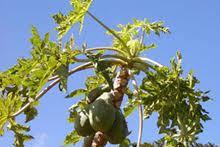 A team from the British Broadcasting Co. (BBC) recently came to film in David Christopher’s lab (MBBE) for their popular science show Bang Goes the Theory. The film team explored the science behind genetically engineering papaya with the help of David and Dennis Gonsalves. On the Big Island, Dennis chronicled the history of papaya diseases, such as ring spot virus (pictured) and Phytophthora wilt, and the usefulness of new biotechnological tools to solve these disease problems. The crew then relocated to David’s lab, where he and his students provided a step-by-step guide on isolating papaya genes, bioengineering papaya cells, and regenerating whole papaya plants from tissue culture. The show’s host, Liz Bonnin, interviewed David, who discussed the benefits of biotechnology research, which will decrease fungicide use on the farm. Although Europe has been rigidly skeptical of biotechnology, David believes it is essential that universities address this skepticism and offer an accurate view of how research in tropical agricultural science can improve our world. Previous episodes of Bang have featured Craig Venter discussing the human genome and Richard Dawkins on evolution. The episode on papaya is expected to air in early May. A team from the British Broadcasting Co. (BBC) recently came to film in David Christopher’s lab (MBBE) for their popular science show Bang Goes the Theory. The film team explored the science behind genetically engineering papaya with the help of David and Dennis Gonsalves. On the Big Island, Dennis chronicled the history of papaya diseases, such as ring spot virus (pictured) and Phytophthora wilt, and the usefulness of new biotechnological tools to solve these disease problems. The crew then relocated to David’s lab, where he and his students provided a step-by-step guide on isolating papaya genes, bioengineering papaya cells, and regenerating whole papaya plants from tissue culture. The show’s host, Liz Bonnin, interviewed David, who discussed the benefits of biotechnology research, which will decrease fungicide use on the farm. Although Europe has been rigidly skeptical of biotechnology, David believes it is essential that universities address this skepticism and offer an accurate view of how research in tropical agricultural science can improve our world. Previous episodes of Bang have featured Craig Venter discussing the human genome and Richard Dawkins on evolution. The episode on papaya is expected to air in early May.
|
International Partners
4/11/2011 Source: Office of Communication Services, CTAHR 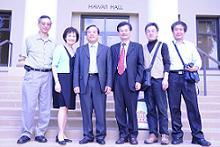 CTAHR has actively been pursuing opportunities for international collaboration with institutions in Asia in the last several years, including formal university-wide Memoranda of Understanding (MOUs) with six universities in China, two in the Philippines, and one in Vietnam. A delegation from the National Chung-Hsing University (NCHU), led by its president Jei-Fu Shaw, visited UH-Manoa on Mar. 28. President Shaw and Chancellor Virginia Hinshaw signed a collaborative MOU during Jei-Fu's campus visit, which was witnessed by Vice Chancellor Gary Ostrander, Interim Assistant Vice Chancellor CY Hu, Dean Sylvia Yuen and Dr. Po-Yung Lai. Both CY and Po-Yung are alumni of NCHU. Established in 1919, National Chung Hsing University is the oldest comprehensive national university in Taiwan, and is also the only research-oriented university in central Taiwan, chosen by Taiwan's Ministry of Education as one of the top 11 universities in Taiwan. CTAHR has actively been pursuing opportunities for international collaboration with institutions in Asia in the last several years, including formal university-wide Memoranda of Understanding (MOUs) with six universities in China, two in the Philippines, and one in Vietnam. A delegation from the National Chung-Hsing University (NCHU), led by its president Jei-Fu Shaw, visited UH-Manoa on Mar. 28. President Shaw and Chancellor Virginia Hinshaw signed a collaborative MOU during Jei-Fu's campus visit, which was witnessed by Vice Chancellor Gary Ostrander, Interim Assistant Vice Chancellor CY Hu, Dean Sylvia Yuen and Dr. Po-Yung Lai. Both CY and Po-Yung are alumni of NCHU. Established in 1919, National Chung Hsing University is the oldest comprehensive national university in Taiwan, and is also the only research-oriented university in central Taiwan, chosen by Taiwan's Ministry of Education as one of the top 11 universities in Taiwan.
|
Whiteflies and Fruit Flies and Bananas, Oh My
4/11/2011 Source: Office of Communication Services, CTAHR 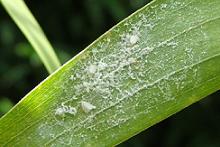 On Apr. 1, CTAHR received two visitors from the Hainan province in China, Vice President Xiaoqiang Qiu of the Chinese Academy of Tropical Agricultural Sciences (CATAS), and Kui Liu, Deputy Director, Institute of Environment and Plant Protection, CATAS. UHM and CATAS signed an MOU (Memorandum of Understanding) in Aug. 2010 to foster a closer collaboration between the two institutions. Under this MOU, Changshun Jiang came to Jim Brewbaker’s lab to learn more about Leucaena in Oct. 2010. Jingyang Li, a junior researcher from the Institute of Bananas and Plantains, spent six months conducting research in John Hu’s laboratory (PEPS) and just returned home last week. Zhanwu Sheng, from the same institute, is arriving on Apr. 8 to work with Soojin Jun (HNFAS) for six months. Both Vice President Qiu and Kui Liu have plant protection backgrounds and are interested in getting firsthand information on Hawai‘i’s success in the biological control of the spiraling whitefly (pictured), which was recently found in Hainan. In addition to biocontrol of the whitefly, Kui is also interested in Hawai‘i’s fruit fly program. More faculty and graduate students from CATAS also intend to come to CTAHR to conduct collaborative research. On Apr. 1, CTAHR received two visitors from the Hainan province in China, Vice President Xiaoqiang Qiu of the Chinese Academy of Tropical Agricultural Sciences (CATAS), and Kui Liu, Deputy Director, Institute of Environment and Plant Protection, CATAS. UHM and CATAS signed an MOU (Memorandum of Understanding) in Aug. 2010 to foster a closer collaboration between the two institutions. Under this MOU, Changshun Jiang came to Jim Brewbaker’s lab to learn more about Leucaena in Oct. 2010. Jingyang Li, a junior researcher from the Institute of Bananas and Plantains, spent six months conducting research in John Hu’s laboratory (PEPS) and just returned home last week. Zhanwu Sheng, from the same institute, is arriving on Apr. 8 to work with Soojin Jun (HNFAS) for six months. Both Vice President Qiu and Kui Liu have plant protection backgrounds and are interested in getting firsthand information on Hawai‘i’s success in the biological control of the spiraling whitefly (pictured), which was recently found in Hainan. In addition to biocontrol of the whitefly, Kui is also interested in Hawai‘i’s fruit fly program. More faculty and graduate students from CATAS also intend to come to CTAHR to conduct collaborative research.
|
AgFest Rocks Maui
4/11/2011 Source: Office of Communication Services, CTAHR 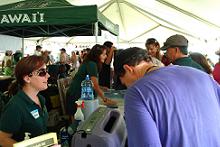 The fourth annual Maui County Agricultural Festival, held on Apr. 2, attracted more than 6,500 Maui islanders. Though the Festival was sponsored by Maui County Farm Bureau, the County of Maui, A&B Foundation, and Maui Tropical Plantation, CTAHR was featured prominently in the Ag Education Tent. Norman Nagata (TPSS, Extension) and Robin Shimabuku (PEPS, Extension) held a plant clinic and helped attendees with insect and disease problems; James Leary (NREM) showcased unique instruments used in combating invasive plant species; Gayle Hori and Martha Coleman (both TPSS) presented CTAHR’s Ag Biotechnology Education program; Jessica Radovich and Jensen Uyeda (TPSS, grad student) provided information and answered questions about CTAHR’s popular Sustainable and Organic Farming Systems program; Luisa Castro (NREM) demonstrated dynamic watershed models; Heather Greenwood (FCS, Extension) and Lynn Nakamura-Tengan (HNFAS, Extension) connected growing and eating; Charly Kinoshita (Associate Dean) answered questions on CTAHR’s academic programs; and Harold Keyser (Maui County administrator) and Master Gardener volunteers Lance Mohler, Lori Unfus, Laura Mclean, Nancy Breese-Holmes, and Merlene Mason provided general information about CTAHR and its Cooperative Extension programs, as well as selling seed from ADSC and taro plants to home gardeners. The fourth annual Maui County Agricultural Festival, held on Apr. 2, attracted more than 6,500 Maui islanders. Though the Festival was sponsored by Maui County Farm Bureau, the County of Maui, A&B Foundation, and Maui Tropical Plantation, CTAHR was featured prominently in the Ag Education Tent. Norman Nagata (TPSS, Extension) and Robin Shimabuku (PEPS, Extension) held a plant clinic and helped attendees with insect and disease problems; James Leary (NREM) showcased unique instruments used in combating invasive plant species; Gayle Hori and Martha Coleman (both TPSS) presented CTAHR’s Ag Biotechnology Education program; Jessica Radovich and Jensen Uyeda (TPSS, grad student) provided information and answered questions about CTAHR’s popular Sustainable and Organic Farming Systems program; Luisa Castro (NREM) demonstrated dynamic watershed models; Heather Greenwood (FCS, Extension) and Lynn Nakamura-Tengan (HNFAS, Extension) connected growing and eating; Charly Kinoshita (Associate Dean) answered questions on CTAHR’s academic programs; and Harold Keyser (Maui County administrator) and Master Gardener volunteers Lance Mohler, Lori Unfus, Laura Mclean, Nancy Breese-Holmes, and Merlene Mason provided general information about CTAHR and its Cooperative Extension programs, as well as selling seed from ADSC and taro plants to home gardeners.
|
Feed Your Children Well
4/4/2011 Source: Office of Communication Services, CTAHR The Hawaii Child Care Nutrition Program (HCCNP), a project funded by the State of Hawai‘i Department of Human Services, provides free nutrition-related services to licensed child care providers throughout the state. HCCNP operates out of the Nutrition Education for Wellness program under CTAHR’s Cooperative Extension Service and provides services, including consultation for the nutrition portion of state licensing requirements, access to free food and nutrition education, training, and resources. Information about menu planning, previous newsletters and resources about healthy home lunches, snacks and more, can be found on HCCNP’s Web site. HCCNP also collaborates with other agencies and projects with the ultimate goal of helping licensed child care providers gain access to quality nutrition services and information. For more information, contact Kim Kanechika at kkanechi@hawaii.edu.
|
Taking Piggy Banks to the Next Level
4/4/2011 Source: Office of Communication Services, CTAHR 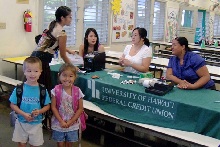 Michael Cheang (FCS) and his Kids Savings Project were recently featured in the Honolulu Weekly. Now in its third year, the project has enabled over a thousand children to save more than $115,000. Cheang has garnered grants and community partnerships that allow each child to receive $25 to start a savings account at one of a number of credit unions. Eighteen DOE schools on Oahu and the neighbor islands are now participating in the program, which also offers saving advice to the students’ parents. Cheang points out that “families in Hawai‘i without emergency funds are only a few months away from being homeless. Research shows that those who get in the habit of saving when they are young tend to be better at managing their finances and lives as adults.” Michael Cheang (FCS) and his Kids Savings Project were recently featured in the Honolulu Weekly. Now in its third year, the project has enabled over a thousand children to save more than $115,000. Cheang has garnered grants and community partnerships that allow each child to receive $25 to start a savings account at one of a number of credit unions. Eighteen DOE schools on Oahu and the neighbor islands are now participating in the program, which also offers saving advice to the students’ parents. Cheang points out that “families in Hawai‘i without emergency funds are only a few months away from being homeless. Research shows that those who get in the habit of saving when they are young tend to be better at managing their finances and lives as adults.”
|
Partnerships Across the Globe
4/4/2011 Source: Office of Communication Services, CTAHR 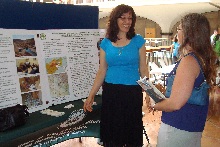 On Mar. 18, faculty and students from NREM showcased their international partnerships with Iraq and Afghanistan at the International Education Day at the State Capitol. The event, sponsored by DBEDT, the Japan America Society of Hawaii, Study Hawaii, and the Office of Representative Karen Awana, was held to give Hawai'i’s higher education institutions the opportunity to highlight to lawmakers the many international connections that they have developed, and to expose legislators to their vast global engagement and how these ties strengthen our community. Ekhlass Jarjees and Jean Fantle-Lepczyk displayed posters highlighting NREM’s international programs (Iraqi Kurdistan-funded KAHEAD and HED-funded AHEED in Albania). The Iraq program display shed the light also on recently completed USDA-funded portal program for Iraq and Afghanistan Provincial Reconstruction Teams (PRT-Portal), as well as other initiatives under development such as the National Agricultural Higher Education and Development (NAHEAD) and Alternative Designs for Planning Sustainable Natural Area Reserves (NARs) in Northern Iraq. On Mar. 18, faculty and students from NREM showcased their international partnerships with Iraq and Afghanistan at the International Education Day at the State Capitol. The event, sponsored by DBEDT, the Japan America Society of Hawaii, Study Hawaii, and the Office of Representative Karen Awana, was held to give Hawai'i’s higher education institutions the opportunity to highlight to lawmakers the many international connections that they have developed, and to expose legislators to their vast global engagement and how these ties strengthen our community. Ekhlass Jarjees and Jean Fantle-Lepczyk displayed posters highlighting NREM’s international programs (Iraqi Kurdistan-funded KAHEAD and HED-funded AHEED in Albania). The Iraq program display shed the light also on recently completed USDA-funded portal program for Iraq and Afghanistan Provincial Reconstruction Teams (PRT-Portal), as well as other initiatives under development such as the National Agricultural Higher Education and Development (NAHEAD) and Alternative Designs for Planning Sustainable Natural Area Reserves (NARs) in Northern Iraq.
|
Family Money
4/4/2011 Source: Office of Communication Services, CTAHR 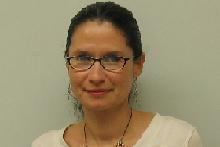 Sarah Yuan (COF) and Ivette Stern (COF, pictured) have just finished the Hawai‘i Community Stabilization Initiative, a report created for the Hawai‘i Community Foundation, which is interested in assessing, tracking, and mitigating the impact of the economic recession on Hawai‘i’s families and individuals. The report looks at unemployment rates and their correlation with increased enrollment in institutions of higher education, falling homeownership rates, financial safety nets, the utilization of tax credits for families with children, and family expenditure rates and basic needs. The report thus offers, it says, “a comprehensive framework for understanding the economic conditions of Hawai‘i’s residents in the context of the recent recession and current recovery phase.” Sarah Yuan (COF) and Ivette Stern (COF, pictured) have just finished the Hawai‘i Community Stabilization Initiative, a report created for the Hawai‘i Community Foundation, which is interested in assessing, tracking, and mitigating the impact of the economic recession on Hawai‘i’s families and individuals. The report looks at unemployment rates and their correlation with increased enrollment in institutions of higher education, falling homeownership rates, financial safety nets, the utilization of tax credits for families with children, and family expenditure rates and basic needs. The report thus offers, it says, “a comprehensive framework for understanding the economic conditions of Hawai‘i’s residents in the context of the recent recession and current recovery phase.”
|
Bug Off...to the Nationals
4/4/2011 Source: Office of Communication Services, CTAHR  CTAHR’s entomology graduate students distinguished themselves at the recent Pacific Branch meeting of the Entomological Society of America (ESA). The 8-member team for the Linnean Games (an entomological trivia competition) consisted of Will Haines, Jesse Eiben, Luc Leblanc, April Greenwell, Angelita Acebes, Rosalie Leiner, Clesson Higashi, and Michael San Jose. The team, which is led by Helen Spafford (pictured), soundly beat the Oregon State University team but lost to UC Davis by one question in the Sudden Death tiebreaker round. However, their status as first runners-up allows them to compete at the Linnean Games competition at the National meeting of the ESA later this year. In addition, individual students won a number of awards: CTAHR’s entomology graduate students distinguished themselves at the recent Pacific Branch meeting of the Entomological Society of America (ESA). The 8-member team for the Linnean Games (an entomological trivia competition) consisted of Will Haines, Jesse Eiben, Luc Leblanc, April Greenwell, Angelita Acebes, Rosalie Leiner, Clesson Higashi, and Michael San Jose. The team, which is led by Helen Spafford (pictured), soundly beat the Oregon State University team but lost to UC Davis by one question in the Sudden Death tiebreaker round. However, their status as first runners-up allows them to compete at the Linnean Games competition at the National meeting of the ESA later this year. In addition, individual students won a number of awards:
- Tyler Ito: Best Student Presentation in the Master’s-level competition
- Angelita Acebes: runner-up for Best Student Presentation in the Master’s-level competition
- Luc Leblanc: Thomas Say Award from the Entomological Foundation
- Makena Mason: Jeffery LaFage Graduate Student Award
- Nirmala Hapukotuwa: Shripat Kamble Urban Entomology Award
- Jesse Eiben: Snodgrass Memorial Award
|
March
Incubating an Awardee
3/28/2011 Source: Office of Communication Services, CTAHR 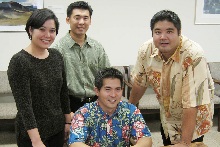 Steven Chiang (pictured), director of UH’s Agribusiness Incubator Program (AIP), was selected as the Research Corporation of the University of Hawai‘i (RCUH)’s 2010 Outstanding Employee of the Year in the Professional Staff category. Nominated by CTAHR Associate Dean Charles Kinoshita and former Dean Andrew Hashimoto, Steve was selected by RCUH for making demonstrable, significant, and outstanding contributions to his program during the past year. The list of very accomplished nominees for that award also included NREM’s own Dr. Farhat Abbas, nominated by Dr. Ali Fares, for valuable research in watershed hydrology. In addition to being recognized for outstanding contributions at RCUH’s annual Outstanding Employee of the Year Awards Luncheon on Feb. 25, Steven received a cash award of $1,000. Established in CTAHR in 2004, with major funding from USDA/NIFA’s Alaska Native-/Native Hawaiian-Serving Education Institutions Grants Program, the Agribusiness Incubator Program provides business-consulting services to agriculture-related businesses throughout the state to strengthen their viability and success and to grow the state’s diversified agriculture industry. Steven Chiang (pictured), director of UH’s Agribusiness Incubator Program (AIP), was selected as the Research Corporation of the University of Hawai‘i (RCUH)’s 2010 Outstanding Employee of the Year in the Professional Staff category. Nominated by CTAHR Associate Dean Charles Kinoshita and former Dean Andrew Hashimoto, Steve was selected by RCUH for making demonstrable, significant, and outstanding contributions to his program during the past year. The list of very accomplished nominees for that award also included NREM’s own Dr. Farhat Abbas, nominated by Dr. Ali Fares, for valuable research in watershed hydrology. In addition to being recognized for outstanding contributions at RCUH’s annual Outstanding Employee of the Year Awards Luncheon on Feb. 25, Steven received a cash award of $1,000. Established in CTAHR in 2004, with major funding from USDA/NIFA’s Alaska Native-/Native Hawaiian-Serving Education Institutions Grants Program, the Agribusiness Incubator Program provides business-consulting services to agriculture-related businesses throughout the state to strengthen their viability and success and to grow the state’s diversified agriculture industry.
|
Everything You Need to Know
3/28/2011 Source: Office of Communication Services, CTAHR 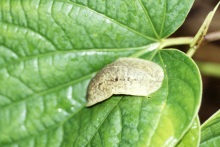 Need to know how to grow a head of lettuce in a cranberry juice bottle? Want to find out how many kupuna over the age of 85 live in our state? CTAHR offers publications on an astounding array of topics. All of them published in the last few years are downloadable from our Web site, while more and more of the older ones are becoming available all the time as they are scanned and uploaded. A sampling of recent publications includes “Best Food-Safety Practices for Hawai'i Gardeners” by James R. Hollyer, Luisa F. Castro, Vanessa A. Troegner, Lynn Nakamura-Tengan, and Norman Arancon; “The Costs of ‘Organic’ Insecticides” by Linda J. Cox, Theodore J. Radovich, and Jari Sugano; and “Recommendations for Cleaning Garments and Textiles” by Shu-Hwa Lin, Jazmine Nakamura, and Kelly Mammel. From them you’ll learn how to avoid rat lungworm disease in garden produce (don’t eat any snails or slugs, for a start); how neem oil works (it prevents feeding and molting of certain pests); and even why sheep don’t shrink when they get wet (it’s the tumble-drying, as well as the wet laundering, that makes wool shrink). And there’s a whole lot more, too! Need to know how to grow a head of lettuce in a cranberry juice bottle? Want to find out how many kupuna over the age of 85 live in our state? CTAHR offers publications on an astounding array of topics. All of them published in the last few years are downloadable from our Web site, while more and more of the older ones are becoming available all the time as they are scanned and uploaded. A sampling of recent publications includes “Best Food-Safety Practices for Hawai'i Gardeners” by James R. Hollyer, Luisa F. Castro, Vanessa A. Troegner, Lynn Nakamura-Tengan, and Norman Arancon; “The Costs of ‘Organic’ Insecticides” by Linda J. Cox, Theodore J. Radovich, and Jari Sugano; and “Recommendations for Cleaning Garments and Textiles” by Shu-Hwa Lin, Jazmine Nakamura, and Kelly Mammel. From them you’ll learn how to avoid rat lungworm disease in garden produce (don’t eat any snails or slugs, for a start); how neem oil works (it prevents feeding and molting of certain pests); and even why sheep don’t shrink when they get wet (it’s the tumble-drying, as well as the wet laundering, that makes wool shrink). And there’s a whole lot more, too!
|
The Next Generation of Research
3/28/2011 Source: Office of Communication Services, CTAHR On Apr. 8 and 9, CTAHR will be joined for the first time by the College of Engineering (COE) to partner in sponsoring the 2011 Student Research Symposium. This annual event, now in its 23rd year, will bring together graduate and undergraduate students to share their research by presenting their findings, exchanging information, and incorporating what they’ve learned from their peers into their own scholarly work. The investigations will encompass engineering, production agriculture, environmental technologies, health and food sciences, family and consumer sciences, and natural sciences. All stages of the research and development process and all types of student learning experiences will be represented: discovery; advanced diagnostics and laboratory testing; design, validation, and field testing; and adoption of new methods and technologies. A panel of judges will score each oral and poster presentation to determine award winners, who will be honored at CTAHR’s Awards Banquet. Some awards also carry with them travel grants so the student can present her or his work at a professional conference. This event showcases the exciting work being done by our student researchers as well as the growing partnership between CTAHR and COE.
|
Fashion Magic
3/21/2011 Source: Office of Communication Services, CTAHR 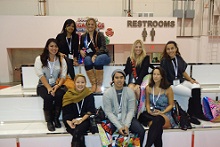 Andy Reilly, Cynthia Tsark, and Lori Yancura (all FCS) recently took 18 students to one of the largest buying conventions in the world, appropriately known as “Magic.” The convention, which takes place in Las Vegas biannually, is host to over 5,000 vendors from around the world. Students experienced the buying process first-hand as retailers made deals and ordered merchandise for Fall 2012. Andy Reilly, Cynthia Tsark, and Lori Yancura (all FCS) recently took 18 students to one of the largest buying conventions in the world, appropriately known as “Magic.” The convention, which takes place in Las Vegas biannually, is host to over 5,000 vendors from around the world. Students experienced the buying process first-hand as retailers made deals and ordered merchandise for Fall 2012.
|
The Party in Waimanalo
3/21/2011 Source: Office of Communication Services, CTAHR 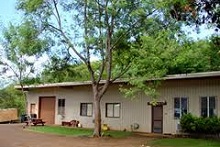 The Waimanalo Research Station recently received a visit from the Democratic Party Environmental and Agricultural Caucus. Roger Corrales, the manager of the station, worked hard to clean up storm damage before the visit, and he and Jari Sugano (PEPS Extension), Ethel Villalobos (PEPS), Scott Nikaido (grad student, PEPS) and Tyler Ito (grad student, PEPS) hosted the 36 guests. The caucus members enjoyed seeing the farm and hearing about the work with honeybees, taro, and termites that’s going on there. They were also given honey from CTAHR’s own hives, which probably contributed to their sweet impression of the station. The Waimanalo Research Station recently received a visit from the Democratic Party Environmental and Agricultural Caucus. Roger Corrales, the manager of the station, worked hard to clean up storm damage before the visit, and he and Jari Sugano (PEPS Extension), Ethel Villalobos (PEPS), Scott Nikaido (grad student, PEPS) and Tyler Ito (grad student, PEPS) hosted the 36 guests. The caucus members enjoyed seeing the farm and hearing about the work with honeybees, taro, and termites that’s going on there. They were also given honey from CTAHR’s own hives, which probably contributed to their sweet impression of the station.
|
Smoke Without a Fire
3/21/2011 Source: Office of Communication Services, CTAHR  To follow up on last week’s story “Five Fire Trucks in Search of a Fire,” we are glad to report that there indeed was no fire, either thermal or chemical, only smoke. After an internal fact-finding mission, including interviews with affected parties, the source of the smoke that triggered the alarm to evacuate Agricultural Science Phase III building on Mar. 11 remains a mystery. Everyone involved acted safely, responsibly, and properly, and the cooperation of everyone in the safe and orderly evacuation of the building is hereby acknowledged. This is a good opportunity to remind the CTAHR ‘ohana to be safe, vigilant, and attentive to your surrounding facility environment. If you see smoke or fire, pull the fire alarm and evacuate the building. Only then, when you are in a safe location, call 911 and also inform Campus Security at 956-6911 (campus extension X6-6911, the contact number for all other campus emergencies). Explain clearly to the dispatcher what the problem is: smoke? Smoke plus fire? What kind of fire? Then try to account for building occupants with a headcount of students, friends, and colleagues. Likewise, if you hear the fire alarm, please do evacuate the building—it may seem like a nuisance, but it could be a matter of great safety. You never know—next time the smoke may be accompanied by a fire. To follow up on last week’s story “Five Fire Trucks in Search of a Fire,” we are glad to report that there indeed was no fire, either thermal or chemical, only smoke. After an internal fact-finding mission, including interviews with affected parties, the source of the smoke that triggered the alarm to evacuate Agricultural Science Phase III building on Mar. 11 remains a mystery. Everyone involved acted safely, responsibly, and properly, and the cooperation of everyone in the safe and orderly evacuation of the building is hereby acknowledged. This is a good opportunity to remind the CTAHR ‘ohana to be safe, vigilant, and attentive to your surrounding facility environment. If you see smoke or fire, pull the fire alarm and evacuate the building. Only then, when you are in a safe location, call 911 and also inform Campus Security at 956-6911 (campus extension X6-6911, the contact number for all other campus emergencies). Explain clearly to the dispatcher what the problem is: smoke? Smoke plus fire? What kind of fire? Then try to account for building occupants with a headcount of students, friends, and colleagues. Likewise, if you hear the fire alarm, please do evacuate the building—it may seem like a nuisance, but it could be a matter of great safety. You never know—next time the smoke may be accompanied by a fire.
|
Dash of Health
3/15/2011 Source: Office of Communication Services, CTAHR  Sunday, Mar. 6, was the 34th annual Hawaii Pacific Health Women's 10K. Over 1,500 women ran the race at Kapi‘olani Park. HNFAS was well represented amongst the finishers: Sunday, Mar. 6, was the 34th annual Hawaii Pacific Health Women's 10K. Over 1,500 women ran the race at Kapi‘olani Park. HNFAS was well represented amongst the finishers:
- Joy Galloway, 8th (1st in her age group)
- Yuri Koshibe, 12th (1st in her age group)
- Maria Stewart, 15th (2nd in her age group)
- Halina Zaleski (pictured), 105th (1st in her age group)
- Joanne Avila, 512th (22nd in her age group)
|
Engineering Sustainability
3/15/2011 Source: Office of Communication Services, CTAHR 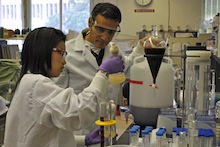 Samir K. Khanal (MBBE, pictured, left) has been selected to participate in a 2-day workshop organized by the Center for Sustainable Engineering (CSE) at Syracuse University in May 2011. The aim of the workshop is to train faculty members to teach sustainable engineering courses to undergraduate engineering students at US universities. Only 30 participants were selected competitively across the US. Samir will teach BE 450: Sustainable Engineering in the Biological Engineering Program at CTAHR starting in 2012. Samir K. Khanal (MBBE, pictured, left) has been selected to participate in a 2-day workshop organized by the Center for Sustainable Engineering (CSE) at Syracuse University in May 2011. The aim of the workshop is to train faculty members to teach sustainable engineering courses to undergraduate engineering students at US universities. Only 30 participants were selected competitively across the US. Samir will teach BE 450: Sustainable Engineering in the Biological Engineering Program at CTAHR starting in 2012.
|
Hands Across Oceania
3/15/2011 Source: Office of Communication Services, CTAHR 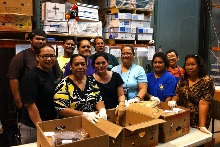 The Hawaii Expanded Food and Nutrition Education Program (EFNEP) recently hosted nine of their colleagues from the U.S-affiliated Pacific Islands for a workshop. The goal of the workshop was to create a training course for EFNEP Program Assistants to help them become “culturally competent,” to better serve their Pacific Islander clients. It was also an opportunity for the participants to see programs in Hawai‘i that serve EFNEP clients (families with children and limited resources). The participants spent a morning volunteering at the Hawaii Foodbank, sorting food donations. The Hawaii Expanded Food and Nutrition Education Program (EFNEP) recently hosted nine of their colleagues from the U.S-affiliated Pacific Islands for a workshop. The goal of the workshop was to create a training course for EFNEP Program Assistants to help them become “culturally competent,” to better serve their Pacific Islander clients. It was also an opportunity for the participants to see programs in Hawai‘i that serve EFNEP clients (families with children and limited resources). The participants spent a morning volunteering at the Hawaii Foodbank, sorting food donations.
|
$7 Million to Begin the Year Right
3/15/2011 Source: Office of Communication Services, CTAHR 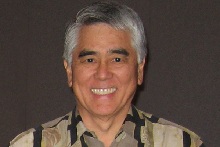 CTAHR faculty started out this year strong, grant-wise, receiving $7,060,977 in extramural funding from Jan 1 to Feb. 28. Former Dean Andy Hashimoto (MBBE, pictured) led the way, with a $6 million award from the federal Department of Energy for “Development of High-Yield Tropical Feedstocks for Bioenergy.” Other MBBE faculty, JP Bingham, PingSun Leung, and David Christopher, received $771,035; PEPS faculty Janice Uchida, Koon-Hui Wang, Jari Sugano, and Anne Alvarez received $262,995; Associate Dean Carl Evensen received $207,026; TPSS faculty member Joe DeFrank received $11,300; and FCS faculty member Loriena Ann Yancura received $3,647. Grant details for both the 2010 and 2011 calendar years are posted on the Research Office Web page Extramural Grant Projects. Congratulations to all these productive and successful CTAHR investigators! CTAHR faculty started out this year strong, grant-wise, receiving $7,060,977 in extramural funding from Jan 1 to Feb. 28. Former Dean Andy Hashimoto (MBBE, pictured) led the way, with a $6 million award from the federal Department of Energy for “Development of High-Yield Tropical Feedstocks for Bioenergy.” Other MBBE faculty, JP Bingham, PingSun Leung, and David Christopher, received $771,035; PEPS faculty Janice Uchida, Koon-Hui Wang, Jari Sugano, and Anne Alvarez received $262,995; Associate Dean Carl Evensen received $207,026; TPSS faculty member Joe DeFrank received $11,300; and FCS faculty member Loriena Ann Yancura received $3,647. Grant details for both the 2010 and 2011 calendar years are posted on the Research Office Web page Extramural Grant Projects. Congratulations to all these productive and successful CTAHR investigators!
|
No Fair
3/15/2011 Source: Office of Communication Services, CTAHR  Because the Hawaii Farm Bureau Federation is canceling the Hawaii State Farm Fair this year due to lack of venue, the local 4-H participants who depend on the Fair to show their animals are likewise displaced. Gary Heusel (4-H) was interviewed on KHON News recently about the dilemma in which 4-H has been placed: The organization is still going ahead with its livestock show and auction, where the animals raised by 4-H participants are sold, but it will have to find a venue, figure out logistics and infrastructure, and pay for it all themselves. Gary pointed out that even ifthey get all of that settled, there will probably be a smaller turnout than usual, since the site won’t be as convenient—it will probably be in a rural area of O‘ahu—and the rest of the usual Fair won’t be drawing visitors to the site. Because the Hawaii Farm Bureau Federation is canceling the Hawaii State Farm Fair this year due to lack of venue, the local 4-H participants who depend on the Fair to show their animals are likewise displaced. Gary Heusel (4-H) was interviewed on KHON News recently about the dilemma in which 4-H has been placed: The organization is still going ahead with its livestock show and auction, where the animals raised by 4-H participants are sold, but it will have to find a venue, figure out logistics and infrastructure, and pay for it all themselves. Gary pointed out that even ifthey get all of that settled, there will probably be a smaller turnout than usual, since the site won’t be as convenient—it will probably be in a rural area of O‘ahu—and the rest of the usual Fair won’t be drawing visitors to the site.
|
Five Fire Trucks in Search of a Fire
3/15/2011 Source: Office of Communication Services, CTAHR  On Friday, Mar. 11, following an emergency call from the Agricultural Science building, the building was evacuated and five fire trucks responded to a potential chemical fire. Fortunately, no one was harmed and no damage to the building was reported. The CTAHR administration is gathering additional information on the situation and will be working with departments to prevent such incidents from occurring in the future. On Friday, Mar. 11, following an emergency call from the Agricultural Science building, the building was evacuated and five fire trucks responded to a potential chemical fire. Fortunately, no one was harmed and no damage to the building was reported. The CTAHR administration is gathering additional information on the situation and will be working with departments to prevent such incidents from occurring in the future.
|
Tea and Sympathy
3/7/2011 Source: Office of Communication Services, CTAHR 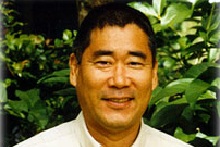 Recently retired Dwight Sato (PEPS-Extension, pictured) was recently given an affectionate tribute in a Hawaii Tribune letter to the editor for his “tireless” work educating the nascent tea-growing community in Hawaii between 2003 and 2010. The writer praised his strong commitment to excellence and education: “Through him, our tea community received a wealth of information important in creating a strong foundation for Hawaii tea agriculture.” Another member of the CTAHR ‘ohana, Kelly Asai, made sure the news got into the right hands (that would be ours here at CTAHR Notes), adding his own encomium: “I had the pleasure of working with Dwight Sato…I admired his down to earth professionalism.” Dwight may no longer be at CTAHR, but his influence certainly remains. Recently retired Dwight Sato (PEPS-Extension, pictured) was recently given an affectionate tribute in a Hawaii Tribune letter to the editor for his “tireless” work educating the nascent tea-growing community in Hawaii between 2003 and 2010. The writer praised his strong commitment to excellence and education: “Through him, our tea community received a wealth of information important in creating a strong foundation for Hawaii tea agriculture.” Another member of the CTAHR ‘ohana, Kelly Asai, made sure the news got into the right hands (that would be ours here at CTAHR Notes), adding his own encomium: “I had the pleasure of working with Dwight Sato…I admired his down to earth professionalism.” Dwight may no longer be at CTAHR, but his influence certainly remains.
|
Shooting Star
3/7/2011 Source: Office of Communication Services, CTAHR Keisha Kanekoa (FCS undergraduate), point guard for the Rainbow Wahine, was honored at the Stan Sheriff Center during Senior Night ceremonies for her four years of great basketball playing for UH. And she was celebrated in the Star-Advertiser not only for her undeniable success on the court but also for the way she has become someone to look up to for her hometown of Honoka‘a. UH coach Dana Takahara-Dias described her as “a local girl done good. A role model for many local kids,” and someone who “epitomizes Wahine basketball.” What makes it even more special is that Keisha is the first member of her family who will get a college degree—majoring in FAMR.
|
Spring Event
3/7/2011 Source: Office of Communication Services, CTAHR 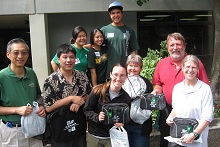 On Friday, Feb. 11, the college held its annual Spring Event. Due to ongoing renovations in Gilmore Hall, this year’s event was held in Sherman Courtyard. Over 150 students, faculty, staff and friends attended the event, which featured a grilled lunch of hamburgers, veggie burgers, and hot dogs, as well as a charades competition. Three teams competed in this year’s charades event, and the members of HNFAS (pictured) were named this year’s charades champions. Over $550 in donations was raised for the Allene Chun Scholarship Fund. Mahalo to Charlie Nelson (MBBE), Ryan Kurasaki (MBBE), Chef Mark Segobiano (HNFAS), and his students in the FSHN class for preparing the lunch. A big thank you also goes to Ray Uchida (O'ahu County administrator) and his staff for setting up and breaking down the tents used to cover the food in Sherman Courtyard. Thank you also to NREM, which offered office and kitchen space to help with the event preparations. Thank you to everyone who took part in the fun and for your generous donations. See you all at our next event! On Friday, Feb. 11, the college held its annual Spring Event. Due to ongoing renovations in Gilmore Hall, this year’s event was held in Sherman Courtyard. Over 150 students, faculty, staff and friends attended the event, which featured a grilled lunch of hamburgers, veggie burgers, and hot dogs, as well as a charades competition. Three teams competed in this year’s charades event, and the members of HNFAS (pictured) were named this year’s charades champions. Over $550 in donations was raised for the Allene Chun Scholarship Fund. Mahalo to Charlie Nelson (MBBE), Ryan Kurasaki (MBBE), Chef Mark Segobiano (HNFAS), and his students in the FSHN class for preparing the lunch. A big thank you also goes to Ray Uchida (O'ahu County administrator) and his staff for setting up and breaking down the tents used to cover the food in Sherman Courtyard. Thank you also to NREM, which offered office and kitchen space to help with the event preparations. Thank you to everyone who took part in the fun and for your generous donations. See you all at our next event!
|
Be Aware!
3/7/2011 Source: Office of Communication Services, CTAHR 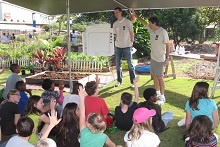 Andrew Kaufman (TPSS, pictured) was one of 17 presenters and 17 exhibitors at this year’s O‘ahu Agriculture and Environmental Awareness Day. A swarm of more than 600 elementary students and their teachers descended upon CTAHR’s 30-acre Urban Garden Center in Pearl City on February 17. The annual event is organized by the Office of Academic and Student Affairs Office and hosted by the O‘ahu Cooperative Extension Service. A record number of students and teachers from Hale Kula, Iliahi, Wheeler, Palisades, Pearl City Highlands, and Punahou elementary schools were in attendance. The event serves a two-fold purpose: to create a greater awareness and understanding of agriculture and the environment among today’s students, teachers, and the community, and to introduce students to career opportunities in agriculture and the environmental studies on O‘ahu and throughout the state. Andrew Kaufman (TPSS, pictured) was one of 17 presenters and 17 exhibitors at this year’s O‘ahu Agriculture and Environmental Awareness Day. A swarm of more than 600 elementary students and their teachers descended upon CTAHR’s 30-acre Urban Garden Center in Pearl City on February 17. The annual event is organized by the Office of Academic and Student Affairs Office and hosted by the O‘ahu Cooperative Extension Service. A record number of students and teachers from Hale Kula, Iliahi, Wheeler, Palisades, Pearl City Highlands, and Punahou elementary schools were in attendance. The event serves a two-fold purpose: to create a greater awareness and understanding of agriculture and the environment among today’s students, teachers, and the community, and to introduce students to career opportunities in agriculture and the environmental studies on O‘ahu and throughout the state.
|
The Elect and the Applicant
3/7/2011 Source: Office of Communication Services, CTAHR  The Hawaii Association of County Agricultural Agents (HACAA) members have elected the following HACAA officers for 2011-2013: The Hawaii Association of County Agricultural Agents (HACAA) members have elected the following HACAA officers for 2011-2013:
- President: Norman Nagata (TPSS-Extension, pictured)
- Vice President: Andrew Kawabata (TPSS-Extension)
- Secretary: Jayme Grzebik (O‘ahu County Extension)
- Treasurer: Ty McDonald (TPSS-Extension)
- Past President: Glenn Teves (TPSS-Moloka‘i Extension)
The NACAA database has been updated with current members, officers, and state committee chairs. You will now be able to apply online for NACAA awards and presentations for the 2011 NACAA PIC/AM. However, you will first need to GET YOUR PASSWORD (if you don’t have one) to enable access to these sensitive areas on the Web site. You can find award and presentation opportunities in the December 2010 issue of The County Agent Journal, or click here. People who have already submitted an application for an award or abstract are encouraged to resubmit it because it may not have gotten to the state committee chair (because the 2011 information was not updated until recently) to review the submittal. Once the state chair approves the submittal, it then goes to the national committee chair and regional vice-chairs as part of its peer-review process; they will send notice of approval to applicants. Remember, the application deadline is Mar. 15, unless stated otherwise.
|
Party Down at the Garden
3/7/2011 Source: Office of Communication Services, CTAHR 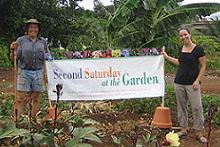 Jayme Grzebik (O'ahu County Extension) has been in the news lately: not only has she been elected to the HACAA as secretary; she’s just published an article in the Star-Advertiser on invasive species and was quoted in Green magazine’s recent article on the O‘ahu Urban Garden in Pearl City. In her discussion of invasive species, Jayme (pictured, with Master Gardener Bob Speer) points out that these plants, animals, insects, and microbes can spell disaster for native species and take years to get rid of—years of hard work and lots of money fighting what might end up being a losing battle. It’s far better just not to introduce them in the first place. To learn about common invasive species, Jayme suggests checking out CTAHR’s publications on them or going to the Urban Garden this Saturday, Mar. 12, for one of their Plant Pono! classes on the subject, held at 9:30 and 11 a.m. Green’s article is also designed to get readers out to the Garden—it’s an enthusiastic paean to the community-mindedness and general helpfulness of the Master Gardeners, Extension agents, and volunteers working there, not to mention the beauty and health of the fruits, vegetables, and ornamentals growing in the various plots. Jayme says workers at the Garden share “local research-based information” that’s also “environmentally sound and sustainable.” So if you haven’t been out to the Garden lately, check it out—there’s a lot to see and learn. Jayme Grzebik (O'ahu County Extension) has been in the news lately: not only has she been elected to the HACAA as secretary; she’s just published an article in the Star-Advertiser on invasive species and was quoted in Green magazine’s recent article on the O‘ahu Urban Garden in Pearl City. In her discussion of invasive species, Jayme (pictured, with Master Gardener Bob Speer) points out that these plants, animals, insects, and microbes can spell disaster for native species and take years to get rid of—years of hard work and lots of money fighting what might end up being a losing battle. It’s far better just not to introduce them in the first place. To learn about common invasive species, Jayme suggests checking out CTAHR’s publications on them or going to the Urban Garden this Saturday, Mar. 12, for one of their Plant Pono! classes on the subject, held at 9:30 and 11 a.m. Green’s article is also designed to get readers out to the Garden—it’s an enthusiastic paean to the community-mindedness and general helpfulness of the Master Gardeners, Extension agents, and volunteers working there, not to mention the beauty and health of the fruits, vegetables, and ornamentals growing in the various plots. Jayme says workers at the Garden share “local research-based information” that’s also “environmentally sound and sustainable.” So if you haven’t been out to the Garden lately, check it out—there’s a lot to see and learn.
|
A Good Excuse to Go Out to Eat
3/1/2011 Source: Office of Communication Services, CTAHR  Richard Ha, a longtime supporter and valuable community partner for CTAHR, has been awarded a 2011 Distinguished Alumni award. Richard, owner of Hamakua Springs Country Farms, is highly respected in the community and the agricultural industry. He is an influential and active advocate on sustainability issues and has incorporated these concerns into his business philosophy. Richard was also inducted in the Shidler College of Business’s Alumni Hall of Honor in 2008, and his farm received the Outstanding Agriculture Operations Award at the 2006 Ag Conference. All these awards are great—but if you really want to find out what Richard’s been doing with his time, drop by one of Alan Wong’s restaurants, which he supplies with produce, and taste his delicious heirloom tomatoes and lettuce. Growing vegetables like these—and sustainably, too—is the real success! Richard Ha, a longtime supporter and valuable community partner for CTAHR, has been awarded a 2011 Distinguished Alumni award. Richard, owner of Hamakua Springs Country Farms, is highly respected in the community and the agricultural industry. He is an influential and active advocate on sustainability issues and has incorporated these concerns into his business philosophy. Richard was also inducted in the Shidler College of Business’s Alumni Hall of Honor in 2008, and his farm received the Outstanding Agriculture Operations Award at the 2006 Ag Conference. All these awards are great—but if you really want to find out what Richard’s been doing with his time, drop by one of Alan Wong’s restaurants, which he supplies with produce, and taste his delicious heirloom tomatoes and lettuce. Growing vegetables like these—and sustainably, too—is the real success!
|
Greening the Grade School
3/1/2011 Source: Office of Communication Services, CTAHR  Noelani Elementary School’s continued partnership with CTAHR’s 4-H and Sustainable and Organic Farm Training (SOFT) programs is blossoming. At a recent trip to the Magoon Labs facility, students prepped the soil and planted vegetables and herbs: lavender, lemongrass, rosemary, sage, and more. Not only do the students get to see the miracle of plants germinating, feel the sun-warmed soil in their hands, and literally eat the fruits of their labors, they’re fulfilling one of the science components of the DOE curriculum! Noelani Elementary School’s continued partnership with CTAHR’s 4-H and Sustainable and Organic Farm Training (SOFT) programs is blossoming. At a recent trip to the Magoon Labs facility, students prepped the soil and planted vegetables and herbs: lavender, lemongrass, rosemary, sage, and more. Not only do the students get to see the miracle of plants germinating, feel the sun-warmed soil in their hands, and literally eat the fruits of their labors, they’re fulfilling one of the science components of the DOE curriculum!
|
Gonna Wash Those Germs Right Offa My Hands
3/1/2011 Source: Office of Communication Services, CTAHR  The Center for Disease Control tells us that the most important thing people can do to lessen the spread of infectious diseases is to wash their hands. The Germ City program, which started as a 5-state education program funded by USDA’s Cooperative State Research, Education, and Extension Service and has now expanded across the US, teaches people to do just that. Lynn Nakamura-Tengan (HNFAS) (lynnnaka@hawaii.edu) coordinates the Hawai‘i program, which supports a statewide team of Extension and health educators, student and adult volunteers, and community agency staff. This Extension and community collaboration offers school-based presentations, outreach at community fairs and festivals, and worksite trainings on hand hygiene for infection control, health, food safety, and emergency preparedness education. The Hawai‘i Germ City Web site, which Lynn also heads, has served as a resource to national and international school and community-based hand hygiene education programs. The Germ City program is well received in schools and community settings, reaching at least 2,000 adults and youth across the state of Hawai‘i annually. The Center for Disease Control tells us that the most important thing people can do to lessen the spread of infectious diseases is to wash their hands. The Germ City program, which started as a 5-state education program funded by USDA’s Cooperative State Research, Education, and Extension Service and has now expanded across the US, teaches people to do just that. Lynn Nakamura-Tengan (HNFAS) (lynnnaka@hawaii.edu) coordinates the Hawai‘i program, which supports a statewide team of Extension and health educators, student and adult volunteers, and community agency staff. This Extension and community collaboration offers school-based presentations, outreach at community fairs and festivals, and worksite trainings on hand hygiene for infection control, health, food safety, and emergency preparedness education. The Hawai‘i Germ City Web site, which Lynn also heads, has served as a resource to national and international school and community-based hand hygiene education programs. The Germ City program is well received in schools and community settings, reaching at least 2,000 adults and youth across the state of Hawai‘i annually.
|
Hearts and Bones
3/1/2011 Source: Office of Communication Services, CTAHR  Corilee Watters (HNFAS) wrote an article entitled “For the Heart” for the Feb. 22 Honolulu Star-Advertiser featuring heart-healthy recipes that showcase the color red. (This isn’t just about aesthetics; the new USDA Dietary Guidelines suggest serving red and orange fruits and vegetables as a strategy to add a healthful variety to your diet.) Corilee teamed up with Chef George Mavrothalssitis, owner of noted Hawai‘i restaurant Chef Mavro, to produce red-themed dishes such as Red Velvet Tomato Soup and Red Cabbage Salad. Corilee also recently had a project, “How to Motivate Parents to Promote Intake of Calcium-Rich Foods Among Early Adolescents,” officially approved by USDA/NIFA, thus moving the focus from hearts to bones. Corilee Watters (HNFAS) wrote an article entitled “For the Heart” for the Feb. 22 Honolulu Star-Advertiser featuring heart-healthy recipes that showcase the color red. (This isn’t just about aesthetics; the new USDA Dietary Guidelines suggest serving red and orange fruits and vegetables as a strategy to add a healthful variety to your diet.) Corilee teamed up with Chef George Mavrothalssitis, owner of noted Hawai‘i restaurant Chef Mavro, to produce red-themed dishes such as Red Velvet Tomato Soup and Red Cabbage Salad. Corilee also recently had a project, “How to Motivate Parents to Promote Intake of Calcium-Rich Foods Among Early Adolescents,” officially approved by USDA/NIFA, thus moving the focus from hearts to bones.
|
Diva of Demographics
3/1/2011 Source: Office of Communication Services, CTAHR  Sarah Yuan (COF) has been in the news recently discussing some of the findings of the 2010 Census. In USA Today she pointed out that nearly a quarter of Hawai‘i residents identify as mixed race—this makes sense, said Sarah, considering the increasing percentage of interracial marriages (the most in the nation) and people’s greater willingness to embrace all the ethnicities in their heritage. KITV News was more interested in talking with her about the disproportionate growth in some areas’ populations, which may require some adjustments to make sure each district is getting appropriate representation. “Politically each district should have a similar number of people [per] representative,” Sarah confirmed. Sarah Yuan (COF) has been in the news recently discussing some of the findings of the 2010 Census. In USA Today she pointed out that nearly a quarter of Hawai‘i residents identify as mixed race—this makes sense, said Sarah, considering the increasing percentage of interracial marriages (the most in the nation) and people’s greater willingness to embrace all the ethnicities in their heritage. KITV News was more interested in talking with her about the disproportionate growth in some areas’ populations, which may require some adjustments to make sure each district is getting appropriate representation. “Politically each district should have a similar number of people [per] representative,” Sarah confirmed.
|
More Spore Wars
3/1/2011 Source: Office of Communication Services, CTAHR 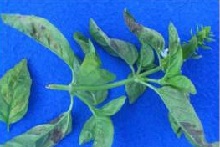 Janice Uchida (PEPS) was recently interviewed on Hawaii News Now concerning basil downy mildew, the damaging pathogen that was first discovered in Wai‘anae last month and has since spread to Diamond Head, Kahuku, and Kunia. Janice, who heads CTAHR’s Spore Warriors against the BDM crisis, emphasized the danger that the pathogen will mutate and become resistant to fungicides being used to combat it. It’s important to prune back the plants vigorously, not just take off the tops, before treating with fungicide, she explained. Janice Uchida (PEPS) was recently interviewed on Hawaii News Now concerning basil downy mildew, the damaging pathogen that was first discovered in Wai‘anae last month and has since spread to Diamond Head, Kahuku, and Kunia. Janice, who heads CTAHR’s Spore Warriors against the BDM crisis, emphasized the danger that the pathogen will mutate and become resistant to fungicides being used to combat it. It’s important to prune back the plants vigorously, not just take off the tops, before treating with fungicide, she explained.
|
Mite-y Weapon
3/1/2011 Source: Office of Communication Services, CTAHR 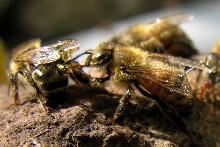 Hawai‘i beekeepers now have a valuable weapon in the fight against the varroa mite (Varroa destructor), and CTAHR’s Honeybee Project, headed by Mark Wright (PEPS), was instrumental in getting it in their hands. The Hawaii Department of Agriculture has just licensed a formic acid-based miticide, Mite-Away Quick Strips,TM for use in honeybee hives. This miticide kills mites without harming honeybees and has been used effectively in Canada, but its use in Hawai‘i was initially in question. CTAHR’s bee research team drove the initial data collection through a serious of rigorous trials conducted in collaboration with the manufacturer of the formic acid product and collaborated with the HDOA in providing data for a local needs label for the product. The quick approval of the local needs registration was primarily due to the excellent results the obtained by the research group, in particular Ethel Villalobos (PEPS), Tyler Ito (PEPS), and Scott Nikaido (PEPS, graduate student). Hawai‘i’s beekeepers are leading the way at a national level in the use of non-synthetic chemicals to control the destructive mite, which was first discovered on O‘ahu in 2007 and has since spread to the Big Island. Varroa mites suck the blood of honeybees and their larvae and pupae, which weakens them and causes deformities in emerging bees. This not only cuts down on honey production but also lessens the ability of the bees to pollinate the many tropical crops that depend on them and on which we in the Islands in turn depend. Hawai‘i beekeepers now have a valuable weapon in the fight against the varroa mite (Varroa destructor), and CTAHR’s Honeybee Project, headed by Mark Wright (PEPS), was instrumental in getting it in their hands. The Hawaii Department of Agriculture has just licensed a formic acid-based miticide, Mite-Away Quick Strips,TM for use in honeybee hives. This miticide kills mites without harming honeybees and has been used effectively in Canada, but its use in Hawai‘i was initially in question. CTAHR’s bee research team drove the initial data collection through a serious of rigorous trials conducted in collaboration with the manufacturer of the formic acid product and collaborated with the HDOA in providing data for a local needs label for the product. The quick approval of the local needs registration was primarily due to the excellent results the obtained by the research group, in particular Ethel Villalobos (PEPS), Tyler Ito (PEPS), and Scott Nikaido (PEPS, graduate student). Hawai‘i’s beekeepers are leading the way at a national level in the use of non-synthetic chemicals to control the destructive mite, which was first discovered on O‘ahu in 2007 and has since spread to the Big Island. Varroa mites suck the blood of honeybees and their larvae and pupae, which weakens them and causes deformities in emerging bees. This not only cuts down on honey production but also lessens the ability of the bees to pollinate the many tropical crops that depend on them and on which we in the Islands in turn depend.
|
February
Supplemental Funding Supplement
2/22/2011 Source: Office of Communication Services, CTAHR  We apologize for inadvertently leaving out the names of several researchers who were awarded supplemental funding. Here they are, with their project titles: We apologize for inadvertently leaving out the names of several researchers who were awarded supplemental funding. Here they are, with their project titles:
- Ashley Stokes (HNFAS): “Animal Health in Hawaii’s Agriculture Industries: Hawaii Beef Producer Animal Health and Welfare Certification Training and Impact Evaluation”
- Mary Martini (FCS) and Gary Heusel (FCS-4H): “Effects of an Integrated 4-H/FCS Family Club Program on Family Collaboration and Positive Youth Development in At-Risk Families”
- JB Friday (NREM): “Professional and Staff Development and Training in Forestry Skills (RREA): Extension Approved for 2010-2011”
- Daniel Rubinoff (PEPS, pictured): “A Reference and Research Collection of Native and Invasive Insect Species in Hawaii”
|
A Sweetheart of a Flower
2/22/2011 Source: Office of Communication Services, CTAHR 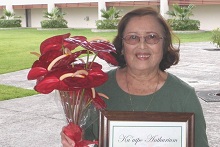 The Hawaii Tribune recently reported on the naming of a new CTAHR-developed anthurium. Back in October, when Komohana Research and Extension Center (KREC) in Hilo held its open house, complete with displays and demonstrations, the CTAHR anthurium breeding program hosted a contest to name a new anthurium cultivar. The selection, designated UH658, was developed by Joanne Lichty, Tessie Amore, and Russell Nagata (all TPSS) and arises from award-winning parentage, with a dark red flower spathe and a red-orange spadix (nose) that turns white with maturity. The plant yields 6 flowers per year, and the cut flower has an outstanding vase life of over 40 days. This attractive anthurium elicited over a hundred entries, but in celebration of Valentine’s Day, the name ‘Ku‘uipo,’ “My Sweetheart,” was chosen. Hilo resident Myrtle Zane (pictured) received a bouquet of ‘Ku‘uipo’ flowers and a potted ‘Ku‘uipo’ anthurium plant for proposing the winning name. The Hawaii Tribune recently reported on the naming of a new CTAHR-developed anthurium. Back in October, when Komohana Research and Extension Center (KREC) in Hilo held its open house, complete with displays and demonstrations, the CTAHR anthurium breeding program hosted a contest to name a new anthurium cultivar. The selection, designated UH658, was developed by Joanne Lichty, Tessie Amore, and Russell Nagata (all TPSS) and arises from award-winning parentage, with a dark red flower spathe and a red-orange spadix (nose) that turns white with maturity. The plant yields 6 flowers per year, and the cut flower has an outstanding vase life of over 40 days. This attractive anthurium elicited over a hundred entries, but in celebration of Valentine’s Day, the name ‘Ku‘uipo,’ “My Sweetheart,” was chosen. Hilo resident Myrtle Zane (pictured) received a bouquet of ‘Ku‘uipo’ flowers and a potted ‘Ku‘uipo’ anthurium plant for proposing the winning name.
|
High School Ag Program Taking Root
2/22/2011 Source: Office of Communication Services, CTAHR 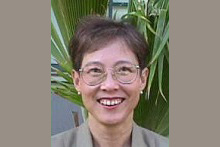 Donna Ching (Extension, pictured), Ag Leadership Program (ALP) co-director, was interviewed in Maui News along with ALP alumna Lani Weigert. Lani and her daughter Pomai have launched a pilot agriculture program at Maui High School to cultivate the business of agriculture. ALP trains leaders in Hawai‘i’s agriculture, rural community, and natural resource management sectors in hopes of creating strong ties between urban and rural sectors and strengthening the agricultural community. Donna Ching (Extension, pictured), Ag Leadership Program (ALP) co-director, was interviewed in Maui News along with ALP alumna Lani Weigert. Lani and her daughter Pomai have launched a pilot agriculture program at Maui High School to cultivate the business of agriculture. ALP trains leaders in Hawai‘i’s agriculture, rural community, and natural resource management sectors in hopes of creating strong ties between urban and rural sectors and strengthening the agricultural community.
|
Slowing the Brain Drain
2/22/2011 Source: Office of Communication Services, CTAHR 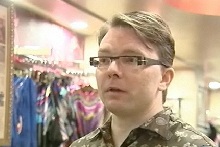 Andy Reilly (pictured) and Abby Cristi (both FCS) were recently interviewed by KHON2 anchor Olena Heu about the importance of internship programs. Abby and Andy have worked with boutique owner Valerie Ragaza-Miao of the Valerie Joseph Boutique to find and place qualified students in an innovative internship program, PINC, in an effort to keep educated and talented youth in Hawai‘i after graduation. Former APDM student Janette McKeone, the first to enroll in PINC when she was at UHM, helped to organize and produce a charity fundraiser during her internship; since her graduation last fall, she has been hired as store manager for Valerie Joseph. Andy Reilly (pictured) and Abby Cristi (both FCS) were recently interviewed by KHON2 anchor Olena Heu about the importance of internship programs. Abby and Andy have worked with boutique owner Valerie Ragaza-Miao of the Valerie Joseph Boutique to find and place qualified students in an innovative internship program, PINC, in an effort to keep educated and talented youth in Hawai‘i after graduation. Former APDM student Janette McKeone, the first to enroll in PINC when she was at UHM, helped to organize and produce a charity fundraiser during her internship; since her graduation last fall, she has been hired as store manager for Valerie Joseph.
|
Cherry!
2/22/2011 Source: Office of Communication Services, CTAHR 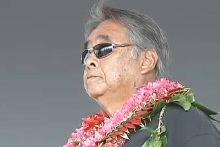 Milton Yamasaki (ret. manager of Mealani, pictured) and the Mealani Reseach Station were honored by the Big Island’s Mayor Billy Kenoi at the 18th Annual Cherry Blossom Heritage Festival on Feb. 7. Kenoi praised Milton’s “dedication to the community,” calling him “groundbreaking, innovative, and creative,” and gave a further tribute to the people of the local agricultural community “who work hard every day to feed us, to provide for us.” Milton Yamasaki (ret. manager of Mealani, pictured) and the Mealani Reseach Station were honored by the Big Island’s Mayor Billy Kenoi at the 18th Annual Cherry Blossom Heritage Festival on Feb. 7. Kenoi praised Milton’s “dedication to the community,” calling him “groundbreaking, innovative, and creative,” and gave a further tribute to the people of the local agricultural community “who work hard every day to feed us, to provide for us.”
|
Good and Good for You
2/14/2011 Source: Office of Communication Services, CTAHR Carissa Holley and Kimberly Kanechika (CES-HNFAS) recently appeared on Hawaii News Now's Sunrise Show to talk about the new Dietary Guidelines for Americans recently released by the Department of Health and Human Services and the Department of Agriculture. The nutrition educators shared healthy recipes that utilize many fresh, locally grown ingredients, including sweet potato salad (never heard of such a thing, but it sounds mighty tasty) and fresh corn and black bean salsa (yum!).
|
“You Guys Are Awesome!”
2/14/2011 Source: Office of Communication Services, CTAHR 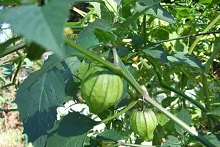 So says a satisfied member of the community in a recent email. He had some questions about tomatillos: Is it possible to grow them in Hawai‘i? Are they invasive if they get going? If yes to the first and no to the second, what are the best methods of propagation? Carl Evensen (NREM) responded promptly: They grow well here, being related to the native species poha. The seed can be saved by crushing the fruit, then fermenting the seed and pulp for a few days, then washing and drying the seed. After a few more tips, Carl passed the baton to Steven Chiang, who offered additional advice. The questioner, whose wife uses a large volume of tomatillos in her catering business and has been buying them imported from California, wrote back, “Thank you so much for your detailed and thoughtful response…I guess my next assignment is planting my yard in tomatillos!” And isn’t another patch of green, another step towards Island self-sufficiency, the best tribute of all? So says a satisfied member of the community in a recent email. He had some questions about tomatillos: Is it possible to grow them in Hawai‘i? Are they invasive if they get going? If yes to the first and no to the second, what are the best methods of propagation? Carl Evensen (NREM) responded promptly: They grow well here, being related to the native species poha. The seed can be saved by crushing the fruit, then fermenting the seed and pulp for a few days, then washing and drying the seed. After a few more tips, Carl passed the baton to Steven Chiang, who offered additional advice. The questioner, whose wife uses a large volume of tomatillos in her catering business and has been buying them imported from California, wrote back, “Thank you so much for your detailed and thoughtful response…I guess my next assignment is planting my yard in tomatillos!” And isn’t another patch of green, another step towards Island self-sufficiency, the best tribute of all?
|
Supplemental Funds Awarded
2/14/2011 Source: Office of Communication Services, CTAHR 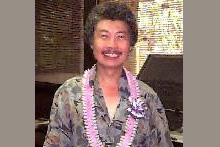 Twenty-six investigators received funding through CTAHR’s Research/Extension Supplemental Funding RFP. Each of the investigators has an active Hatch or Integrated Research/Extension project, a multi-state Hatch or Extension project, or an Extension Plan of Work; and funding is being provided for up to two years to supplement or expand these projects. Clearly, CTAHR faculty have great ideas that deserve funding! In recognition of this, approximately $950,000 is being committed by the college administration to support these research and extension efforts over the next two years. The projects ranged from the reduction of arsenic in contaminated Hawaiian soils (Nguyen Hue, TPSS, pictured) through the study of carbon cycling in forests (Creighton Litton, NREM, and JB Friday, NREM) to the establishment of nutritional standards for minimum-cost diets (Christopher Edmonds, COF). Twenty-six investigators received funding through CTAHR’s Research/Extension Supplemental Funding RFP. Each of the investigators has an active Hatch or Integrated Research/Extension project, a multi-state Hatch or Extension project, or an Extension Plan of Work; and funding is being provided for up to two years to supplement or expand these projects. Clearly, CTAHR faculty have great ideas that deserve funding! In recognition of this, approximately $950,000 is being committed by the college administration to support these research and extension efforts over the next two years. The projects ranged from the reduction of arsenic in contaminated Hawaiian soils (Nguyen Hue, TPSS, pictured) through the study of carbon cycling in forests (Creighton Litton, NREM, and JB Friday, NREM) to the establishment of nutritional standards for minimum-cost diets (Christopher Edmonds, COF).
The other successful investigators were
- Michael Kawate (PEPS)
- Samir Kumar Khanal (MBBE) and Clyde Tamaru (MBBE)
- John Hu (PEPS), Wayne Both (PEPS), Scot Nelson (PEPS), and Robin Shimabuku (PEPS)
- Robert Paull (TPSS) and Nancy Jung Chen (TPSS)
- Alberto Bressan (PEPS)
- Jonathan Deenik (TPSS), Gregory Bruland (NREM), Linda Cox (NREM), and Roy Yamakawa (TPSS)
- Ania Wieczorek (TPSS)
- Russell Messing (PEPS)
- Lynn Nakamura-Tengan (HNFAS), James Hollyer (PEPS), and Luisa Castro (NREM)
- Mark Wright (PEPS)
- Soojin Jun (HNFAS) and Yong Li (HNFAS)
- Anne Alvarez (PEPS)
- Tomoaki Miura (NREM)
- Jayme Grzebik (TPSS)
- Richard Manshardt (TPSS) and Scot Nelson (PEPS)
- Loren Gautz (MBBE) and H.C. Bittenbender (TPSS)
- H.C. Bittenbender (TPSS)
- Arnold Hara (PEPS)
- Daniel Jenkins (MBBE) and Anne Alavarez (PEPS)
- Ashley Stokes (HNFAS
|
Gilmore Glorification
2/14/2011 Source: Office of Communication Services, CTAHR As of Feb. 10, the re-roofing
of Greenhouses #1 and #2 was completed. Displaced plants can be returned to
Greenhouse #2, but Greenhouse #1 has damaged floor pavers that will need to be
repaired before plants can be returned there. Greenhouse #3 began its
renovation for elastomeric coating of its aluminum frame on Friday, Feb. 11. If
any pathogenic plants remain in Greenhouse #3, they are to be removed and
relocated.
Also as of Thursday, Feb. 10,
the A/C repairs were completed on the ground floor, Area 1-3, including Gilmore
107 (MBBE's invertebrate & fish lab), 108, 109 110, 111 (PingSun Leung’s
group), 111A, 111B, and 112 (ADAP). The target completion date is Feb. 14
for the second floor, Area 2-2, including Gilmore 201 (Dean’s office), 202
(Dean’s secretaries open office), 202A (Special Grants and Contracts), 202B
(Associate Dean of Research’s office), 202C, 202D, 202E, 210, 210A and 210B
(Office of Academic Affairs), and 211 and 211A (Associate Dean for Academic
Affairs’ office). On the third floor, Area 3-1, A/C renovations began Feb. 11
at 5:00 p.m. Area 3-1, including room 301, the restrooms and utility corridors,
307, 307A & B, 309 (the former darkroom), and the plant growth room, will
be inaccessible until the completion target date of Feb. 21.
|
Slow But Deadly
2/14/2011 Source: Office of Communication Services, CTAHR 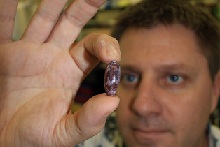 If you missed reading about CTAHR’s association with killer snails a year ago in CTAHR Research News Jan. 2010, you’ll get a chance to fill in that gap in your knowledge when PBS premiers the hit new series Venom: Nature’s Killer on Nova on Feb. 23 at 9:00. Jon-Paul Bingham (MBBE, pictured) will be featured discussing the deadly cone snail, a mollusk that uses a sort of natural hypodermic needle to deliver its toxins. It can kill fish, worms, and other sea creatures…as well as whatever hapless humans get in their way (to be fair, there have been only 15 known human fatalities, but still...). The upside of this snail’s potent poison is that by harnessing its “phyla-specific” killing power, it’s possible to derive pesticides that will target such pests as the Golden Apple snail, known for ravaging taro, while leaving other species unharmed. Jon-Paul’s student Jocelyn Chun (MS, MBBE) was quoted in CRN as saying that in using one kind of snail to eliminate another, “We’re fighting fire with fire.” Surprisingly, the toxin can also be manipulated to create powerful painkilling medications for humans—1,000 times stronger than morphine. Another of Jon-Paul’s students, Zachary Bergeron (PhD, MBBE), explained that the drug can offer relief from the pain of nerve damage and cancer, among others: “We have only touched the tip of the iceberg.” Such diametrically opposed metaphors seem appropriate referring to such a contradictory creature. If you missed reading about CTAHR’s association with killer snails a year ago in CTAHR Research News Jan. 2010, you’ll get a chance to fill in that gap in your knowledge when PBS premiers the hit new series Venom: Nature’s Killer on Nova on Feb. 23 at 9:00. Jon-Paul Bingham (MBBE, pictured) will be featured discussing the deadly cone snail, a mollusk that uses a sort of natural hypodermic needle to deliver its toxins. It can kill fish, worms, and other sea creatures…as well as whatever hapless humans get in their way (to be fair, there have been only 15 known human fatalities, but still...). The upside of this snail’s potent poison is that by harnessing its “phyla-specific” killing power, it’s possible to derive pesticides that will target such pests as the Golden Apple snail, known for ravaging taro, while leaving other species unharmed. Jon-Paul’s student Jocelyn Chun (MS, MBBE) was quoted in CRN as saying that in using one kind of snail to eliminate another, “We’re fighting fire with fire.” Surprisingly, the toxin can also be manipulated to create powerful painkilling medications for humans—1,000 times stronger than morphine. Another of Jon-Paul’s students, Zachary Bergeron (PhD, MBBE), explained that the drug can offer relief from the pain of nerve damage and cancer, among others: “We have only touched the tip of the iceberg.” Such diametrically opposed metaphors seem appropriate referring to such a contradictory creature.
|
Longtime Service and the Maintenance of Greatness
2/14/2011 Source: Office of Communication Services, CTAHR 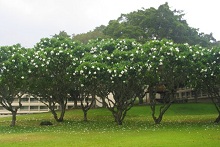 President Greenwood has announced that nominations are open for 2 additional awards. All honorees will be recognized at the university's annual awards ceremony and will receive monetary awards:
The 2011 Willard Wilson Distinguished Service Award, established in 1969 in honor of retiring Board Secretary Willard Wilson, recognizes an employee who has demonstrated exemplary service to the university for at least 20 years. Write a letter explaining how the nominee meets the award criteria and send, with any supporting documentation, to The Willard Wilson Award Committee, c/o David Lonborg, Office of the President, Bachman 202. Interesting fact: CTAHR's very own Wayne Nishijima (2006) and Annette Chang (2004) are past recipients of this award.
The 2011 President’s Award for Excellence in Buildings and Grounds Maintenance recognizes an individual who has exhibited sustained superior performance in a maintenance, landscaping, custodial, shop, or trucking position. The nomination form and supporting material can be submitted by fax (956-5286) or sent to David Lonborg. You can also call Jeri Burke at 956-8207 for more information regarding either of these awards. The deadline for both nominations is Feb. 28, so start finding out who’s in charge of that gorgeous leafscape out your window.
|
Don't Be Left Out Standing...
2/14/2011 Source: Office of Communication Services, CTAHR ...Nominate the outstanding! Remember, the deadline to submit nominations for the Chancellor’s Award for Outstanding Service for Buildings and Grounds, Civil Service, and APT employees is February 28. Eligibility requirements, submission form, copy of the February 1 memo sent out via email, and other information may be found here.
|
Self-Sufficiency—with a Little Help
2/7/2011 Source: Office of Communication Services, CTAHR  Brian Turano (TPSS) is the PI on one of only a handful of teams from throughout UHM to be invited to submit a full write-up on his team’s proposed project to further Hawai‘i’s sustainability. The project, “Sustainable Use of Natural Resources for Food, Water, and Bioenergy Production in the Hawaiian Islands," also includes co-investigators from NREM and TPSS. We alerted you, back in December, to the $1M UHM Sustainability Initiative (“A Million Says You Can Make the Islands a Better Place to Live”). Fifteen teams of visionaries sent in proposals, of which seven are now being invited to expand on their ideas, and almost all of those teams include at least one CTAHR member—from TPSS, NREM, and MBBE. The projects look at climate change, renewable energy, coastline environmental management, soil sustainability, and more—it seems fair to say that any one of them could contribute significantly to Hawai‘i’s continued bounty, beauty, and self-sufficiency. The deadline for submission of the full proposals is Mar. 18, and the winner will be announced on Earth Day, Apr. 22. Brian Turano (TPSS) is the PI on one of only a handful of teams from throughout UHM to be invited to submit a full write-up on his team’s proposed project to further Hawai‘i’s sustainability. The project, “Sustainable Use of Natural Resources for Food, Water, and Bioenergy Production in the Hawaiian Islands," also includes co-investigators from NREM and TPSS. We alerted you, back in December, to the $1M UHM Sustainability Initiative (“A Million Says You Can Make the Islands a Better Place to Live”). Fifteen teams of visionaries sent in proposals, of which seven are now being invited to expand on their ideas, and almost all of those teams include at least one CTAHR member—from TPSS, NREM, and MBBE. The projects look at climate change, renewable energy, coastline environmental management, soil sustainability, and more—it seems fair to say that any one of them could contribute significantly to Hawai‘i’s continued bounty, beauty, and self-sufficiency. The deadline for submission of the full proposals is Mar. 18, and the winner will be announced on Earth Day, Apr. 22.
|
Spore Warriors
2/7/2011 Source: Office of Communication Services, CTAHR 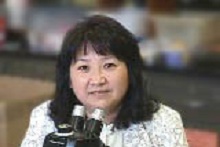 The newly discovered basil downy mildew (BDM) blight showed what CTAHR is made of. The pathogen was brought to the attention of Jari Sugano (TPSS) and Jim Hollyer (PEPS) on the evening of Thursday, Jan. 27, and identified by Brian Bushe (research support, Hawai‘i County) and confirmed by Janice Uchida (PEPS, pictured) on Friday. The Department of Agriculture was notified and a unified CTAHR-DOA approach to respond to the emergency was developed. Researchers and staff, under the direction of team leader Janice Uchida, worked over the weekend to produce, by Monday, a fact sheet to be distributed to farmers and local agencies and a press release to send out to local media. Dean Sylvia Yuen acknowledged the faculty and staff who dealt so quickly and effectively with the situation: “I’m proud of how our BDM SWAT team responded to the emergency. It was a magnificent display of our effectiveness and the important role we play in the state.”Other team members who helped with the quick response include Desmond Ogata, Mike Kawate, Miles Hakoda, and Frederika Bain. Here is a link to a Star-Advertiser article about the situation. The newly discovered basil downy mildew (BDM) blight showed what CTAHR is made of. The pathogen was brought to the attention of Jari Sugano (TPSS) and Jim Hollyer (PEPS) on the evening of Thursday, Jan. 27, and identified by Brian Bushe (research support, Hawai‘i County) and confirmed by Janice Uchida (PEPS, pictured) on Friday. The Department of Agriculture was notified and a unified CTAHR-DOA approach to respond to the emergency was developed. Researchers and staff, under the direction of team leader Janice Uchida, worked over the weekend to produce, by Monday, a fact sheet to be distributed to farmers and local agencies and a press release to send out to local media. Dean Sylvia Yuen acknowledged the faculty and staff who dealt so quickly and effectively with the situation: “I’m proud of how our BDM SWAT team responded to the emergency. It was a magnificent display of our effectiveness and the important role we play in the state.”Other team members who helped with the quick response include Desmond Ogata, Mike Kawate, Miles Hakoda, and Frederika Bain. Here is a link to a Star-Advertiser article about the situation.
|
Expert Opinions
2/7/2011 Source: Office of Communication Services, CTAHR  Jim Hollyer (PEPS, pictured) was quoted in a Hawaii Business magazine article on the importance of food safety certification, arguing that getting the certification “is an issue of professionalism and respect for clients.” Jim Hollyer (PEPS, pictured) was quoted in a Hawaii Business magazine article on the importance of food safety certification, arguing that getting the certification “is an issue of professionalism and respect for clients.”
JB Friday (NREM) was consulted for an article on local acacia koa in the Star Advertiser. He discussed some of the reasons koa, which “is endemic to Hawaii and does not grow naturally anywhere else,” can be more desirable than other types of wood, which “do not say ‘Hawaii’ to consumers.”
|
In the News
2/7/2011 Source: Office of Communication Services, CTAHR  CTAHR has been in the media lately—and not just because of the basil downy mildew crisis. Here are a few instances: Sarah Yuan (pictured) and the rest of COF were acknowledged in Hawaii Business magazine’s Hawaii 2011: Our Quality of Life report for their major contributions in gathering statistical data: “This would have been impossible without the energetic help of the Center on the Family at the University of Hawaii-Manoa.... We are especially grateful for the hard work of researcher Sarah Yuan” (3). The report looks at 6 important issues facing Hawai‘i today: the environment, homelessness and housing, crime, the economy, health, and education. Dean Sylvia Yuen recently appeared on KHON TV to discuss the report, saying that while there is no “magic bullet” that will improve everything, research shows that as people get involved and work together to improve the quality of life in their neighborhoods and communities, their own life satisfaction and well-being improve as well. CTAHR has been in the media lately—and not just because of the basil downy mildew crisis. Here are a few instances: Sarah Yuan (pictured) and the rest of COF were acknowledged in Hawaii Business magazine’s Hawaii 2011: Our Quality of Life report for their major contributions in gathering statistical data: “This would have been impossible without the energetic help of the Center on the Family at the University of Hawaii-Manoa.... We are especially grateful for the hard work of researcher Sarah Yuan” (3). The report looks at 6 important issues facing Hawai‘i today: the environment, homelessness and housing, crime, the economy, health, and education. Dean Sylvia Yuen recently appeared on KHON TV to discuss the report, saying that while there is no “magic bullet” that will improve everything, research shows that as people get involved and work together to improve the quality of life in their neighborhoods and communities, their own life satisfaction and well-being improve as well.
|
Good Night, Don't Let the Rose Bugs Bite
2/7/2011 Source: Office of Communication Services, CTAHR Just in time for Valentine’s Day, Jayme Grzebik (extension) and others in the Honolulu Rose Society will be offering free classes on how to care for roses in Hawai‘i at 9:30 and 11 a.m. this Saturday at the Urban Garden Center in Pearl City. Jayme also recently offered advice on growing roses in her Star-Advertiser gardening column, emphasizing the need to properly prepare the soil and choose varieties that thrive in Hawai‘i. She also offered a surprising way to control pests: keeping a light shining near your rose bushes attracts night-feeding rose beetles so that they can’t concentrate on chowing down.
|
Name That Bug
2/1/2011 Source: Office of Communication Services, CTAHR 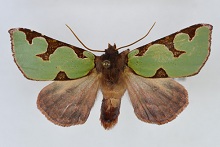 On Jan. 22, UH’s Insect Museum, which is directed by Dan Rubinoff (PEPS) held its annual Insect Sort, where members of the public and the larger UH community are invited to join museum staff to sort through and catalogue the thousands of insects--the good, the bad, and the creepy--that the museum receives annually. This year over 27 members of the UH community, including professors, staff, and grad students from other colleges, were joined by many members of the public, including military, Master Gardeners from Pearl City, and a Hawaii Public Radio reporter. NPR aired a story about the Sort on Jan. 28 on 88.1FM, and another will air Feb. 1 at 6:30 a.m. As well as providing some great public outreach, over 5,000 insect specimens were sorted and added to the museum’s catalogue and database, bringing the total number of curated specimens available for study to over 230,000. At least 10 graduate and undergraduate students were trained in insect identification during the sort. On Jan. 22, UH’s Insect Museum, which is directed by Dan Rubinoff (PEPS) held its annual Insect Sort, where members of the public and the larger UH community are invited to join museum staff to sort through and catalogue the thousands of insects--the good, the bad, and the creepy--that the museum receives annually. This year over 27 members of the UH community, including professors, staff, and grad students from other colleges, were joined by many members of the public, including military, Master Gardeners from Pearl City, and a Hawaii Public Radio reporter. NPR aired a story about the Sort on Jan. 28 on 88.1FM, and another will air Feb. 1 at 6:30 a.m. As well as providing some great public outreach, over 5,000 insect specimens were sorted and added to the museum’s catalogue and database, bringing the total number of curated specimens available for study to over 230,000. At least 10 graduate and undergraduate students were trained in insect identification during the sort.
|
New Efforts to Control the Coffee Berry Borer
2/1/2011 Source: Office of Communication Services, CTAHR 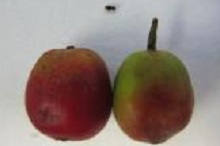 CTAHR, along with the HDOA and the USDA-ARS Pacific Basin Agricultural Research Center, continues to combat the coffee berry borer (CBB), the potentially devastating coffee pest first found in south Kona last September. TPSS is advertising for an Assistant Extension Agent, who will be located in Kona and deal with coffee and orchard crops, and hopes to fill the position by June. CTAHR coffee specialist Skip Bittenbender, with the help of Elsie Burbano (PEPS), organized several well-attended workshops for coffee farmers and processors on managing CBB. He spoke to the Kona Coffee Farmers’ Association at their Coffee Expo on Jan. 28, where he distributed copies of a CTAHR-produced flyer (developed in collaboration with HDOA) describing how to prevent the spread of CBB. Copies of the flyer will also be available from the Kona Cooperative Extension office, from CTAHR’s Office of Communication Services, and from the CTAHR CBB Web site, which will soon also have other information. Entomologists Russell Messing, Mark Wright, and Elsie Burbano (all PEPS) are investigating the life cycle of CBB in Hawai‘i, alternate plant hosts that might help it spread, tools such as vacuums to help farmers clean up infested coffee cherries in their fields, and least-toxic compounds such as neem, which might prevent female CBB from laying eggs. Engineer Loren Gautz (MBBE), is working with USDA entomologists and CTAHR graduates Eric Jang and Peter Follette on using heat, radiation, and fumigation to treat CBB and on traps and lures to monitor its movement. Michael Kawate and Julie Coughlin (both PEPS) are investigating possible pesticides, while Interim Associate Dean Ken Grace is a member of the executive committee of the statewide CBB Task Force. CTAHR, along with the HDOA and the USDA-ARS Pacific Basin Agricultural Research Center, continues to combat the coffee berry borer (CBB), the potentially devastating coffee pest first found in south Kona last September. TPSS is advertising for an Assistant Extension Agent, who will be located in Kona and deal with coffee and orchard crops, and hopes to fill the position by June. CTAHR coffee specialist Skip Bittenbender, with the help of Elsie Burbano (PEPS), organized several well-attended workshops for coffee farmers and processors on managing CBB. He spoke to the Kona Coffee Farmers’ Association at their Coffee Expo on Jan. 28, where he distributed copies of a CTAHR-produced flyer (developed in collaboration with HDOA) describing how to prevent the spread of CBB. Copies of the flyer will also be available from the Kona Cooperative Extension office, from CTAHR’s Office of Communication Services, and from the CTAHR CBB Web site, which will soon also have other information. Entomologists Russell Messing, Mark Wright, and Elsie Burbano (all PEPS) are investigating the life cycle of CBB in Hawai‘i, alternate plant hosts that might help it spread, tools such as vacuums to help farmers clean up infested coffee cherries in their fields, and least-toxic compounds such as neem, which might prevent female CBB from laying eggs. Engineer Loren Gautz (MBBE), is working with USDA entomologists and CTAHR graduates Eric Jang and Peter Follette on using heat, radiation, and fumigation to treat CBB and on traps and lures to monitor its movement. Michael Kawate and Julie Coughlin (both PEPS) are investigating possible pesticides, while Interim Associate Dean Ken Grace is a member of the executive committee of the statewide CBB Task Force.
|
Down with Basil Downy Mildew
2/1/2011 Source: Office of Communication Services, CTAHR 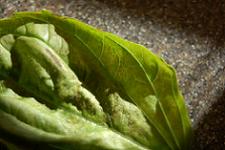 On Friday, Jan. 28, CTAHR extension agents identified the pathogen Basil Downy Mildew (BDM) (Peronospora belbahrii) as infecting basil at several farms in Wai‘anae. It has not yet been found anywhere else in Hawai‘i, and CTAHR is partnering with the Hawai‘i Department of Agriculture (HDOA) to fight back quickly before the disease gets a stronger foothold in the Islands. Basil is a $6.8M crop in Hawai‘i, and growers in some areas of the Mainland have lost their entire crop to this infectious and fast-spreading pathogen. BDM is characterized by black lesions on the lower leaves and black or purple-gray mildew growing on the underside of the leaves. The leaves then turn yellow and eventually become splotched with black or brown and die. The black spots on dying leaves may be mistaken for sunburn, but sunburned leaves lack the spores characteristic of BDM. The disease can be spread by infected seeds and by its numerous spores, which infest leave, soil, and seeds and can be dispersed great distances by the wind. Growers who have confirmed that their fields are infected with BDM should remove all infected leaves, including those that have fallen to the ground, and burn them. After infected leaves are removed, a fungicide should be applied to the new growth. Soil, tools, and equipment, including boxes, trucks, gloves, work clothes, benches, and anything else that could be infected, should be sanitized. Basil should also be grown so as to reduce leaf wetness and humidity, with enough space between the plants so that air can circulate freely among them and the use of drip irrigation. Dr. Janice Uchida (PEPS) has prepared a useful fact sheet about BDM. On Friday, Jan. 28, CTAHR extension agents identified the pathogen Basil Downy Mildew (BDM) (Peronospora belbahrii) as infecting basil at several farms in Wai‘anae. It has not yet been found anywhere else in Hawai‘i, and CTAHR is partnering with the Hawai‘i Department of Agriculture (HDOA) to fight back quickly before the disease gets a stronger foothold in the Islands. Basil is a $6.8M crop in Hawai‘i, and growers in some areas of the Mainland have lost their entire crop to this infectious and fast-spreading pathogen. BDM is characterized by black lesions on the lower leaves and black or purple-gray mildew growing on the underside of the leaves. The leaves then turn yellow and eventually become splotched with black or brown and die. The black spots on dying leaves may be mistaken for sunburn, but sunburned leaves lack the spores characteristic of BDM. The disease can be spread by infected seeds and by its numerous spores, which infest leave, soil, and seeds and can be dispersed great distances by the wind. Growers who have confirmed that their fields are infected with BDM should remove all infected leaves, including those that have fallen to the ground, and burn them. After infected leaves are removed, a fungicide should be applied to the new growth. Soil, tools, and equipment, including boxes, trucks, gloves, work clothes, benches, and anything else that could be infected, should be sanitized. Basil should also be grown so as to reduce leaf wetness and humidity, with enough space between the plants so that air can circulate freely among them and the use of drip irrigation. Dr. Janice Uchida (PEPS) has prepared a useful fact sheet about BDM.
|
Growing Energy
2/1/2011 Source: Office of Communication Services, CTAHR CTAHR was recently awarded $6M by the U.S. Department of Energy to increase Hawai‘i’s energy security by developing high-yielding tropical feedstocks that are economically viable and sustainable. Establishing local production of transportation fuels will reduce our dependency on imported fossil fuels and generation of greenhouse gases. Faculty from the departments of MBBE, NREM, TPSS and COF are involved in the project, along with partners Hawaii Natural Energy Institute, Hamakua Springs Water, and Hawaii Commercial & Sugar. Researchers will start by testing a variety of biochemical and thermochemical approaches to conversion—that’s the actual making of energy—to maximize the yield of biofuels and other valuable co-products. They’ll also look at which bioenergy crops are best at lowering the carbon dioxide in the atmosphere by trapping it in the soil. Finally, the project will study the economic, environmental, and community impacts of implementing a renewable energy system in a rural community. This information is expected to aid other communities in making decisions on investing in renewable energy. For more information, you can contact the principal investigator, Andrew Hashimoto, at aghashim@hawaii.edu.
|
January
Feel Like a Natural Farmer
1/24/2011 Source: Office of Communication Services, CTAHR 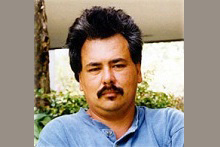 Michael DuPonte (HNFAS) (left) and Ted Radovich (TPSS) were recently featured in the Star-Advertiser discussing a controversial but promising farming technique. This is “natural farming” as propounded by South Korea’s Master Cho, who gave a workshop on O‘ahu last month and will be returning to the Big Island to give another in July. Michael, who is the technical adviser on a demonstration project involving a “smell-free” piggery in Kurtistown that uses the method, says that though he was dubious at first, it seems to be working well. He suggested that about 150 people are using similar natural farming techniques around Hilo. Ted, an assistant specialist with the Sustainable and Organic Farming Systems Laboratory, said that while it’s hard to find scientific proof that this version of natural farming works, “there is increasing interest in doing research. While I think there is potential, we’re quite a way from understanding how it works,” he added. “We’re not at the point where we can make recommendations yet.” Michael DuPonte (HNFAS) (left) and Ted Radovich (TPSS) were recently featured in the Star-Advertiser discussing a controversial but promising farming technique. This is “natural farming” as propounded by South Korea’s Master Cho, who gave a workshop on O‘ahu last month and will be returning to the Big Island to give another in July. Michael, who is the technical adviser on a demonstration project involving a “smell-free” piggery in Kurtistown that uses the method, says that though he was dubious at first, it seems to be working well. He suggested that about 150 people are using similar natural farming techniques around Hilo. Ted, an assistant specialist with the Sustainable and Organic Farming Systems Laboratory, said that while it’s hard to find scientific proof that this version of natural farming works, “there is increasing interest in doing research. While I think there is potential, we’re quite a way from understanding how it works,” he added. “We’re not at the point where we can make recommendations yet.”
|
But Does All That Texting Count as Exercise?
1/24/2011 Source: Office of Communication Services, CTAHR  This semester, HNFAS students will utilize text messaging to amass real-time data on how blood sugar levels at meal/snack times and perceptions of appetite and stress relate to weight change over a semester. Participants in the study, Project TwEATS II, will be asked to meet with researchers 2 to 3 times in person. Over the 7-day monitoring period, they will respond to hourly text messages about hunger and stress and keep a record of eating events, along with appetite, stress, and blood sugar levels. Participants could earn up to $75 for completing study-related tasks. Project TwEATs II is a continuation of the study initiated this past summer by a team of researchers, led by Susan Schembre of the UH Cancer Center, that used text messaging to collect real-time data on appetite from UHM undergraduates. To learn more about the study and to see if you’re eligible to participate, please take the survey here. This semester, HNFAS students will utilize text messaging to amass real-time data on how blood sugar levels at meal/snack times and perceptions of appetite and stress relate to weight change over a semester. Participants in the study, Project TwEATS II, will be asked to meet with researchers 2 to 3 times in person. Over the 7-day monitoring period, they will respond to hourly text messages about hunger and stress and keep a record of eating events, along with appetite, stress, and blood sugar levels. Participants could earn up to $75 for completing study-related tasks. Project TwEATs II is a continuation of the study initiated this past summer by a team of researchers, led by Susan Schembre of the UH Cancer Center, that used text messaging to collect real-time data on appetite from UHM undergraduates. To learn more about the study and to see if you’re eligible to participate, please take the survey here.
|
CTAHR Facelift
1/24/2011 Source: Office of Communication Services, CTAHR It has perhaps been apparent that Gilmore Hall is undergoing some renovations: The air conditioning system is getting reconditioned, the 2nd-floor west wing and 7th-floor roof deck are being re-roofed, and the Gilmore greenhouses are being waterproofed. We are glad to report that the replacement of the chiller plant and air handling plant has been completed. The new dual-system compressors will provide some safeguard against the failure of an individual compressor unit, as has happened in the past. Now testing and load balancing are underway. Some rooms may have restricted access due to exposed ceilings as we enter Phase II of the renovation process. Area 1-1 (Office Communication Services and Gilmore rooms 124 and 125) was completed Jan. 20. Area 2-1 (PMSO rooms 214 and 215, CTAHR server room and conference room 212 and 4-H room 213) started abatement Jan. 14, and with luck PMSO and Gilmore 212 will begin coming back into operations on Jan. 24. Area 1-2 (AETI, Ping-Yi Yang’s office and lab, and Gilmore rooms 102, 103, 105, 113, and 115A) started renovation Jan. 21. Updates will be posted at Gilmore elevator lobbies on each floor, and please be flexible in planning the use of Gilmore rooms. For Gilmore classroom changes, check with instructors for alternate locations. Also refer to the floor plans for the revised schedule of Phase II work, attached. The exteriors of Gilmore Hall and St. John Labs are scheduled to be painted in summer of 2012, by which time everything else should have calmed down.
|
Stream Re-Leaf Redux
1/24/2011 Source: Office of Communication Services, CTAHR 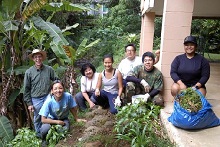 On Oct. 2, 30 students from the PEPS 210/NREM 210 class went to the Kolomono Ditch, a tributary that feeds into Manoa Stream, to remove weeds, plant native plants, and cover the area with compost. The project was coordinated by Iwalani Sato from the City and County Adopt-A-Stream Program. On Jan. 8, a smaller group of enthusiasts returned to the stream to weed and continue to improve the site. Barry Brennan and his wife Barbara are strong supporters of the project (the site is located next to their home), as are their neighbors, Glen and Natalie Taniguchi. Several students are interested in continuing this activity, and the next dates for stream cleaning/improvement are Feb. 12, Mar. 12, Apr. 9, and May 14. If you would like to become a member of the “CTAHR Stream Protectors,” please send an email to Janice Uchida at juchida@hawaii.edu or Barry Brennan at barryb@hawaii.edu. All are welcome to participate in these short, fun, but hardworking projects! On Oct. 2, 30 students from the PEPS 210/NREM 210 class went to the Kolomono Ditch, a tributary that feeds into Manoa Stream, to remove weeds, plant native plants, and cover the area with compost. The project was coordinated by Iwalani Sato from the City and County Adopt-A-Stream Program. On Jan. 8, a smaller group of enthusiasts returned to the stream to weed and continue to improve the site. Barry Brennan and his wife Barbara are strong supporters of the project (the site is located next to their home), as are their neighbors, Glen and Natalie Taniguchi. Several students are interested in continuing this activity, and the next dates for stream cleaning/improvement are Feb. 12, Mar. 12, Apr. 9, and May 14. If you would like to become a member of the “CTAHR Stream Protectors,” please send an email to Janice Uchida at juchida@hawaii.edu or Barry Brennan at barryb@hawaii.edu. All are welcome to participate in these short, fun, but hardworking projects!
|
Savings Milestone
1/24/2011 Source: Office of Communication Services, CTAHR  The Kids’ Savings Project, begun by Michael Cheang (FCS) in 2008, now includes 1,100 elementary school children (many from low-income families) saving for their future. The children have saved over $100,000 since the project’s inception. The project provides children with start-up funds—furnished by various community partners—to open the savings accounts and offers the convenience of depositing savings at school, the opportunity to save together with friends, and financial literacy workshops for parents. It also demonstrates how the university can help bridge the gap between research and practice and can get community partners to work together to provide opportunities for the children in our communities. While still in its developmental stages, the project has already documented significant and positive financial behavioral outcomes among children and their parents. It was showcased at a recent statewide Assets Building in Hawai‘i symposium and has attracted national attention—some regional research partners have shown interest in replicating the study. For more information, please contact Michael Cheang at cheang@hawaii.edu or at 956-2252, or check out the YouTube presentation created by two 3rd-grade teachers and their students. The Kids’ Savings Project, begun by Michael Cheang (FCS) in 2008, now includes 1,100 elementary school children (many from low-income families) saving for their future. The children have saved over $100,000 since the project’s inception. The project provides children with start-up funds—furnished by various community partners—to open the savings accounts and offers the convenience of depositing savings at school, the opportunity to save together with friends, and financial literacy workshops for parents. It also demonstrates how the university can help bridge the gap between research and practice and can get community partners to work together to provide opportunities for the children in our communities. While still in its developmental stages, the project has already documented significant and positive financial behavioral outcomes among children and their parents. It was showcased at a recent statewide Assets Building in Hawai‘i symposium and has attracted national attention—some regional research partners have shown interest in replicating the study. For more information, please contact Michael Cheang at cheang@hawaii.edu or at 956-2252, or check out the YouTube presentation created by two 3rd-grade teachers and their students.
|
Excellent Economics
1/17/2011 Source: Office of Communication Services, CTAHR  A Western Regional Team that includes Linda J. Cox (NREM) is developing the Community Business Matching (CBM) program that took first place in the “Excellence in Economic Development Research category” for a CBM pilot project at the University Economic Development Association’s Annual Summit in Reno, Nevada in late 2010. Along with Linda, the team included faculty from the University of Nevada at Reno; Montana State University; Western Rural Development Center, and the University of Arizona. The first pilot project completed by the team was awarded second place award for this category in 2008. This regional effort, after becoming a state finalist in Nevada, was also submitted by the Nevada Cooperative Extension Service for the Western Extension Director’s Award in 2010 and 2009. A Western Regional Team that includes Linda J. Cox (NREM) is developing the Community Business Matching (CBM) program that took first place in the “Excellence in Economic Development Research category” for a CBM pilot project at the University Economic Development Association’s Annual Summit in Reno, Nevada in late 2010. Along with Linda, the team included faculty from the University of Nevada at Reno; Montana State University; Western Rural Development Center, and the University of Arizona. The first pilot project completed by the team was awarded second place award for this category in 2008. This regional effort, after becoming a state finalist in Nevada, was also submitted by the Nevada Cooperative Extension Service for the Western Extension Director’s Award in 2010 and 2009.
|
Keep Your Pesticides Straight
1/17/2011 Source: Office of Communication Services, CTAHR Cathy Tarutani (PEPS) recently received a Gold Star award from ALSTAR, the Accepted Labels State Tracking and Repository. This system is a service of the National Pesticide Information Retrieval System (NPIRS). NPIRS is a family of pesticide-related databases, applications, and Web sites. Pesticide labels are documents that determine how a pesticide product may be legally used in the U.S. EPA does not register pesticide products exactly as they are marketed; marketplace labels are approved by the individual states. Therefore, a database of marketplace pesticide labels is not available via NPIRS. Pesticide stakeholders; pest managers; their supporters, such as county extension agents; and others have a great need for such a database, and in 2004 NPIRS first began establishing and maintaining a national repository of state-registered pesticide labels. This evolved to become ALSTAR. Cathy has been with CTAHR since 1982 and is responsible for maintaining the Hawai‘i Pesticide Information Retrieval System. The NPIRS database facilities are available to subscribers for an annual fee, but NPIRS offers a limited search capability to the state pesticide product databases for free.
|
Children’s Health on PBS Hawaii
1/17/2011 Source: Office of Communication Services, CTAHR  Barbara DeBaryshe (COF) will be featured on Insights on PBS Hawaii, along with Lynnae Sauvage, Elizabeth McFarlane, and Neal Palafox, in a one-hour discussion on the status of children’s health in Hawai‘i and the insights afforded by the National Children’s Study. The program will air on Jan. 20 at 7:30 p.m. on Oceanic Cable Channel 10. The National Children’s Study is the largest long-term study of children’s health ever done in the United States and will include 100,000 children from before birth to age 21. It will look at how children’s health is affected by a number of factors, including their family health history and the places they live, learn, and play. Barbara DeBaryshe (COF) will be featured on Insights on PBS Hawaii, along with Lynnae Sauvage, Elizabeth McFarlane, and Neal Palafox, in a one-hour discussion on the status of children’s health in Hawai‘i and the insights afforded by the National Children’s Study. The program will air on Jan. 20 at 7:30 p.m. on Oceanic Cable Channel 10. The National Children’s Study is the largest long-term study of children’s health ever done in the United States and will include 100,000 children from before birth to age 21. It will look at how children’s health is affected by a number of factors, including their family health history and the places they live, learn, and play.
|
Sustaining the Growth
1/17/2011 Source: Office of Communication Services, CTAHR  Interim Dean Sylvia Yuen gave a presentation on Sustainable Agricultural Systems: Challenges and Opportunities at E Makani Noi’i, Innovation for Hawai’i’s Growth, a symposium organized by the U.S. National Academy of Sciences and the University of Hawai‘i. National and community leaders met on Jan. 13-14 to discuss Hawai‘i’s innovation economy. Senators Daniel K. Inouye and Daniel K. Akaka presented opening remarks, Governor Neil Abercrombie gave a luncheon address, and Representatives Colleen Hanabusa and Mazie Hirono participated in a roundtable discussion. Other speakers included key federal officials; administrators from Stanford, UC-San Diego, UH, and other universities; and prominent business leaders. Interim Dean Sylvia Yuen gave a presentation on Sustainable Agricultural Systems: Challenges and Opportunities at E Makani Noi’i, Innovation for Hawai’i’s Growth, a symposium organized by the U.S. National Academy of Sciences and the University of Hawai‘i. National and community leaders met on Jan. 13-14 to discuss Hawai‘i’s innovation economy. Senators Daniel K. Inouye and Daniel K. Akaka presented opening remarks, Governor Neil Abercrombie gave a luncheon address, and Representatives Colleen Hanabusa and Mazie Hirono participated in a roundtable discussion. Other speakers included key federal officials; administrators from Stanford, UC-San Diego, UH, and other universities; and prominent business leaders.
|
CBB Even Harder to Manage in Hawai‘i
1/10/2011 Source: Office of Communication Services, CTAHR 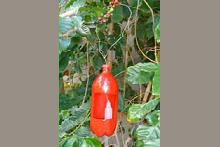 We know everything’s a little bit different in Hawai‘i…and most of the time, we revel in that difference. However, when it comes to dealing with the Coffee Berry Borer, we’re discovering that some of the ways Hawai‘i is different are causing problems for coffee farmers. A Kona farmer who said his latest crop was “devastated” pointed out recently that the most effective way of controlling the pests in other parts of the world, collecting and destroying all cherries in which they might be hiding, doesn’t work so well on lava rock: “We live in a lava field, and when an infested cherry falls to the ground in the lava, it is like looking for a needle in a haystack.” CTAHR researchers are investigating improved methods to recover those infested cherries, such as some type of vacuum. Traps are useful for figuring out if there are beetles in the area, and it’s possible that they might also help to reduce the beetles’ numbers—a concept that CTAHR’s CBB researchers plan to test. In the meantime, to help with locating the borers, researcher Elsie Burbano has published instructions for making your own trap on the CTAHR Web site. We know everything’s a little bit different in Hawai‘i…and most of the time, we revel in that difference. However, when it comes to dealing with the Coffee Berry Borer, we’re discovering that some of the ways Hawai‘i is different are causing problems for coffee farmers. A Kona farmer who said his latest crop was “devastated” pointed out recently that the most effective way of controlling the pests in other parts of the world, collecting and destroying all cherries in which they might be hiding, doesn’t work so well on lava rock: “We live in a lava field, and when an infested cherry falls to the ground in the lava, it is like looking for a needle in a haystack.” CTAHR researchers are investigating improved methods to recover those infested cherries, such as some type of vacuum. Traps are useful for figuring out if there are beetles in the area, and it’s possible that they might also help to reduce the beetles’ numbers—a concept that CTAHR’s CBB researchers plan to test. In the meantime, to help with locating the borers, researcher Elsie Burbano has published instructions for making your own trap on the CTAHR Web site.
|
Weimar Chic
1/10/2011 Source: Office of Communication Services, CTAHR  Andy Reilly (FCS) will be teaching the APDM course “Fashion in 20th-Century Germany” at Freie University in Berlin, Germany this summer through the UH Study Abroad Program. Specific topics covered include fashion as entertainment in the Weimar Republic, the role of the fashionable woman in Nazi Germany, clothing and political ideology in East Germany, hate couture in today’s society, and tattoos and the Jewish body. Andy Reilly (FCS) will be teaching the APDM course “Fashion in 20th-Century Germany” at Freie University in Berlin, Germany this summer through the UH Study Abroad Program. Specific topics covered include fashion as entertainment in the Weimar Republic, the role of the fashionable woman in Nazi Germany, clothing and political ideology in East Germany, hate couture in today’s society, and tattoos and the Jewish body.
|
Welcome Back!
1/10/2011 Source: Office of Communication Services, CTAHR 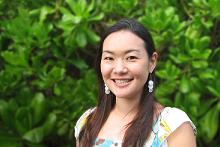 Visitors to CTAHR’s Academic and Student Affairs Office in Gilmore Hall will see a new—but maybe familiar—face. On Jan. 5, Lisa Kitagawa-Akagi joined the college as CTAHR’s new Student Services Specialist, taking over for Allene Chun, who admirably filled position for nearly 30 years. Lisa, a Family Resources alumna with an advanced degree in Higher Education Administration, served as Student Intern and Graduate Assistant, then Instructional and Student Support Specialist, in CTAHR’s Academic and Student Affairs Office before taking a position as Associate Director of Student Involvement and Leadership Development, and Coordinator of New Student Programs in Manoa’s Office of Student Life and Development in 2006. We’re excited that Lisa has returned to CTAHR to help our students gain the best learning experience possible. Lisa is equally pleased about “returning home to CTAHR and being able to give back to the college that gave me so much as a student and as a professional.” Visitors to CTAHR’s Academic and Student Affairs Office in Gilmore Hall will see a new—but maybe familiar—face. On Jan. 5, Lisa Kitagawa-Akagi joined the college as CTAHR’s new Student Services Specialist, taking over for Allene Chun, who admirably filled position for nearly 30 years. Lisa, a Family Resources alumna with an advanced degree in Higher Education Administration, served as Student Intern and Graduate Assistant, then Instructional and Student Support Specialist, in CTAHR’s Academic and Student Affairs Office before taking a position as Associate Director of Student Involvement and Leadership Development, and Coordinator of New Student Programs in Manoa’s Office of Student Life and Development in 2006. We’re excited that Lisa has returned to CTAHR to help our students gain the best learning experience possible. Lisa is equally pleased about “returning home to CTAHR and being able to give back to the college that gave me so much as a student and as a professional.”
|
Engage in Extreme Exertion in the Desert—Check!
1/3/2011 Source: Office of Communication Services, CTAHR 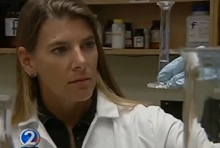 Congratulations to Ashley Stokes (HNFAS, Extension veterinarian) for recently completing the Ford Arizona Ironman Triathlon in Tempe, AZ. The event included a 2.4-mile swim in Tempe Town Lake, a 112-mile bike ride in the Sonoran Desert, and a 26.2-mile run. She says that she wanted to tick this one off her “bucket list.” We can only wonder what else is on that list! Congratulations to Ashley Stokes (HNFAS, Extension veterinarian) for recently completing the Ford Arizona Ironman Triathlon in Tempe, AZ. The event included a 2.4-mile swim in Tempe Town Lake, a 112-mile bike ride in the Sonoran Desert, and a 26.2-mile run. She says that she wanted to tick this one off her “bucket list.” We can only wonder what else is on that list!
|
Helping Plants Help Themselves
1/3/2011 Source: Office of Communication Services, CTAHR  Nematodes, or parasitic roundworms, are apparently as addicted to coffee as the rest of us, but it’s the roots of the plants they like, not the final brew. Enter Don Schmitt (PEPS, Emeritus), who was instrumental in the development and deployment of the ‘Fukunaga’ rootstock, which is resistant to the Kona coffee root-knot nematode and is now widely used by Kona coffee growers. Growing plants that help themselves also helps the growers—less hassle, fewer losses, more money saved—and the ‘aina—fewer pesticides. Don also served as the chair of the Plant Pathology Department (now PEPS). After leaving CTAHR in 2003, Don went on to redefine “retirement”: He moved to North Carolina and now operates a 600-acre farm that grows corn, soybeans, and wheat. His wife and daughter manage a flower and gift shop, where Don helps out when he's not farming—or enjoying nature in its natural state. He writes that in addition to his acres under cultivation, he has “about 100 acres of unmanaged forest, which is great for wildlife (deer, squirrels, raccoons, rabbits, and a wide array of birds).” And possibly even nematodes. Nematodes, or parasitic roundworms, are apparently as addicted to coffee as the rest of us, but it’s the roots of the plants they like, not the final brew. Enter Don Schmitt (PEPS, Emeritus), who was instrumental in the development and deployment of the ‘Fukunaga’ rootstock, which is resistant to the Kona coffee root-knot nematode and is now widely used by Kona coffee growers. Growing plants that help themselves also helps the growers—less hassle, fewer losses, more money saved—and the ‘aina—fewer pesticides. Don also served as the chair of the Plant Pathology Department (now PEPS). After leaving CTAHR in 2003, Don went on to redefine “retirement”: He moved to North Carolina and now operates a 600-acre farm that grows corn, soybeans, and wheat. His wife and daughter manage a flower and gift shop, where Don helps out when he's not farming—or enjoying nature in its natural state. He writes that in addition to his acres under cultivation, he has “about 100 acres of unmanaged forest, which is great for wildlife (deer, squirrels, raccoons, rabbits, and a wide array of birds).” And possibly even nematodes.
|
Radical Lettuce
1/3/2011 Source: Office of Communication Services, CTAHR  “Thank you for accepting my sometimes radical ideas,” writes Bernie Kratky (TPSS, Emeritus) on the occasion of his retirement after 39½ years with CTAHR. These include explorations of growing crops in protected culture, experiments in plasticulture (that’s the use of plastics in agriculture), and non-circulating hydroponic growing methods. Having begun his research on a Wisconsin dairy farm, he studied throughout the world, including in China and Australia, and brought that experience to a Hawai‘i setting. Bernie notes with pride the Hawai‘i farms using his techniques, such as Prime Kine Lettuce Farm in Hilo, which has been growing lettuce since 1993 based upon his team’s hydroponics research. He predicts retirement will be very similar to his working life: more papers, more projects, more radical ideas to help local farmers grow. “Thank you for accepting my sometimes radical ideas,” writes Bernie Kratky (TPSS, Emeritus) on the occasion of his retirement after 39½ years with CTAHR. These include explorations of growing crops in protected culture, experiments in plasticulture (that’s the use of plastics in agriculture), and non-circulating hydroponic growing methods. Having begun his research on a Wisconsin dairy farm, he studied throughout the world, including in China and Australia, and brought that experience to a Hawai‘i setting. Bernie notes with pride the Hawai‘i farms using his techniques, such as Prime Kine Lettuce Farm in Hilo, which has been growing lettuce since 1993 based upon his team’s hydroponics research. He predicts retirement will be very similar to his working life: more papers, more projects, more radical ideas to help local farmers grow.
|
Progressive Agriculture
1/3/2011 Source: Office of Communication Services, CTAHR 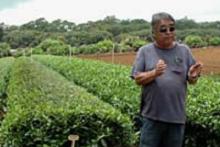 Agriculturist Milton Yamasaki will honored at the 18th Annual Waimea Cherry Blossom Heritage Festival on Feb. 5. Milton retired last fall as long-time manager of CTAHR’s Mealani Research Station, where he oversaw operations at five Big Island research sites. Milton helped to initiate the development of several healthy food systems crops, such as 100-percent grass-fed beef, green tea, and blueberries. He was named Governor’s Award Honoree for Distinguished State Service at UH in 2007 and also earned UH’s Dean’s Award from CTAHR and the Chancellor’s Award for Outstanding Civil Service Employee at UH-Manoa. Milton helped to introduce annual Forage Field Days to educate ranchers on grass-finishing beef and was also involved in founding Mealani’s Taste of the Hawaiian Range, which showcases how great that beef can taste. Milton is focused on progressive methods: “I’m happy that in recent years we have started to lead the industry by developing new products and methods, instead of just solving current problems,” he says. The Waimea Cherry Blossom Heritage Festival (9 a.m. to 3 p.m. on Saturday) will offer a wide range of activities, including Japanese and multicultural performing arts, plus demonstrations of bonsai, origami, tea ceremony, quilting and mochi pounding, as well as crafts for sale. For more information, please call (808) 961-8706. Agriculturist Milton Yamasaki will honored at the 18th Annual Waimea Cherry Blossom Heritage Festival on Feb. 5. Milton retired last fall as long-time manager of CTAHR’s Mealani Research Station, where he oversaw operations at five Big Island research sites. Milton helped to initiate the development of several healthy food systems crops, such as 100-percent grass-fed beef, green tea, and blueberries. He was named Governor’s Award Honoree for Distinguished State Service at UH in 2007 and also earned UH’s Dean’s Award from CTAHR and the Chancellor’s Award for Outstanding Civil Service Employee at UH-Manoa. Milton helped to introduce annual Forage Field Days to educate ranchers on grass-finishing beef and was also involved in founding Mealani’s Taste of the Hawaiian Range, which showcases how great that beef can taste. Milton is focused on progressive methods: “I’m happy that in recent years we have started to lead the industry by developing new products and methods, instead of just solving current problems,” he says. The Waimea Cherry Blossom Heritage Festival (9 a.m. to 3 p.m. on Saturday) will offer a wide range of activities, including Japanese and multicultural performing arts, plus demonstrations of bonsai, origami, tea ceremony, quilting and mochi pounding, as well as crafts for sale. For more information, please call (808) 961-8706.
|
Like Buy One Plant?
1/3/2011 Source: Office of Communication Services, CTAHR  TPSS students held a successful 3-day plant sale at the Campus Center as part of their TPSS 430 Nursery Management class. The course approach has been revised by professor Kheng Cheah to provide a deeper understanding of what is involved in becoming a nursery manager or owner or an employee of a large agribusiness, as well as to develop practical skills needed in the next generation of Hawai‘i’s nursery managers and owners. The emphasis is on the strategic thinking behind setting up a nursery business and on modern applied business management principles. The class includes broad integrative experiences, from choosing nursery business models to strategizing production, financial, and marketing plans to actually selling plants as a way to test the students' business models and products. Participatory learning techniques such as teamwork and collaboration—and plant sales—are essential in this class. TPSS students held a successful 3-day plant sale at the Campus Center as part of their TPSS 430 Nursery Management class. The course approach has been revised by professor Kheng Cheah to provide a deeper understanding of what is involved in becoming a nursery manager or owner or an employee of a large agribusiness, as well as to develop practical skills needed in the next generation of Hawai‘i’s nursery managers and owners. The emphasis is on the strategic thinking behind setting up a nursery business and on modern applied business management principles. The class includes broad integrative experiences, from choosing nursery business models to strategizing production, financial, and marketing plans to actually selling plants as a way to test the students' business models and products. Participatory learning techniques such as teamwork and collaboration—and plant sales—are essential in this class.
|
Growing the Bones
1/3/2011 Source: Office of Communication Services, CTAHR  Molecular biologist Jinzeng Yang (HNFAS) is the leader of a research team that recently developed innovative techniques that could have profound effects on research into congenital cervical vertebrae malformation. The cover-featured article of the Nov. issue of Molecular Reproduction and Development, “Transgenic Over-Expression of Growth Differentiation Factor 11 Propeptide in Skeleton Results in Transformation of the Seventh Cervical Vertebra into a Thoracic Vertebra,” describes how researchers looked into congenital cervical vertebrae malformation in humans that can cause neural problems and increase susceptibility to stillbirth in women. Research on abnormal vertebrae development has previously been limited due to the lack of lab animals that are close enough to humans to provide useful information, but researchers from Yang’s laboratory have developed a new mouse model that reveals how patterning and developmental proteins can influence cervical vertebrae formation. The model uses a gene-suppression technique that induces skeletal formation, creating mice that appear normal but have striking cervical vertebrae formation. Yang's new gene-suppression technique offers benefits over the previously used “knockout mice” created by complete gene removal, which die shortly after birth. Molecular biologist Jinzeng Yang (HNFAS) is the leader of a research team that recently developed innovative techniques that could have profound effects on research into congenital cervical vertebrae malformation. The cover-featured article of the Nov. issue of Molecular Reproduction and Development, “Transgenic Over-Expression of Growth Differentiation Factor 11 Propeptide in Skeleton Results in Transformation of the Seventh Cervical Vertebra into a Thoracic Vertebra,” describes how researchers looked into congenital cervical vertebrae malformation in humans that can cause neural problems and increase susceptibility to stillbirth in women. Research on abnormal vertebrae development has previously been limited due to the lack of lab animals that are close enough to humans to provide useful information, but researchers from Yang’s laboratory have developed a new mouse model that reveals how patterning and developmental proteins can influence cervical vertebrae formation. The model uses a gene-suppression technique that induces skeletal formation, creating mice that appear normal but have striking cervical vertebrae formation. Yang's new gene-suppression technique offers benefits over the previously used “knockout mice” created by complete gene removal, which die shortly after birth.
|
Dean's Message
1/3/2011 Source: Office of Communication Services, CTAHR  Happy New Year! Now that I’ve got a semester as Interim Dean of CTAHR under my belt and have weathered the transition period, I’m looking forward to an exciting Spring semester, when I’ll see some new ideas come to fruition. That’s one of the things I am loving most about this position, envisioning potential and working to bring it to reality. In this edition of Alumni & Friends, we look back on the groundbreaking work that now-retired members of the CTAHR ‘ohana have done over the years and celebrate the strides forward that present faculty, staff, and students are making—and gain fresh inspiration for our own efforts. For instance, now we take hydroponics for granted, but remember when the idea of growing vegetables in nothing but water would have sounded bizarre, to say the least? How about the conventional wisdom that grain-fed beef is always tastier than grass-fed? Now we have gustatory evidence that’s just not so. And what about the idea that plants can contribute to their own defense against pests? Doesn’t it make more sense to grow varieties that are resistant to what’s eating them so we can reduce the use of pesticides? What other ideas do we take for granted that someday soon a CTAHR researcher will be turning upside down? In this new year, let’s all try to expand the possibilities we see—to become, each in our own way, visionaries for change. Happy New Year! Now that I’ve got a semester as Interim Dean of CTAHR under my belt and have weathered the transition period, I’m looking forward to an exciting Spring semester, when I’ll see some new ideas come to fruition. That’s one of the things I am loving most about this position, envisioning potential and working to bring it to reality. In this edition of Alumni & Friends, we look back on the groundbreaking work that now-retired members of the CTAHR ‘ohana have done over the years and celebrate the strides forward that present faculty, staff, and students are making—and gain fresh inspiration for our own efforts. For instance, now we take hydroponics for granted, but remember when the idea of growing vegetables in nothing but water would have sounded bizarre, to say the least? How about the conventional wisdom that grain-fed beef is always tastier than grass-fed? Now we have gustatory evidence that’s just not so. And what about the idea that plants can contribute to their own defense against pests? Doesn’t it make more sense to grow varieties that are resistant to what’s eating them so we can reduce the use of pesticides? What other ideas do we take for granted that someday soon a CTAHR researcher will be turning upside down? In this new year, let’s all try to expand the possibilities we see—to become, each in our own way, visionaries for change.
|